Eragon (PG)

Starring: Ed Speleers
December 2006
“Medieval Mediocrity Has a New Name”
The best word one could use to describe Eragon, the new fantasy film based on the novel of the same name by Christopher Paolini, is “conventions.” Not sci-fi conventions, mind you, but story conventions. The entire movie is laden with leaden contrivances and borrows heavily from Star Wars (farm boy seeks adventure and is mentored by a seasoned sage), Batman Begins (training sessions), The Beastmaster (conversing with animals), Dragonheart (dragon) and, of course, The Lord of the Rings trilogy (too many to list here).
However, even though Eragon sounds too similar to LOTR’s Aragorn, the movie has carved out its own unique niche within the fantasy genre and comes complete with its own geeky glossary: Alagaesia (mythical realm), the Varden (aboriginal warriors lead by Djimon Hounsou), Urgals (wildmen) and the Ra’zac (orcs composed of worms), to name just a few.
Eragon (Edward Speleers), a callow country peasant, stumbles upon a watermelon-shaped dragon egg in the forest. Once hatched, the dragon grows at an alarming rate and, upon reaching adulthood, uses its telepathic powers to communicate with Eragon (the dragon, Saphira, is voiced by Rachel Weisz). Former Dragon Rider, Brom (Jeremy Irons), takes Eragon under his wing and trains the youth in combat and dragon piloting. After earning his stripes, Eragon struggles to stay one step ahead of the Ra’zac on his mission to rescue Princess Arya (Sienna Guillory). Along the way, the lad is also pursued by the scar-faced Durza (Robert Carlyle), who serves as the creepy henchman for the sinister overlord, King Galbatorix (John Malkovich).
Speleers tries his hardest to fulfill the movie’s need for a Luke Skywalker archetype, but he doesn’t show much range at this early juncture in his acting career. Irons, who’s no stranger to the genre, slips into the Obi Wan role with ease, but, unfortunately, is as wooden as his quarterstaff. Brom mirthlessly trains the teen with an austere earnestness that would break his face should he ever smile…which he doesn’t. Irons’ The Man with the Iron Mask co-star, Malkovich, is underserved as the villain and comes off a bit melodramatic, what with his legato speech and scowling affectation.
Though surprisingly dark at times (for a PG-rated family film), Eragon is mildly diverting, yet still falls far short of the epic fantasy benchmark. As with most fantasy novels, there are other books in the series that could become sequels if this first film brings in enough denarii’s. Who knows, if Eragon spawns a series of films, its costumes might be donned by fans at sci-fi/fantasy gatherings. That would be so conventional!
Rating: 2 1/2
Charlotte’s Web (G)
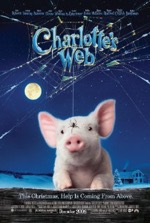
Starring: Dakota Fanning
December 2006
“Delightful Tale Affirms the Miracle of Friendship”
According to Greek mythology, King Midas could transform anything into gold simply by touching it. Precocious twelve-year old actress, Dakota Fanning can do the same with movies. Don’t believe it? Name one Fanning film that was a flop. It certainly isn’t her latest project, the wistfully dreamy live-action version of E.B. White’s classic children’s book, Charlotte’s Web.
In the movie Fanning plays Fern, a prepubescent powerhouse whose deep personal convictions drives her to defend a runty pig from being slaughtered. Raising the pig on her own, Fern names the undersized porker Wilbur (voiced with the perfect degree of childlike innocence by Minority Report’s Dominic Scott Kay). Fern and Wilbur are inseparable during the long, lazy summer months, but with the onset of fall, Fern is forced to sell the pig to the neighbors after an ill-fated attempt to conceal the pig in her school desk lands her in trouble with teacher and parents.
The neighbor’s barn is filled with talking animals whose personalities are as diverse and colorful as a rainbow. Separated from Fern, Wilbur tries making friends with his stall mates; the leader of three aimless sheep (John Cleese), two quarreling geese (Oprah Winfrey and Cedric the Entertainer), a pair of gossipy cows (Kathy Bates and Reba McEntire), two cowardly crows (Thomas Hayden Church and Andre Benjamin, who provide intermittent comic relief a la Skrit in Ice Age), a skittish horse (Robert Redford) and a selfish, hoarding rat named Templeton (Steve Buscemi), but none of the animals seem overly eager to make Wilbur’s acquaintance. In the throes of loneliness, Wilbur finally finds a friend; gracefully descending from a silken thread, the wise and compassionate arachnid, Charlotte, introduces herself to the pig. When the other animals taunt Wilbur, calling him a “future football,” Charlotte promises the innocent spring pig that he’ll live long enough to see winter’s first snow. How Charlotte and the other animals accomplish that feat is, as Paul Harvey would say, the rest of the story.
I’m ashamed to admit that I never read Charlotte’s Web as a youth and only remember snippets of the animated film released in 1973. Expecting something far more pedestrian, I was pleasantly surprised by a genuinely human story that reinforces the immutable virtues of friendship, courage and selflessness.
Fanning’s contribution to the film cannot be overstated, but equally vital are the pitch-perfect vocal deliveries by the entire cast, with highlights provided by Kay, Buscemi and Roberts. Roberts brings elegance and compassion to, arguably, the most loathed creature on the planet; Charlotte’s appeal is further enhanced by the CGI artists who make Charlotte’s face appear more sympathetic and less sinister than a real-world spider. Though Wilbur is the central character, the story is called Charlotte’s Web, and a large part of the movie’s success is due to Roberts’ affectionately soothing vocal performance that puts the spot in spot-on.
Charlotte’s Web is some movie; a delightful escape to a younger, simpler age, when summers were eternal and having adventures in a nearby wood was a full-time job. Director Gary Winick has paid faithful tribute to E.B. White’s book, while also delivering one fine piece of cinema. From the casting to the acting and from the talent in front of the camera to the wizards frantically working behind the scenes (especially on the breathtaking web-weaving sequences), every element of Charlotte’s Web is painstakingly and lovingly crafted...passion for the project and reverence for the source material is evident in every frame. This is one humble pig that deserves to take a bow.
Rating: 3
The Holiday (PG-13)

Starring: Kate Winslet
December 2006
“Emotionally Satisfying Rom-Com Delivers Seasonal Cheer”
Iris (Kate Winslet), a columnist living in England, gives her ex-boyfriend Jasper (Rufus Sewell) a present but he fails to reciprocate, barely acknowledging her existence at an office Christmas party. Though recently engaged to another woman, Jasper still professes his love for Iris. For obvious reasons, Jasper wants to keep Iris on the hook. Though she despises his philandering ways, Iris is utterly blind to her emotional dependence upon Jasper and holds on to a desperate hope of getting back together with him. Exasperated, Iris comes to the conclusion that she needs a break from her life.
Amanda (Cameron Diaz) is a self-assured movie trailer editor, who lives in L.A. After breaking up with her pigheaded boyfriend (Edward Burns), Amanda just wants to leave her troubles behind for a while. While searching for vacation destinations online, Amanda discovers a house swap option that gets her wheels turning. After an extensive IM conversation, Amanda and Iris agree to swap houses for the holidays.
If that oversimplified plot outline didn’t grab you, I urge you to disregard my Jack and Jill synopsis and give The Holiday a chance to warm your heart with its sincere performances, emotionally complex story and astounding direction by Nancy Meyers (The Parent Trap). Meyers is a master at gradually layering characters’ emotions which yield intense payoffs later in the film. She can even achieve such satisfying results with shallow characterizations such as Sewell’s unrepentant boor. Despite the occasional schmaltzy scene or line of dialog, the film is deeply moving in ways more subtle than obvious.
You would naturally and justifiably expect a lot out of a cast including Diaz, Winslet, Jack Black and Jude Law, and they all live up to their billing, especially Black, who turns in his most endearing performance as a movie composer…very few actors could’ve pulled off the “accidental boob graze” scene with as much charm. Additionally, the scene where Miles (Black) serenades Iris in a video store is an instant classic (keep an eye out for a Hollywood mega-star, who gets one of the biggest laughs in the film).
What puts it over the top for me is a subplot focusing on Iris’ serendipitous friendship with a retired motion picture screenwriter named Arthur Abbott (Eli Wallach). Abbott’s commentary on the current state of Hollywood, in light of its glorious past, is a fascinating aside that Meyers didn’t have to include, as it has very little bearing on the overall story. The fact that Meyers took the time to develop this storyline, along with all of the leading characters, is what differentiates this project from the run-of-the-mill rom-coms that seem to pop up like weeds at the Cineplex these days. Meyers’ screenplay has some meat, some meaning, along with healthy doses of comedy and romance.
Words sometimes fail when attempting to describe The Holiday because it’s a movie that has to be experienced, not merely discussed. There’s a lot of movie magic here, which hopefully will translate into generous box office. With instant name recognition and A-list headliners, here’s hoping The Holiday will be cherished as a seasonal favorite for many years to come. For those who appreciate intuitive direction, believable performances and organic writing, Christmas has come early this year.
Rating: 3 1/2
Deja Vu (PG-13)

Starring: Denzel Washington
November 2006
“The Feeling That You’ve Seen This Plot Before”
In 2001, the Oscar for Best Actor went to Denzel Washington for his portrayal of a crooked cop in Training Day. With an Oscar in one hand and an ever-growing list of box-office hits in the other, one wonders why Denzel settled for the diverting, yet middling love story, Déjà Vu, which co-stars Val Kilmer, Jim Caviezel and the comely Paula Patton (Hitch).
The movie opens with a domestic terrorist attack on a ferryboat in a New Orleans harbor (hasn’t the city already suffered enough?). Detail-retentive ATF agent, Doug Carlin (Washington), responds to the disaster and takes on the challenge of solving the mystery surrounding the death of Claire (Patton), a young, attractive woman who washed up onshore two hours before the bombing with burn marks and chemical traces consistent with the other ferryboat victims. A visit to Claire’s house reveals even more time incongruities: Having never met Claire, Doug is startled when he plays back a voicemail message he left on Claire’s answer machine. Doug also discovers a cryptic admonition spelled out in alphabet magnets on Claire’s refrigerator door, “U can save her.”
The story takes a sci-fi twist when Agent Pryzwarra (Kilmer) invites Doug to join his special team of techno-geeks, who employ state-of-the-art technology to play back events from the recent past. At first, Doug is awed by the hi-tech equipment, but ongoing timeline discrepancies drive him toward disturbing revelations about Claire, whom he’s rapidly falling in love with, and his Geek Squad cronies.
The main bane of most time travel stories is a flawed or confusing paradox, and Déjà Vu, unfortunately, suffers the effects of this narrative nemesis. This Jerry Bruckheimer produced, Tony Scott directed film had all the potential to be a first-rate thriller, but it suffers from scientific inconsistencies and plot holes big enough to drive an ambulance through. From a dramatic standpoint, the movie’s elegant wrap-up is effective and maybe even a tad heartwarming, but the film leaves its audience with the nagging feeling that they’ve fallen victim to cinematic prestidigitation. Even with the Temporal Mechanics for Dummies seminar at the movie’s midpoint, the convoluted plot—which plays fast and loose with the very theories it espouses—fails to deliver the stand-and-applaud climax the writers were clearly anticipating.
The only groundbreaking concept in the movie is the scene where Doug tracks the killer to his hideout with the help of a goggle rig that transmits images from four days earlier, before the bombing took place. The high-speed pursuit—where Doug keeps one eye on the past and one eye on the road—is, arguably, the most memorable sequence in the film, but it’s all so much visual Teflon…hollow thrills that are quickly forgotten once the movie fades to black.
Washington does his usual good job as the unimpeachable agent and Caviezel plays an adequate cold-blooded killer, but both characters are severely underserved, particularly Caviezel’s Oerstadt. We witness Oerstadt’s bloodletting, but we don’t know anything about him or what motivates him to commit such heinous acts. Oerstadt, a washed-out military man, does issue one spine-tingling line however, “One man’s terrorist is another man’s patriot.” As for the other actors, Kilmer is mere set dressing and Patton does solid work in a limited role.
Déjà Vu would have been a runaway success if not for the muddy cause and effect plot which bogs down a story that otherwise would have been immensely enjoyable. It’s just too bad the writers couldn’t use the movie’s technology to go back in time and fix some of their mistakes…and fix some of their mistakes.
Rating: 2 1/2
Deck the Halls (PG)

Starring: Matthew Broderick
November 2006
“Fa, la, la, la, la…ha, ha, ha, ha!”
Holiday movies focusing on feuding families/neighbors are a dime a dozen and are generally worth about the same amount. These films usually fall into one of two categories: 1. Neighbors attempt to outdo each other in decorating their houses, or 2. Visiting relatives disrupt the status quo, putting family members at each other’s throats until someone shouts above the din and reminds everyone about the true meaning of Christmas. Although Deck the Halls, starring Danny DeVito and Matthew Broderick, has elements of both scenarios, the movie contains just enough originality to break free from the cookie-cutter rigidity of such Holiday rejects as Jingle All the Way and the Home Alone sequels.
Steve Finch (Broderick), a mild-mannered optometrist, is the Winter Fest coordinator and is known about town as “Mr. Christmas.” His title and reputation are immediately challenged when Buddy Hall (DeVito) makes a late night move into the house across the street (“Who moves in the middle of the night,” Steve asks his barely conscious wife, “a meth lab?”). Buddy, a struggling car salesman who rapidly looses interest in any new experience, has fallen into the pattern of moving from place to place, job to job and obsession to obsession. Despite Buddy’s repeated attempts at finding a lasting happiness, fulfillment in life continues to elude him. Buddy confesses to his wife that he’s always wanted to “do something big…something monumental.” Buddy’s impetus comes when his two Barbie doll daughters introduce him to a computer program that can pinpoint every house on the planet from space…every house, of course, except for theirs. Buddy’s new ambition is to make his house bright enough to be seen from outer space.
Threatened by Buddy’s instant popularity (people are coming from miles around to see Buddy’s extravagant light show), Steve does everything in his power to prevent Buddy from seeing his dream come to fruition, including sabotaging Buddy’s display by throwing a snowball at the exterior circuit panel. However, Steve fails to account for Buddy’s backup generator, which kicks in a short time later and brings the thousands of scintillating light bulbs back to life. When Buddy discovers Steve’s perfectly placed snowball and when Steve discovers that Buddy has been stealing power from his house, the gloves come off and both men engage in a war of subversion and chicanery. Fed up with Steve and Buddy’s petty rivalry, Steve’s wife Kelly (Kristin Davis) and Buddy’s wife Tia (Kristin Chenoweth) both pack up and head for a hotel. Faced with a life-altering decision, Steve and Buddy must either choose to sober up and make amends or continue with their childish quarreling and risk loosing everything they hold dear.
A cursory character study reveals Steve as a tradition-bound stiff who just wants peace and quiet, and Buddy as a conniving, obnoxious glory-hog who just wants to be noticed. Together, the characters, and the actors who portray them, create a unique brand of contentiousness that recalls, but certainly doesn’t supersede, Matthau and Lemmon’s incisive bickering in such movies as Grumpy Old Men. The leads have excellent chemistry together; DeVito is his usual zany self, but Broderick’s dead-pan delivery is sidesplittingly hilarious. Both Kristin’s do excellent work as the disgruntled wives, and I’m gratified that director, John Whitesell, put Chenoweth’s considerable vocal talents to good use on “Oh, Holy Night.”
Though it’s not as humorous as A Christmas Story or as heart-warming as Miracle on 34th Street, Deck the Halls is a diverting popcorn flick and is a worthy entry into the vast catalog of feel-good Holiday treats. With this, yet another film that was named after a Christmas song, one wonders when we’ll see the movie version of “Grandma Got Run Over by a Reindeer.”
Rating: 2
Happy Feet (PG)
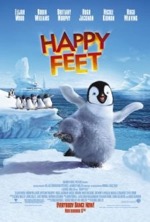
Starring: Elijah Wood
November 2006
“Heavy-Handed Politics Leaves ‘Feet’ Flatfooted”
The last time I saw an animated movie this political was FernGully: The Last Rainforest (1992). An indoctrination session for the New Age movement, the movie extols the mystical energies that govern the “circle of life,” while vilifying the humans responsible for deforestation and upsetting nature’s delicate balance. On the face of it, Happy Feet is a seemingly innocent, completely innocuous animated film, whose only apparent pretension is that it comes too soon on the heels of 2005’s surprise hit documentary, March of the Penguins—but as we all know, appearances can be deceiving. For anyone who’s seen March of the Penguins, the opening chapter of Happy Feet will feel like a prolonged bought of déjà vu, complete with plagiarized narrations and scenes that look like they were lifted right out of the documentary.
Early on, the movie focuses on Mumble’s (Elijah Wood) desperate attempts to fit in with his peers; Mumble can tap-dance like Fred Astaire, but his singing resembles a blaring foghorn. One adult penguin, who looks down on the misfit youth, charges, “A penguin without a heart song is no penguin at all.” Excluded from many normal activities—much like that famous reindeer we’ve all sung about—Mumble often steals away to a nearby glacier and tap-dances by himself, away from disapproving eyes.
Somewhere along the way, the movie’s depiction of an outsider with abnormal development becomes a thinly veiled reference to homosexuality. The scene where this becomes painfully obvious is when Mumble teaches his peers how to tap-dance; the old guard vehemently opposes the new form of artistry, viewing it as an uprising, an aberration and a pagan display. When Mumble’s father implores his son to desist with his peculiar dancing, Mumble replies, “Don’t ask me to change, pa’, because I can’t.” With that, Mumble is banished from the penguin community.
A short time later, mumble is befriended by a quintet of diminutive, Latin-speaking penguins; awed by Mumble’s skillful dancing they welcome him into their group with open flippers. (As a pertinent aside, George Lucas was widely criticized for creating aliens with Asian accents in Star Wars: Episode I, but in Happy Feet, where ethnic speech stands out like Mumble’s blue eyes, no one, especially the liberal left—to whom the film heavily panders, has said a word about the obvious racial stereotyping.) Mumble and the Latin penguin entourage team up with Lovelace (Robin Williams), a kind of charismatic prophet who wears a plastic six-pack holder as a necklace.
As the ragtag group goes in search of “aliens”—the mysterious beings who gave Lovelace his necklace—they soon discover huge warehouses, docks, heavy equipment and colossal fishing boats. It’s at this point when humans are revealed as not only the aliens, but also as the villains of the movie; apparently humans have been stealing scores of fish from local waters and leaving the penguins with empty stomachs. Captured and imprisoned in an arctic exhibit, Mumble makes repeated attempts at communicating with his human captors, but his animal vocalizations fall on uncomprehending ears, “Why are you taking our fish? You’re kind of killing us out there!”
In order to keep from going crazy, Mumble learns to entertain spectators with his fancy footwork, which immediately draws the attention of the scientific community. Mumble is implanted with a tracking device and released from captivity: A film crew follows Mumble back to his home and captures footage of the penguins dancing in Mumble’s soulful style. Once assembled and released, the documentary creates a political and public outcry which leads to a moratorium being placed on fishing in the waters near Mumble’s glacier. The movie’s final shot tracks a penguin feather as it’s carried along by the wind in a gliding, meandering course, much like Robert Zemeckis’ free-flowing feather at the conclusion of Forrest Gump. Coincidence? I don’t think so!
Where Forrest Gump is existential, Happy Feet is environmental. In fact, the movie’s political slant is so transparent and so in-your-face, it’s almost nauseating. How cowardly of leftist Hollywood and environmentalist wackos to use an animated film to espouse, disseminate and otherwise foist their alarmist and fear-mongering doctrine upon audiences; offending many adults and unduly influencing the minds of future generations with a “green” theology.
The localized and oversimplified climax is utterly laughable…one dancing penguin can save the planet? One colony of dancing penguins can change international policy? I’m sure even older children can discern that they’re being sold a load of penguin droppings. And it’s really children who are loosing out the most here; for their sake, why can’t Hollywood check its politics at the door and let kids make up their own minds about where they stand on environmental issues…when they’re old enough to do so?
The real tragedy with Happy Feet is that, politics aside, the film is a visual marvel—the next evolutionary leap in CGI. The leopard seal chase is an exhilarating thrill ride of evasive maneuvers and narrow escapes and the killer whale sequences are absolutely breathtaking. Also, the movie’s vocal talents are stellar, though it seems as if every other character is voiced by Robin Williams, and that gets a tad tedious.
Happy Feet would’ve been so much better had it simply concentrated on being an animated kid’s film and not on being a stilted soapbox lecture on global correctness; the heavy-handed sermonizing severely detracts from what otherwise would have been a highly entertaining family film. So, as Mumble would say, I appeal to Hollywood’s better nature and officially request that they refrain from producing films, especially animated ones, which are nothing more than a political platform for some special interest group to use in propagating their misguided message to a mass audience. Just as there’s a separation of church and state, I propose a separation of politics and media. It probably would never work, but what the heck, we might just get objective news out of the deal.
Rating: 2
Casino Royale (PG-13)
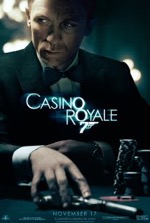
Starring: Daniel Craig
November 2006
“High Stakes Bond With a Rising Star”
From the first frame of the opening sequence—a brilliant, casino-themed montage where guns shoot spades, featureless victims bleed small red hearts and a person falling to his death shatters into a pile of cards upon impact—it’s clear that this isn’t your father’s Bond movie. Incidentally, this is also the first Bond film in memory that doesn’t showcase silhouetted naked women in the opener. The firsts don’t stop there; Casino Royale, based on the novel of the same name by Ian Fleming, chronologically predates all of the previous Bond films, making it a prequel of sorts. As such, we are retrospectively introduced to some Bond’s most recognizable touchstones; we discover how Bond comes to own his Aston Martin, learn how he creates the phrase, “shaken, not stirred,” and witness his first utterance of that iconic line, “Bond, James Bond.”
When Daniel Craig (Layer Cake) was confirmed as the new Bond, I was more than just a little skeptical; however, my misgivings were wholly unfounded. With all due respect to Connery and the rest of the gang, Craig, pound for pound, might just be the best Bond ever. He’s certainly more ripped than any former 007, judging from the scene where Bond emerges from the ocean with a premium six-pack—a tableau that parallels Halle Berry’s entrance in Die Another Day. Where Pierce Brosnan’s Bond would have quipped, finessed or negotiated his way out of a fight, Craig’s Bond bulldozes anyone who poses a threat to him. As such, the new Bond is scrappier than his predecessors and takes the quickest route to dispatching his enemies a la 24’s Jack Bauer. What’s refreshing—for an action hero archetype—is that this Bond occasionally makes mistakes (like when he gives himself up by clumsily tailing a bad guy), albeit, not fatal ones.
The stunt work, fight scenes and action sequences in Casino Royale are some of the finest in the entire series and are certainly above par when compared to your garden variety action picture. Some of the movie’s best action scenes include an explosive car chase at Miami International Airport, an all-out, hand-to-hand slugfest in a hotel stairwell and a frenetic shootout inside a pontoon-fortified Venetian building. However, all of those scenes pale in comparison to the opening, skyscraper scaffolding sequence in Madagascar where Bond pursues a bomb-toting, free running terrorist who scales walls like Spider-Man and bounces over and around obstacles like a monkey on speed. The scene easily qualifies as the finest action sequence I’ve ever seen…if it fails to get your heart racing, you have no pulse.
For poker lovers, roughly a quarter of the movie focuses on a high stakes Texas hold ‘em tournament in Montenegro. However, even if you don’t know the difference between a straight and a flush (or a straight flush), you’ll still enjoy the psychological warfare employed by the players along with the refined trash talking that randomly bounces around the table like a pinball. Here’s the scenario: If Bond wins, he will financially cripple an international terrorist organization…if he looses, Her Majesty will have just funded said terrorist group.
For female viewers, the movie also features a friction-filled romance between Bond and hard-to-get Vesper Lynd (Eva Green), an accountant sent to keep an eye on Bond and distract the other players with her slender frame, dangerous curves and bedazzling red dress. There’s a wonderful scene where Bond and Vesper engage in a war of words on a train bound for Montenegro. Fraught with sexual tension, double entendres and some of the best repartee I’ve heard since Cary Grant and Eva Marie Saint patented the lascivious train ride in Hitchcock’s classic North by Northwest, the scene kicks the romance subplot into high gear, and sets the stage for the twisty and tragic climax.
What makes this Bond superior to its forebears is the sure-handed directing by Martin Campbell and the superlative script penned by Academy-award winning screenwriter, Paul Haggis (Million Dollar Baby). The movie has great supporting characters including Judi Dench, who reprises her role as M and Mads Mikkelsen as a heartless villain, Le Chiffre, a man who bleeds from his blind right eye when angered.
Casino Royale is the best Bond to date, and not just because of its up-to-date FX or its new star; this is a more modern and mature Bond, unshackled by the usual silliness involving hi-tech gadgets and gizmos. With a film this superior, odds are we’ll be seeing Bond…Craig’s Bond again very soon.
Rating: 3
The Santa Clause 3: The Escape Clause (G)

Starring: Tim Allen
November 2006
“Third Time Isn’t the Charm for This Freezer Burned Sequel”
I didn’t much care for The Santa Clause, starring Tim Allen, and skipped the sequel on purpose. I was willing to give this new film, entitled The Santa Clause 3: The Escape Clause, a fair shake, mostly because of Martin Short’s inclusion in the cast. Going in with a reasonably open mind, I was sorely disappointed in a comedy that not only lacked humor, but also featured an insufferably childish storyline.
As the movie opens, we learn that Scott Calvin/Santa’s (Allen) wife, Carol Calvin/Mrs. Clause (Elizabeth Mitchell), is pregnant. Carol wants her family by her side during the delivery, but the Clause’s can’t exactly reveal their true identities or the secret location of the North Pole. Someone (probably that chunky Spencer Breslin kid who seems to find his way into every Tim Allen movie these days) comes up with the idea of passing off the North Pole as a Canadian village simply by changing the signage and closing off top-secret areas. The Sandman (Michael Dorn) puts Santa’s in-laws, Bud (Alan Arkin) and Sylvia (Ann-Margret), to sleep and Santa ferries them to “Canada” in his renowned sleigh.
Meanwhile, Jack Frost (Short) is brought before the Council of Legendary Figures and is sentenced to manual labor in Santa’s workshop for his crimes (not legendary for their wisdom, it would seem): predictably, Frost wastes no time in sabotaging the factory. Frost’s end game is to steal Santa’s special snow globe and trick him into saying, “I wish I wasn’t Santa,” which is the extent of the Escape Clause. After accomplishing his task, Frost grabs Santa’s coat and becomes the new Santa. Before you can say “Blitzen” Frost converts the North Pole into a Vegas-style resort where myriad vacationers swarm to shops, shows and restaurants, fighting over merchandise and steamrolling anyone who gets in their way. Scott, the deposed Santa, must beat Frost at his own game to retain the mantle of Santa and restore Christmas to its former glory.
This was the point in the film where I actually felt like it had the potential to go somewhere, but almost before the problem is presented, it’s elegantly resolved by a plan the audience can see coming a mile away: Scott’s telegraphed solution is packaged, wrapped and tied up with a pretty little bow. How convenient. How contrived.
As poor as the script is, the movie’s biggest tragedy is how such a decorated cast could be relegated to acting in such pedestrian fare. However, if there’s one aspect of the movie that shines like Rudolph’s nose, it’s the highly creative, finely-detailed set pieces that festoon the various incarnations of the North Pole. In many ways, the sets are reminiscent of those crafted for Dr. Seuss’ How the Grinch Stole Christmas, sans Seuss’ skewed visual style.
Disney forbid there should be a Santa Clause 4, but if another sequel should slide down the Hollywood chimney in the near future, one can only hope that the script shows a marked improvement over the one presented here—that would be the best gift of all.
Rating: 1 1/2
Flushed Away (PG)
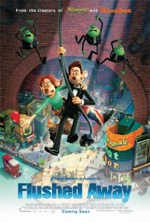
Starring: Hugh Jackman
November 2006
“Take the Plunge…It’s Tons of Fun”
From Aardman Animations (producers of Chicken Run and Wallace and Gromit in The Curse of the Were-Rabbit) and DreamWorks Studios comes Flushed Away, a high-spirited romp that transports spectators from London’s upper-crust suburbs to its slug-infested sewers. A modern twist on The Prince and the Pauper, Flushed Away features jaw-dropping animation (this is the studio’s first entirely CG film) and upholds the tradition of excellence established in Aardman’s finely crafted Claymation films.
As a well-mannered, well-cultured and well-groomed house rat, Roddy (Hugh Jackman) has it all; he can cruise around in a R.C. car with a beautiful blonde doll, play a one-sided tennis match with inanimate players and create imaginary conversations with action figures in a play set café. As a pampered pet in an uptown flat, Roddy has the freedom to do whatever he wants, but his existence is a shallow one because there’s no one with whom he can share his staged and synthetic adventures. Capping off another hollow day, Roddy tucks himself into a dollhouse bed and wonders what it would be like to have a real family and friends. As loneliness consumes him, Roddy hears a noise down the hall and gets up to investigate; he discovers Sid (Shane Richie), an obese, ill-mannered sewer rat who makes himself at home in Roddy’s immaculate penthouse apartment. Roddy’s attempt at tricking street-smart Sid into returning to the sewer backfires when Sid shoves Roddy into the “jacuzzi” and pulls the lever.
When Roddy hits the bottom, he discovers a whole new world, but it’s nothing like the one Jasmine sings about in Aladdin; prim and proper Roddy gets a taste of how the other half live when he enters a sludge-filled sewer. Roddy soon stumbles into a subterranean city, dubbed Ratropolice, which is managed and inhabited entirely by sewer rats. As he embarks on a homeward journey, Roddy encounters Rita (Kate Winslet), captain of the scavenger vessel Jammy Dodger and the rat-loathing villain named The Toad (Sir Ian McKellen). Before he can return to the comfortable, sanitary, yet lonely environs of his owner’s mansion, Roddy must survive hair-raising pursuits through sewer passageways, evade Le Frog (Jean Reno), the French assassin and his ninja frog cronies, and foil The Toad’s plans to turn Ratropolice into a giant deep freeze.
Each of these Aardman movies has a “pandemonium sequence” (PS), which usually kicks in toward the end when forces collide and the action is ratcheted up to breakneck pace. In Chicken Run, the PS comes when the collective fowl desperately try to lift-off in their makeshift plane, and in Wallace and Gromit, the PS occurs when the true identity of the Were-Rabbit is revealed and everyone tries to capture him/it. Though Roddy and Rita’s climactic showdown with The Toad and his two rodent lackeys (Bill Nighy and Andy Serkis, who deliver pitch-perfect vocal performances) is exciting, the action never quite approaches the heights of frantic insanity achieved during the pandemonium sequences in those other two Aardman films.
Despite the tepid climax, there are some great moments in the movie, like Roddy’s introduction to Rita’s Brady-Bunch-on-speed family at their shifty, wave-tossed house or the high-speed chase where French frogs pursue the Dodger on cake mixers, or the intermittent comic relief provided by the show-stealing, serenading sewer slugs? Though it tells a touching tale about the necessity of friendship, the movie is noticeably more remedial than Aardman’s previous efforts; however, since the movie’s target audience is kids, that’s not such a bad thing and there are plenty of elements in the film that adults will enjoy as well. In the end, the movie is heartwarming and highly entertaining, but not necessarily award winning. Some may smell a rat here, but I still maintain that Flushed Away is a family friendly, fun-filled caper that should give us all a newfound respect for sewer workers.
Rating: 2 1/2
The Prestige (PG-13)

Starring: Christian Bale
October 2006
“Are You Watching Closely? You’ve Been Tricked!”
Director Christopher Nolan and actors Christian Bale and Michael Caine were driving forces behind last year’s critically acclaimed, comic book-to-big screen action thriller, Batman Begins. Add to that team X-Men’s Wolverine, Hugh Jackman, and the sultry siren, Scarlett Johansson and you have a surefire hit on your hands…right?
As would be expected, the film opens with a magic show. The magician is assisted by Cutter (Caine) backstage and Robert (Jackman) and Alfred (Bale) who are planted in the audience and selected every night as part of the performance. Robert and Alfred are aspiring magicians, but their association as friends and colleagues abruptly ends when Robert’s wife, Julia (Piper Perabo), drowns in a water tank during an illusion gone wrong. Robert casts blame on Alfred, who always tires to push a trick to the next level and takes unnecessary risks. The balance of the movie deals with Robert’s repeated attempts to avenge his wife’s death, while trying to beat Alfred at his own game.
The game of one-upmanship between the two competing magicians is engaging at first, but the point and counterpoint plot exponentially looses steam as the movie progresses. The movie’s climax is like a chess skirmish where both players trade pieces until one player takes a piece and his opponent can’t counter, producing a clear-cut victor. Trying to figure out who will outthink his rival and deal the ultimate deathblow was clearly intended to be an enjoyable experience, but the volleying storyline, in the end, is more exhausting than exhilarating.
These disparaging comments are in no way an indictment against the director, actors or anyone else involved in the movie’s creative or technical departments, all of whom did an exceptional job of transporting the viewer into this turn-of-the-century period piece. If any area of the movie bears criticism, it’s the prefab plot based on Christopher Priest’s novel. Every magic trick is based on diversion and deception, and the storyline here deals in the same kind of chicanery—the plot is a façade that appears to be an intricately woven yarn, but is simply a hollow attempt at generating Industrial-era intrigue; wowing audiences with its all-star cast, the movie only offers cheap thrills and unfulfilled promises.
At the movie’s midpoint, Robert seeks out eccentric inventor, Nikolas Tesla (David Bowie, in a brilliant piece of surprise casting), who builds Robert a machine that is way beyond today’s technology, much less that of a century ago. As egregious as that is, the final nail in the movie’s coffin is protagonist confusion. Just who are we supposed to root for here? True, the magicians demonstrate their genius over the course of the film, but both men are so riddled with foibles, ranging from self-aggrandizement to an overactive need for vengeance, so as to be flawed beyond recognition as heroes. The person I wanted to come out on top suffers ultimate defeat, but who cares? There’s nothing virtuous about either magician and in the end, it doesn’t really matter who you pull for, they’re both egomaniacs who stop a nothing to produce better illusions than their opponent and, therefore, are utterly despicable. Did screenwriters Jonathan and Christopher Nolan fail to realize that the audience would naturally want to choose sides and that every story must include at least one hero that everyone can cheer for?
I so badly wanted this film to succeed, but alas, the movie falls for its own sleight of hand. If, like me, The Prestige left you wanting more, check out the other recent magician movie, The Illusionist, starring Edward Norton. Unlike The Prestige, The Illusionist doesn’t waste its or your time on competitive shenanigans or scientifically impossible illusions…there’s nothing hidden up its sleeve.
Rating: 2 1/2
The Guardian (PG-13)
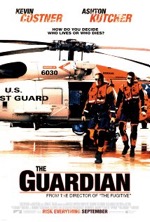
Starring: Kevin Costner
September 2006
“Standard Ending Nearly Sinks Heartfelt Story”
“It was the best of times, it was the worst of times…” Dickens’ oft-quoted line from his classic A Tale of Two Cities is an excellent description of the latest Kevin Costner vehicle entitled The Guardian. An obvious promotional piece for the Coast Guard—its riff on Top Gun—The Guardian boasts several meaningful scenes, but also contains some elements that are in desperate need of being rescued.
Ben Randall (Costner), a legendary Coast Guard rescue swimmer, was recently traumatized when a rescue mission ended in tragedy, leaving him the only survivor. The mental toll of the ill-fated rescue attempt, compounded with Ben’s recent separation from wife Helen (Sela Ward), forces Capt. Hadley (Clancy Brown) to take Ben off of active duty; Ben is transferred from Barksdale AFB in Kodiak, AK to the Coast Guard training facility in Louisiana. Inspecting the new crop of trainees, Ben sees potential in cocky upstart, Jake Fischer (Ashton Kutcher); a decorated college swimmer, Jake has his sights set on toppling all of Ben’s swimming records. However, as Ben is quick to remind the trainees, there’s more to saving lives than just swimming. Scrapping the traditional PT regimen, Ben initiates a series of unorthodox training sessions; including a one hour endurance test where touching the bottom or sides of the pool means instant disqualification from the program, a hypothermia exercise in an ice-filled pool and a teamwork/breathing exercise where two swimmers must move a brick from one side of the pool to the other, but the swimmers can only come up for air one at a time. Ben’s hard-nosed approach immediately alienates Skinner (Neal McDonough) and makes Capt. Frank Larson (John Heard) wonder if Ben’s cut out to be a drill instructor. These training sequences are the movie’s double-edged sword—some viewers will enjoy the process involved in molding trainees, while others will grow frustrated by the lack of progression and check out somewhere in the middle of the movie.
The film’s structure is basic enough; the beginning and end feature rescue missions, while the middle focuses on academy training. Besides being predictable at every turn, The Guardian defaults to the standard disaster movie ending where the older man cuts himself free from a safety cord so that the younger man can continue on and, presumably, live a long and fruitful life. We’ve seen this exact ending in Backdraft and Vertical Limit, with Armageddon and Poseidon bearing a close enough resemblance to make it worth mentioning here. This climax must be effective—even though it shamelessly manipulates the audience’s emotions—otherwise it wouldn’t be used with such frequency. But please, Hollywood movers and shakers, no more resolutions of this kind! Next time, maybe the writers can do something different and sacrifice the younger man—it might be politically incorrect, but at least it would contain a modicum of reality and treat the audience to something original.
That is not to say that the movie doesn’t have any touching moments: Ben’s apparent reconciliation with his wife makes his tragic demise all the more painful. Also, when Ben and Jake learn that they both have emotional hang-ups over being the sole survivor of an accident, a connection is made and a friendship begins to form. These episodes, where genuine emotions begin rising to the surface, are few and far between in a movie far more concerned with magnifying the courageous sacrifice of Coast Guard swimmers, as honorable as that is, than with chiseling out three-dimensional characters or crafting dialogue written above a high school level.
As for the acting, Costner is a tad less wooden here than usual, and Kutcher shows early signs of being a decent dramatic actor. What anchors the movie is its excellent supporting cast; especially Heard, McDonough, Ward, Brown and Melissa Sagemiller as Jake’s girlfriend, Emily.
Though some of the sequences involving angry, undulating waves made me seasick, like the ones in The Perfect Storm, director Andrew Davis (The Fugitive) does a good job of making the action seem realistic. Too bad the script didn’t follow suit.
Rating: 2 1/2
The Illusionist (PG-13)
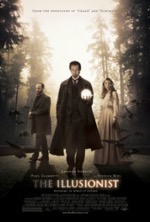
Starring: Edward Norton
September 2006
“Like Lucky Charms, It’s Magically Delicious”
As I started jotting down notes at a screening of The Illusionist, my pen abruptly died. After exhausting every conceivable strategy of coaxing ink out of the depleted stylus, I settled on an alternate note-taking strategy. I wrote my observations with a firm hand and later retrieved them by rubbing pencil lead over the page, which revealed the text in reverse. When I started writing this review, it suddenly occurred to me that such basic science might be commonplace to you and me, but to a five-year old child it might appear as…magic!
The magic performed by Eisenheim the Illusionist (Edward Norton), however, is a tad more sophisticated than my pencil-rubbing trick. It is said that, as a boy, Eisenheim was inspired by a traveling magician who showed the lad a few illusions before disappearing into thin air. Magic consumed the Eisenheim during his formative years, but his focus expanded the day he encountered the beautiful duchess, Sophie. Despite their disparity in social standing, Eisenheim and Sophie were inseparable growing up; “One day we’ll run away together,” she promised.
As an adult, Eisenheim plies his trade as an illusionist in small, but packed theaters in Vienna, garnering the esteem of many prominent patrons, including the inquisitive Chief Inspector Uhl (Paul Giamatti). During that fateful performance, the magician asks for a volunteer, and, much to his surprise, Eisenheim is reunited with his childhood sweetheart when she glides onto the stage. After the show, Eisenheim learns that Sophie (Jessica Biel) will soon be engaged to Leopold (Rufus Sewell), the crown prince. Sensing the potential threat posed by Eisenheim, Leopold orders Uhl to “shut him down” (surely a common phrase during that period). With Uhl watching his every move and Leopold seeking his life, Eisenheim creates a new show that must confound the audience, foil Leopold’s plans and win back Sophie’s heart before it’s too late.
As the movie’s slogan suggests, “Nothing is what it seems.” This is certainly true as the movie never reveals its hand until the very last scene. Based on a short story by Steven Millhauser entitled “Eisenheim the Illusionist,” writer/director Neil Burger does an excellent job of managing this gothic tale, which certainly would have floundered in the hands of someone less visionary. The costuming, makeup and historic props and sets all exude authenticity and Burger’s use of a sepia-hued palette, aged film stock effects and old-fashioned circle wipes is extremely effective. Also, the revelation scene—where Uhl mentally deconstructs Eisenheim’s ultimate illusion in a montage of shots—is a brilliant way to illustrate the Chief Inspector’s flow of deductive reasoning.
Norton (The Italian Job) is a bit subdued here, but plays the part of Eisenheim with deftness equal to the skilled magician. Impressively, Norton did most of his own tricks in the movie (with the assistance of magician David Blaine), and what’s more, very few of the movie’s illusions received a CG touch-up.
Biel and Sewell (A Knight’s Tale) work fine as an improbable couple and their performances, as secondary characters, properly garnish the juicy ménage trios subplot—Biel soars here, leaving behind her 7th Heaven chrysalis. Though all of the actors shine, Giamatti’s performance stands out like a lighthouse beacon on a stormy night. Giamatti’s range is awe-inspiring; I’m thoroughly convinced that if someone put a white, fluffy wig on the actor’s head and said, “Be a Q-Tip,” he would not only pull it off but add unexpected nuance to the part. For The Illusionist, Giamatti adopts a European accent and a resonant baritone; he speaks softly, but with authority. Sporting a full beard and slicked back hair, viewers may fail to recognize Giamatti at first glance. Whereas Norton is the film’s heart and soul, Giamatti is its conscience and backbone…the versatile character actor has turned in yet another memorable performance.
Due to the constraining nature of a period piece featuring a magician, the movie, though entertaining and thought-provoking, is far from Best Picture caliber. However, the movie does boast one of the most satisfying twist endings to come along in quite some time. Anchored by a superior cast, The Illusionist juggles character development with breathtaking cinematography and an intricate plot that contains just the right amount of romance, political intrigue and brow-furrowing mystery. Now that’s a trick!
Rating: 3
Invincible (PG)

Starring: Mark Wahlberg
August 2006
“Wahlberg Flies Like an Eagle in Inspirational Gridiron Tale”
“Never tell me the odds!” That’s what Harrison Ford’s Han Solo told statistic-spewing robot, C-3PO, in The Empire Strikes Back. I wonder what the odds would be against a thirty-year old Average Joe earning a walk-on spot with an NFL team having only played one year of high school football. Whatever the odds, Vince Papale, a struggling Philly bartender, beat them in 1976 when he achieved the impossible and became a Philadelphia Eagle.
In the movie, Papale is played by Mark Wahlberg, who resembles the physical proportions—if not facial features—of the genuine article. Wahlberg’s performance is efficient, but certainly isn’t flashy; this also seems to mirror the real Papale, who originally was reticent to try out for the team and shied away from media attention…many reporters were all too eager to cover his miracle story.
As the movie opens, Papale is at his lowest point; his wife just walked out on him and his employment as a substitute teacher was recently terminated. New Eagles coach, Dick Vermeil (played with gridiron precision by Greg Kinnear…a touchdown for the casting department), makes an announcement that the Eagles will hold open tryouts at Veteran’s Stadium that Saturday. Vermeil’s pronouncement may have been viewed as a media stunt, but his real strategy was to shake up the entire Eagles organization—which had grown accustomed to loosing—and wake up a city that had fallen into a mental rut concerning their hometown team.
Though Papale’s friends encourage him to try out for the team, his father has a different opinion, “Let this one go; a man can only take so much failure.” Ignoring his father’s advice, Papale finds the nerve to try out, and of the thousands of Eagle wannabes that converge upon the stadium, Papale is the only person asked back to Eagle’s training camp. Spurred on by his dream to play professional football and by his ex-wife’s acerbic departure note (which basically says he’ll never amount to anything), Papale gives it his all during a tumultuous training camp and preseason, and anyone who’s familiar with the story, or who’s seen the trailer, can connect the dots from here. There’s no major twist here; history has already taken away any possibility of a surprise ending.
In the grand tradition of feel-good sports films like Rudy and The Rookie (whose producers also worked on this film), Invincible carries the “follow-your-dreams” torch with pride and excellence. Though the film’s through line is as straight as a Bradshaw spiral, there are several character-defining subplots that flesh out the movie and broaden our knowledge of the protagonist; such as the Cheers-like moments in the bar, the back lot football games and the arrival of Papale’s new love interest, Janet (Elizabeth Banks), who happens to be a die-hard fan of the rival NY Giants.
From the sets and costumes to the shaggy coifs, every aspect of the movie appropriately fits the period in which it was filmed; the 70’s soundtrack also adds an extra degree of authenticity. And speaking of authenticity, the inclusion of actual game footage, featuring some of Papale’s highlight plays, is a really nice touch.
Invincible is pure, unadulterated inspiration; a poignant reminder to us all that no matter who you are or where you’re from, as long as you have a dream and are willing to contend for it, miracles can happen. This is one of the best films of the year!
Rating: 3
Lady in the Water (PG-13)
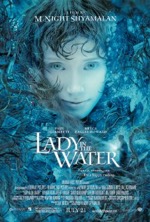
Starring: Paul Giamatti
July 2006
“Shyamalan’s Scary Tale Succeeds by Taking Risks”
The word “narf” effortlessly plopped out of director M. Night Shyamalan’s mouth one evening as he was telling his children a bedtime story. That homespun fairytale soon became the creative fodder for Shyamalan’s latest thrill-fest, Lady in the Water. From the start, Shyamalan made it clear that the movie—an unconventional love story filled with mythological creatures—would be a radical departure from his other films.
The opening narration, conveyed in a series of petroglyphs, provides the particulars of the movie’s myth: Once every eon, an ancient race of humans send an envoy from their water world to meet with their surface-dwelling brethren in an attempt to ignite a great awakening among humans. A water nymph (narf) must find the “vessel”—a person of unique vision—that will usher in the era of peace. Despite repeated attempts throughout history, every narf ambassador has failed in her peace-fostering mission because “man doesn’t listen very well.”
As the story opens, we’re introduced to Cleveland Heep (Paul Giamatti), a tortured soul who manages an apartment complex in Philly. Cleveland’s mundane existence as handyman, exterminator and peacekeeper brings him into contact with many of the building’s colorful tenants, including the Hispanic couple and their five daughters, the Asian college student and her controlling mother, the Indian writer (Shyamalan) and his nagging sister, the eccentric jock who only exercises the right side of his body, the African American father who excels at crossword puzzles and his insightful son, the quartet of freethinking beer buddies and the newest tenant, a haughty movie critic.
It takes a while for Shyamalan to establish all of his characters and their relationships to each other, but when Story the narf (Bryce Dallas Howard) surfaces in Cleveland’s pool, the plot kicks into high gear and a first-rate mystery begins to unfold. Story quickly identifies the “vessel,” but determining the supporting players—the guild, the guardian and the symbolist—proves more problematic. Cleveland and his tenants, now bound by a common purpose, must protect Story from an aggressive, wolf-like creature called a skrunt until the giant eagle swoops down and carries her to freedom.
It all sounds a bit hokey on paper, but Shyamalan does a masterful job of balancing character and plot with the fantastical. In an effort to mitigate the moments of stark terror (which are far fewer and less severe here than in his other movies), Shyamalan has employed more humor this time, which is just a natural byproduct of the multi-layered and multi-cultural characters that populate his story. One of the ongoing sources of amusement is the Asian mother’s reticence to share the narf’s origin tale with Cleveland. At one point, Cleveland must act like a child and have milk and cookies on the woman’s couch in order to receive a short lesson in narf mythology. The arrogant critic also provides unexpected comic relief; his jaded commentary on romance movies and his miscalculation of the danger he’s in at the movie’s climax is highly entertaining.
There’s no doubt that Shyamalan can select stars (like Willis and Gibson) for his projects, but here he’s handpicked an amazing cast, each of whom shines in his or her own way and serves a different function in the director’s visionary yarn. Howard’s fair complexion and ethereal visage lends itself perfectly to the otherworldly Story. The fact that Story doesn’t know a lot about what’s going on makes the movie that much more riveting and satisfying. Giamatti works magic in the title role; his stuttering everyman is extremely likable and accessible—there’s something in his timbre and delivery that reminds me of a younger Richard Dreyfuss. As a reluctant leader, carrying around a Santa-sized sack of guilt from his wife’s death, Cleveland finds a measure of heroism within himself when his paternal instinct kicks in and drives him to protect Story at all costs. Cleveland is captivating throughout and is an excellent character study.
Some, undoubtedly, will find Shyamalan’s avant-garde resolution unpalatable; but you can hardly fault him for breaking with the “big twist ending” motif that’s marked all of his other films. Here, he tries something different, and, for better or worse, I applaud his efforts. Though Lady in the Water is far inferior to The Sixth Sense, it’s the most human Shyamalan tale to date—by assembling an excellent ensemble of intriguing characters, the auteur has delivered one of the most unique and refreshing movies to come along in quite some time. So, whether or not you buy into narfs and skrunts, know that Lady in the Water has inaugurated a new film genre…high-art fairytale.
Rating: 3
Pirates of the Caribbean: Dead Man’s Chest (PG-13)

Starring: Johnny Depp
July 2006
“Depp and Crew Are Dead in the Water”
What happened? The first Pirates of the Caribbean movie was a rousing crowd-pleaser that featured one of the most memorable characters to grace the silver screen in quite some time, Johnny Depp’s swaggering lush, Captain Jack Sparrow. An unqualified success on every level, Pirates was a feel-good romp filled with red coats, nefarious pirates, stolen treasure and a skeleton crew, literally. Aside from Depp’s spellbinding performance and the witty dialogue assigned to him, what made Pirates sail was relationships: Jack and Will forging a tenuous friendship, Will and Elizabeth falling in love, Jack and Barbossa squaring off during the movie’s harrowing climax, etc.
In the sequel, entitled Dead Man’s Chest, these relationships are quickly discarded to service a plot that sees Jack and Will at each other’s throats and Elizabeth smooching Jack just a short time after her interrupted wedding—before they can say “I do,” Elizabeth and Will are dragged away in irons and slapped with the charge of treason for aiding Jack in the previous film. In order to receive a pardon, the couple must steal a special key from Jack. Jack, however, has troubles of his own as he’s been slipped the black spot and is desperately trying to avoid a sea-bound leviathan called a Kraken.
Along the way, they encounter many familiar faces from the past as well as the new baddie, Davy Jones (Bill Nighy), the squid-faced master of the underworld who holds absolute sway over his barnacle-encrusted crew. Onboard Jones’ magical ship, the Flying Dutchman, Will encounters his father, Bootstrap Bill; Will soon learns, much to his dismay, that a rescue attempt is impossible as his father has lost a wager and will spend the rest of his existence in servitude to Jones. In addition to a stealthy submarine mode, the Flying Dutchman can also summon the Kraken, which surfaces about every half hour just to keep things interesting. With the Kraken’s maw resembling a giant sphincter, the movie could be renamed Pirates of the Caribbean: Attack of the Butt Kraken…an adequate title for a grossly inadequate sequel.
Whereas the first Pirates movie was clever and amusing, the sequel is silly and confusing. Trying to make heads or tails of the writhing, often nonsensical plot is tantamount to understanding the dice game played by Jones’ crew. I have to give the writers credit for taking risks—Dead Man’s Chest certainly isn’t boring, though it does run at least a half hour too long. Unfortunately, despite their best efforts to avoid sequelitis, the writers have presented a story that, not unlike a sailor’s matted and tangled beard, is a disheveled mess. Besides the tenuous storyline, some of the movie’s action scenes are just downright ridiculous; like the dizzying sword fight on the runaway water wheel or the entire sequence involving Jack’s flight from the natives, which borrows heavily from Raiders of the Lost Ark and Return of the Jedi.
Silly scenes notwithstanding, the greatest tragedy here is that Captain Jack isn’t even remotely funny, and what’s more, isn’t even likable. His one-liners plummet like anchors, not because they’re poorly written, but because the character left his charm back at Port Royal. Somewhere between movies, either the writers or Depp himself lost Jack’s voice. Here he comes off more as a self-centered, cut-throat pirate and less like the irreverently insouciant debonair we fell in love with in the first movie.
After a dizzying two and a half hours, the movie ends on a low note; Captain Jack finally faces the Kraken and a dark cloud of uncertainty hovers over Will and Elizabeth’s relationship…the whole kiss thing. The “supposed” major twist ending is possibly the finest example of deus ex machina I’ve ever seen—and that’s no compliment. The arrival of the surprise visitor from the past is clearly intended to put an exclamation point on the film’s final moments, but instead, the strategy backfires and leaves the audience in a state of confusion—it’s a contrived cliffhanger that clumsily creates another loose end.
As the old pirate’s adage warns, “Dead men tell no tales;” unfortunately, the living ones didn’t have much to say here either. It’s been reported that parts two and three were filmed at the same time—to say that I’m dubious about the quality and potential of the third chapter would be colossal understatement. We’ll see if Depp and crew can right the boat. As for Dead Man’s Chest, it’s an aimless, listless and witless story that’s anything but shipshape.
Rating: 2
Superman Returns (PG-13)
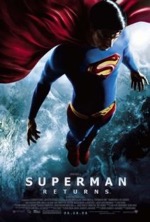
Starring: Brandon Routh
June 2006
“Long Overdue, ‘Returns’ is Overly Long and Overstated”
It could have been great!
That was the unsettling and unshakeable thought that kept echoing in my mind as I exited the theater after viewing Superman Returns. This was the movie I was most excited to see this summer…my prediction for the 2006 box office champ. While the later remains to be seen, the movie is significantly less than I had hoped for; a krypton-infused disappointment that neither hero-friendly director, Bryan Singer, nor newly minted pretty-boy, Brandon Routh, could salvage. Weighing in at an interminable two hours and thirty-four minutes, Superman Returns is a ponderous, somnambulating, seemingly alternate (Elseworlds) Man of Steel chronicle, which frequently parts ways with the continuity established in the previous film series, much to its detriment.
Last seen nineteen years ago in the debacle known as Superman IV: The Quest For Peace, Superman, one of the most beloved and enduring comic book icons, has finally returned to the big screen after eight attempts to revive the story with a veritable army of A-list directors and actors attached to the various rejected projects. Art imitates life as the story opens with Superman’s (Routh) second coming to earth after a five year trek to his annihilated home planet, Krypton. Things have changed: the world has adjusted to life without Superman. People have changed as well: embittered by Superman’s unannounced departure and extended absence, Lois Lane (Kate Bosworth) has written a scathing, Pulitzer Prize-winning article entitled, “Why the World Doesn’t Need Superman.” As Clark Kent chews on that unsavory morsel, he also discovers Lois is a mother and that the father, presumably, is Richard White (James Marsden of X-Men fame), nephew of redoubtable Daily Planet editor, Perry White (a severely underserved Frank Langella).
It doesn’t take long for Superman to leap back into action…Lois is onboard a malfunctioning jet that is rapidly plummeting toward Metropolis; unbuckled from her seat, she’s tossed around for most of the sequence and should be dead several times over, but the laws of physics and gravity, apparently, are different in Superman movies. Superman has super strength, but not super intelligence; this is evidenced in his futile attempt to slow the jet’s screaming descent by pulling back on one of the wings…the wing rips right off with him attached and he has to catch up to the plane. Learning from his mistake, Superman gets up under the nose of the craft and pushes with all of his preponderant might; stopping the plane just a few feet above ground, he gently brings the fuselage to rest upon the infield of a baseball stadium. The awestruck crowd wildly applauds his heroics…Superman has returned! The scene is a tad cheesy, but is well-executed and sets the stage for the rest of the movie…which brings us to Lex Luthor (Kevin Spacey).
I have a great deal of respect for Gene Hackman as an actor, but I never felt he struck the right cord with Lex in the earlier Superman movies…Lex’s brilliance was questionable, at best, and the character simply wasn’t menacing enough. Spacey wholly inhabits the nefarious billionaire and approaches the lofty bar for insidious villains set by Jack Nicholson, whose tour de force performance as the Joker made the 1989 Batman movie. In the same respect, Spacey, who rightfully receives top billing here, makes Superman Returns fly. Spacey’s Lex is well-dressed, well-educated and is surprisingly understated in most instances; he tiptoes along the edge of insanity, but never quite crosses the line. It’s amusing to observe Lex’ survival instinct kick in any time something threatens to go south: watch him in the model room before the power goes out.
Spacey’s contribution to the film cannot be understated or underestimated. If his performance could be distilled into a credit card commercial, it would say: “Superman Returns tickets: $10. Lex Luthor’s wig: $90. Lex’ witty banter with ditzy assistant, Kitty Kowalski (Parker Posey)…priceless!” You can tell the writers had a ball crafting dialogue for him; Lex has the best lines in the movie. “Didn’t your father ever teach you to LOOK BEFORE YOU LEAP?” Lex yells as he kicks the snot out of our severely weakened hero—krypton runs in veins through the crystalline surface of Lex’ New Krypton, formed by a stolen crystal from Superman’s lair.
Lex’ scheme to create new continents, and thereby kill billions of people, is a bit far-fetched…yes land is a valuable commodity, but as Lex himself states, the crystalline fortress he creates lacks warmth and looks alien. Who would want to live there? Would there be a Luthor’s Supermarket nearby? How would people walk or drive over the rugged surface? The demise of New Krypton (Superman thrusts it into space) reveals another nitpick…when Superman lifts the crumbling island, he’s out in the middle of the ocean, but when he falls back to earth, he lands in Metropolis’ version of Central Park.
If it hadn’t been for such super-sized plot holes, the unsatisfactory non-resolution of the movie’s tepid love triangle and a butt-numbing, half-hour dénouement, the movie might have been resplendent instead of merely decent. Though most of the movie plays like a highlight reel of the earlier films, it’s, ironically, Superman himself that is the film’s biggest liability. To be sure, Routh’s performance pays homage to the more endearing nuances of Reeves’ Superman while adding a modern twist, but some of Singer’s choices for this Man of Steel are questionable and controversial. Superman’s homoerotic appearance aside, Singer’s Kal-El is a voyeur who eavesdrops on Lois’ family. Interestingly, though Superman can hear millions of distinct voices from space, he has diminished auditory capacity when listening through the walls of Lois’ house.
One of the movie’s “big” scenes is where Superman catches the Daily Planet globe, which has fallen from the top of a skyscraper. Superman actually struggles with the globe before depositing it on a nearby car. Reeves’ Superman would have replaced the globe and soldered it with his ocular laser beams in three seconds flat. Though admittedly cornier at times, I miss the old Superman…he, at least, had some panache. The new Superman seems more concerned with Lois than anyone else…he flies out to rescue her from a flooding boat while abandoning the imperiled citizens of Metropolis—surely his services are still required in a city reeling from a seismic event.
As I involuntarily fidgeted in my theater seat, I began to wonder why I wasn’t enjoying the movie more. After all, the film is masterfully directed, well-acted and is a visual marvel. After some reflection, I’ve come to an inescapable conclusion…Singer has too much admiration for the source material. Singer tries too hard to impress; his painstaking efforts to create a signature film actually prevent the movie from achieving its maximum potential. His direction can’t be faulted, but he should have pared down the script…Singer crams two movie’s worth of material into one, and, for a film of this ilk, there are too many drawn-out conversations and too few all-out action scenes.
However, there are some great moments in the film, not the least of which is the scene featuring stock footage of Marlon Brando as Superman’s father, Jor-El and John Ottman’s rousing score that includes many of John William’s iconic themes—both of these memorable elements pay fitting tribute to Richard Donner’s landmark 1978 film.
In the final analysis, Superman Returns would have been far better if the ménage trios concept had been jettisoned, the Superboy storyline had been aborted and the death of Superman subplot had been scrapped. The movie would have been much stronger if the last twenty minutes had been excised…I really didn’t need to hear Superman’s tacky line, “I’m always around,” one more time. Singer’s Superman is a solid hit—a ground rule double—but is nowhere close to being a home run. No one can question that Superman Returns is good, but the realization that continues to vex me is…it could have been great!
Rating: 2 1/2
Click (PG-13)
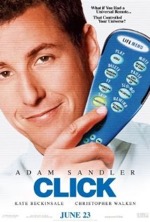
Starring: Adam Sandler
June 2006
“Not Even Remotely Entertaining”
The word tripe, as defined by Merriam Webster, is: something poor, worthless, or offensive. This definition more than adequately describes Adam Sandler’s Click. Finding even one redeeming quality in the movie would make hunting for a needle in a haystack an enjoyable pastime. Many of the movie’s themes and gags are abhorrent (i.e., the family dog repeatedly humping a large stuffed duck), and potty humor runs rampant throughout this severely modernized and significantly dumbed-down variation on Charles Dickens’ classic A Christmas Carol. Click, much to its detriment, suffers from the same brand of lowbrow idiocy that seems to plague the majority of Sandler’s films.
The story focuses on one man’s struggle to juggle the various aspects of his life; family, work, recreation, hobbies, etc. Michael Newman (Sandler) just can’t seem to get it right; the more he tries to organize his life, the more he falls behind and the angrier he becomes. But everything changes the day he falls asleep on a demo bed in a Bed, Bath & Beyond store. Waking up, Michael sees a door marked “Way Beyond.” Opening the door, Michael enters a gigantic warehouse filled with crates, a la Raiders of the Lost Ark, and meets eccentric scientist, Morty (Christopher Walken). Morty has the solution to Michael’s chronic busyness; a remote control that can control Michael’s life…remotely.
At first, Michael has so much fun with the remote control—he pauses a conversation with his boss (David Hasselhoff) and gives the man a migraine by slapping him silly, adjusts the color to make himself look like the Hulk and fast-forwards through whole arguments with his wife—that he fails to see its detriments. As time continues flying by and the remote’s preference mode skips ahead to major events in his life, Michael realizes he’s missing out on meaningful moments with those he holds most dear.
Though I can appreciate the film’s carpe diem sentiment, I just can’t abide Michael’s selfish preoccupation and obnoxious behavior; both character flaws are off-putting and significantly undermine Michael’s status as protagonist. While the movie’s moral is universally relevant, the story’s execution is ill-conceived and overly pedestrian. Still, the greatest narrative crime committed in the remedial screenplay, written by Steve Koren and Mark O’Keefe, is the utilization of the notorious “it was only a dream” twist…we can forgive Dickens for using it, but no such grace can be extended here.
Click passes up on a prime opportunity to tell a truly poignant tale and also squanders quality supporting performances by Kate Beckinsale, Sean Astin and Henry Winkler. Some will consider Click quality entertainment, but for me, I’d rather change the channel.
Rating: 1 1/2
The Lake House (PG)
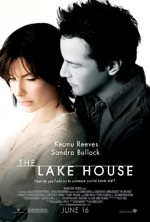
Starring: Keanu Reeves
June 2006
“Timeless Romance with ‘Speed’ Stars”
This type of movie has been done before, most notably in Frequency (2000), which starred Dennis Quaid and a pre-Jesus Jim Chaviezel as father and son separated by time but able to communicate via a HAM radio, which receives an ethereal signal boost from unusual solar flare activity in both time periods. At one point in that movie, Quaid, living thirty years in the past, places a wallet in a Ziploc bag and hides it under a loose floorboard, telling his grownup son in the future where to find it. Chaviezel immediately retrieves the wallet and uses it as a clue to track down a serial killer.
Mailing across time is taken to a whole new level in The Lake House, director Alejandro Agresti’s temporal romance starring Speed duo, Sandra Bullock and Keanu Reaves. Kate Forrester (Bullock) is a doctor at a large Chicago hospital; seeking refuge from the frenetic pace of city life, Kate moves into a lake house on the north shore. Once settled in, Kate finds a forwarding note from the previous tenant, Alex Wyler (Reaves), inside the mailbox (which becomes the focal point of the movie and the conduit through which the characters communicate with each other). Mistaking the note as a prank, Kate writes a response to Alex, sets the letter inside the mailbox and raises the flag. As soon as Kate turns to go, the flag drops. Inside the mail box is another message from Alex, ardently claiming veracity on his part and belying any notion of a practical joke. As Kate and Alex continue exchanging notes over the next few days, they make an astonishing discovery—though Kate and Alex inhabit the same physical space, they exist in two different times. Kate lives in the present day (2006), but Alex is writing her from 2004.
Though the movie’s plot is a little too convoluted at times, it’s a tight yarn with an interesting character study, particularly in Kate’s case. At some point, Kate realizes she’s falling for a man she can never have; a bitter reality that exemplifies her life and ongoing struggle to find fulfillment. One of the finest scenes in the movie is when Alex takes Kate on a virtual walk with the assistance of a map and prerecorded cassette tape; Alex’ commentary is conveyed in a series of voice-overs, and, as an architect, he describes some of Chicago’s landmark buildings in great detail. It’s a touching moment, but when complications surmount and a relationship with Alex seems more and more impossible, Kate severs all communication with Alex. Kate concludes that Alex was “just a beautiful fantasy where time stood still,” and decides to move on by letting go of the past.
The movie’s unconventional resolution caps off a moving, thought-provoking love story that succeeds by placing emphasis on plot and character and not on a contrived or commonplace romance…the fact that the leads barely encounter each other aids the movie in subtle yet powerful ways, producing yearning in the characters as well as the audience. Some mysteries remain unexplained, however; such as how the couple can communicate in the first place. It may seem coincidental that both Kate and Alex have the same pet, a female dog oddly named Jack, but I believe the canine is the key to their ability to communicate with each other across time. Jack barks and runs away when Alex’ friend, Mona, makes a pass at him and the dog leads Alex to Kate’s birthday party where couple first meet. At times, the dog almost seems sentient. Could it be that Jack (an alien or supernatural being in disguise) is orchestrating events to bring the lovelorn couple together? It’s as good an explanation as any, I suppose.
Though the pacing is slow at times, the movie has great atmosphere—Agresti makes excellent use of the breathtaking lake house set, built, according to the story, by Alex’ absentee father, Simon (Christopher Plummer). Simon’s discourse on the proper use of light in architecture is memorable, though not necessarily crucial to the story. As for Bullock and Reaves, their acting isn’t memorable in the least, but that’s exactly what the script requires…less-nuanced performances would have overpowered the plot and distracted the audience from what turns out to be a first-rate love story, garnished with a sprig of suspense and seasoned with a sci-fi paradox.
Jane Austen’s Persuasion is referenced on several occasions in the movie and that novel’s themes of waiting for the right time and receiving a second chance find modern expression in The Lake House.
So the next time you go outside to mail a letter, if your mailbox flag suddenly drops after you raise it, it’s probably just a loose screw, the pull of gravity or a stiff breeze. But just in case, check it anyway.
Rating: 3
Cars (G)
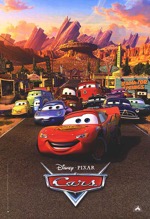
Starring: Owen Wilson
June 2006
“High-Octane Joyride Leaves Other Animated Films in the Dust”
I have to admit it…I’m one of those rare guys who just isn’t into cars. I know how to change an air filter, but that’s the extent of my automotive prowess. My windshield wipers need to be replaced, but I keep procrastinating; putting it off for a rainy day. The NASCAR gene skipped me and went to my older brother, Mike. Growing up, I remember particular Sundays when Mike would sit on the couch all afternoon and watch an entire three hour motor-fest (more times than not, he’d drift off to sleep midway through the race). It fascinated me to no end that a person could be perpetually entertained by different colored cars going in circles for hours on end; then again, I’ve been known to spend the same amount of time watching twenty-two players fighting over an elliptical leather ball.
The newest animated foray by Pixar is simply titled Cars. Celebrating twenty years of excellence in animated entertainment, Pixar knows how to appeal to a mass audience. Their last outing, The Incredibles, was right up my alley, but many people aren’t into the whole superhero thing. Even so, they still turned out in droves to see the only Pixar presentation to date that features humans. I firmly believe that Pixar can take any topic or genre and find a way to make it appealing to a demographic wider than Elastigirl’s reach. And with Cars, you don’t have to know the difference between a lug nut and a corn nut to appreciate the amazing animation, colorful characters and exhilarating story.
The movie begins with a high-octane race known as the Piston Cup, which results in an unprecedented three-way tie between retiring veteran, The King (voiced by race legend, Richard Petty), aggressive upstart Chick Hicks (Michael Keaton, fresh off his turn in car-centric Herbie: Full Throttle) and hot-shot rookie, Lightning McQueen (Owen Wilson). In one week, the three cars will go head-to-head in a tie-breaker in L.A. to determine, once and for all, the Piston Cup champion.
McQueen, a self-professed “one man show,” fires his pit chief and refuses to give up a lead in order to change tires. A bona fide prima Donna, McQueen hogs the camera every chance he gets, but is chagrined each time he does an advertisement for his small-fry sponsor, Rust-eze. McQueen’s dream is to be endorsed by mega-sponsor, Dinoco, but his repeated attempts to woo the company are to no avail.
On the way to the big race, McQueen falls asleep at the wheel and wakes up in the middle of the desert. The cherry-red race car soon drifts into Radiator Springs, the quintessential town that time forgot. An eccentric burg stuck in neutral by small-town mentality, Radiator Springs is chock-full of dented fenders, rusted frames and faded neon signs. As McQueen desperately attempts to escape “hillbilly hell” and get to California in time for the big race, he gradually begins to understand the townsfolk and their struggle to matter in a world that’s passed them by.
Though it takes a while to rev up its narrative engine (the first half of the movie doesn’t have near the same horsepower as Pixar’s previous outings), the film is a rollicking good time once it gets up to speed. The movie is brimming with memorable characters like Doc Hudson (a.k.a. The Hudson Hornet, three time Piston Cup winner), voiced by screen giant Paul Newman, McQueen’s romantic interest, Sally, voiced by Bonnie Hunt, and the dumb-as-a-post rust-bucket named Tow Mater, brought to life by Larry the Cable Guy. Mater, who claims to be the world’s best backward driver, steals the show with his dim-witted antics. The scene where Mater shows McQueen the finer points of Tractor Tipping (“Tractors is so dumb,” he informs McQueen), is one of the most memorable moments in the movie. Mater’s life-long wish is to take a helicopter ride, and when his dream comes true at movie’s end, his line, “I’m happier than a tornado in a trailer park,” is the funniest I’ve heard this year.
Beyond all the flashy cars, inside gags, creative flourishes and eye-popping CGI, there are several wonderfully tender and powerfully poignant messages in the movie, one of which finds expression in James Taylor’s wistful song “Our Town.” Themes such as learning to rely on others, the fear of becoming obsolete and the need to slow down and enjoy life are all subtly woven into a tale that would have broken down after a few laps had it solely focused on spark plugs and fan belts. No Mater what, Pixar is still the undisputed king of genuine human storytelling with anthropomorphized characters.
Rating: 3
A Prairie Home Companion (PG-13)
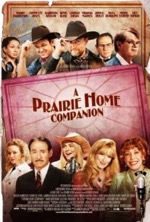
Starring: Lily Tomlin
June 2006
“Fitting Tribute to Keillor’s Off-Kilter Variety Show”
My first exposure to Garrison Keillor was in the early 80s when I watched his “A Prairie Home Companion” variety show every Saturday night on the Disney Channel. As a teen I thought GK (as Keillor is frequently referred to in the movie) was dry and boring, and yet I found myself frequently chuckling at the exploits of the down-home folk of fabled Lake Wobegon, MN, where “the women are strong, the men are good-looking and all the children are above average.”
Much like the actual show, Robert Altman’s A Prairie Home Companion is a bizarre effort. The movie centers on the program’s final show, which is broadcast over the radio and also performed in front of a live audience at the F. Scott Fitzgerald Theater in downtown St. Paul, MN. The film’s synergistic appeal is due largely to the variegated acts that take place on stage as well as the wonderful character moments behind stage and in the dressing rooms, all of which unfurl in real-time.
Take security man Guy Noir (Kevin Cline) for instance; all of his bits are fittingly shot in a film noir style as if he’s a kind of backstage detective. And then there are the Johnson sisters, Yolanda (Meryl Streep) and Rhonda (Lily Tomlin), who very nearly steal the show with their witty, fast-paced dialogue and amusing anecdotes. Yolanda’s daughter, Lola (Lindsay Lohan), has a few scenes, but doesn’t really factor into the story in any significant sense. Two singing cowboys, Dusty (Woody Harrelson) and Lefty (John C. Reilly) bring the house down with their naughty, bawdy, rip-roaring song, “Bad Jokes.” The Academy will officially put the T in travesty if “Bad Jokes” isn’t nominated for an Oscar—the song is the undisputed highlight of the film.
Tommy Lee Jones plays Axeman, the stiff suit sent to shut down the show after its final performance. Axeman is the closest thing the movie has to an antagonist, but other than providing occasional reminders about the show’s demise, the character doesn’t add much to the film. The most avant-garde element in the movie is the mysterious appearance of The Dangerous Woman, played by the lovely Virginia Madsen. Living up to her name, the blonde, white-gowned beauty is a major departure from the traditionally-drawn grim reaper with dark robe and scythe. The Dangerous Woman will claim someone’s life by the end of the night, a dreadful realization that creates ample tension while raising the question: Which character will become her unwitting victim?
Altman (Nashville) was a natural choice to helm this project; few directors can rival his attention to detail and character or approach his genius at taking everyday situations and presenting them as new, unique or quirky reflections of reality. A Prairie Home Companion, like many of Altman’s films, is a cinematic odd bird, but it’s also charming and inspiring in subtle ways. Due to the movie’s singular focus, limiting locale and real-time narrative, some spectators might get antsy toward the middle of the film. Though most of the vignettes are entertaining, the movie has an accumulative resonance, the full impact of which can only be experienced when reflecting on the film as a whole.
A Prairie Home Companion succeeds at honoring Keillor’s variety show while wistfully whisking us back to the mythical and magical days of early Americana; where neighbors were neighborly, deals were made with a handshake and families sat around a box to be entertained at night: Radio, not TV. Keillor’s eclectic program will forever be remembered as a conduit to an earlier, simpler time when folks lived, loved and died...somewhere out on the prairie.
Rating: 3
X-Men: The Last Stand (PG-13)
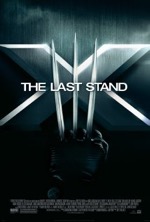
Starring: Patrick Stewart
May 2006
“Dark, Tragic, yet Satisfying ClimaX”
Evolution. It’s what happens with each new X-Men movie. With Bryan Singer at the helm, the first two X-movies told the origin tales of many of the major mutants while previewing the brewing war between humans and mutants. But when Singer exited stage left in mid-production to direct Superman Returns, the prevailing questions became: 1.) Who will complete the third installment, and 2.) Will the trilogy’s final chapter forever be tarnished by a different vision? Enter Brett Ratner (Rush Hour), who, in addition to crafting a big budget sequel for a series adored by millions of fans, had the unenviable challenge of living up to the impossibly lofty expectations of those fans, while simultaneously enduring the scrutiny of a largely-dubious media. At times, I’m sure Ratner could identify with Wolverine when Magneto levitates the lupine hero and manipulates his adamantium skeleton to produce unthinkable pain.
Each X-Men movie sees the inclusion of new mutants—good and bad—into the ever-expanding roster of mutantkind, and this time around, the fresh faces belong to Beast (Kelsey Grammer) and Angel (Ben Foster) on the good side and Juggernaut (Vinnie Jones) and Callisto (Dania Ramirez) on the bad side. A new mutant classification system is introduced in the movie: Professor X (Patrick Stewart) and Magneto (Ian McKellen) are Class 4 mutants; Jean Gray (Famke Jansen) is the only Class 5 mutant Prof. X has ever encountered.
Jean’s part in the story is the most tragic: last seen helping Prof. X and the other mutants lift off in their stealth jet while being swallowed by Alkali Lake, Jean reemerges as a being of frightening power called Dark Phoenix. Jean, we now learn, has a dark side that Prof. X has always kept locked away for her own good, but Magneto feels she’s being held back from achieving her highest potential and seeks to recruit Phoenix to join his Brotherhood of Mutants. The saying, “Absolute power corrupts absolutely,” is painfully illustrated by Phoenix, whose heinous acts will surely shock some viewers—this isn’t the soft-spoken, nurturing heroine we’ve come to know in the earlier films.
On another front, scientists at Worthington Labs (situated atop Alcatraz Island) have discovered an antibody that can “cure” mutants by transforming them into normal humans. The impending war between humans and mutants—as foreshadowed in X2—heats up to a full boil as battle lines are drawn and troops are marshaled on both sides. Even as less-radicalized mutants line up to receive the cure, Magneto rallies his throng of minions with an impassioned speech, “They wish to cure us, but I say we are the cure!”
Rogue’s (Anna Paquin) ambivalence concerning the cure is the most powerful stanza in the film. Her mutant power (she can suck the life force out of another living being with a simple touch), though useful in combat, has a terrible drawback—since she can’t make physical contact with anyone, she will forever be alone. Rogue’s desperate act is a mirror reflecting our own insecurities and basic human needs—her desire to be touched, held and comforted is a cry for love that resonates with universal salience.
Fan favorite, Wolverine (Hugh Jackman), faces a new challenge this time around…the burden of leadership. The transformation from Lone Wolf to Leader of the Pack is an arduous one; especially when his animal impulses and natural instincts to take care of number one come into direct conflict with the increasing demand for teamwork. The lesson he learns in the opening sequence inside the Danger Room (the holodeck-like training room that die-hard fans have been clamoring to see) sets up one of the movie’s most memorable scenes in the climax.
As in the two earlier films, the acting is nothing short of stellar, and the standout performance here is Kelsey Grammer as Hank McCoy/Beast. Grammer wholly inhabits Beast and endues the furry blue mutant with the sagacity and refinement befitting a dignitary—his performance is thoroughly enjoyable.
If the movie has a down side, it’s the lack of attention given to the new mutants. Though Juggernaut’s simple sentences match the mental capacity of the character, Angel, who figured to be a prominent player judging from the trailer and marketing campaign, is only given a half dozen lines. As I said in my review for X2, these films “are overstuffed with good guys.” That statement is even more apropos of X3; most of the new mutants are of the disposable variety and have scant onscreen time.
However, if Ratner’s fourth quarter quarterbacking has earned him any commendation it should be for his unwavering resolve to stay the course and take X-treme risks. Major characters die in the movie. Onetime friends become enemies. Due to its darker tone and tragic climax, (or because of Singer’s absence), this third X-Men installment will most likely be the least popular of the trilogy, but, to his credit, Ratner refused to play it safe.
The Empire Strikes Back is my favorite original trilogy Star Wars movie because the Evil Galactic Empire finally gives the ragtag rebellion a bloody nose. It isn’t uplifting, but it is realistic; and those are the qualities I most admire about X3. Besides, who ever said the final chapter of a saga has to end on a happy note? Sure, the grand finale of an action-packed trilogy can feature furry little Ewoks dancing around a bonfire and singing “Yub, Yub,” but I’d rather see a winner-takes-all, battle royal between trained military personnel, the X-Men and Magneto’s mutant army. Who wouldn’t?
So, will this be the final X-Men movie? Before coming to any conclusions, make sure you stay through the ending credits.
Rating: 3
Over the Hedge (PG)

Starring: Bruce Willis
May 2006
“Great Characters/Plot Put ‘Hedge’ Over the Top”
RJ (Bruce Willis) is a self-assured raccoon who makes the costly mistake of lifting food from the cave of a hibernating bear. When the bear is awakened by the racket it accosts the jittery raccoon and RJ accidentally nudges the brimming shopping cart over the side of the mountain. The cart crashes onto a highway where traffic makes short work of the food, scattering it all over the road. Vincent the bear (Nick Nolte) threatens to do bodily harm to RJ if the raccoon is unable to replace all of the stolen food within one week’s time.
And thus begins the lighthearted tale of RJ and the community of animals that befriend him—and unwittingly aid him in settling his debt with the bear. When the animals come out of hibernation, they’re startled by the formidable presence of a gigantic green wall which has sprung to life while they were sleeping. The adorable little squirrel, Hammy (Steve Carell), calls the green barrier “Steve” for lack of a better appellation. All of the animals, including the skunk couple, Lou (Eugene Levy) and Stella (Wanda Sykes), father and daughter possums, Ozzie (William Shatner) and Heather (Avril Lavigne), and the reticent half shell leader, Vern (Garry Shandling), stand in awe of the massive hedge. It’s not long before one of the animals ventures through the thicket and emerges into a strange new world known as suburbia.
RJ has already been over the hedge and serves as tour guide to his dumbstruck companions; RJ’s commentary on the oddities of human behavior is simultaneously amusing and indicting. Observing the animals as they interact with our world is the engine that makes the movie run…along with the laugh-a-minute gags and memorable one-liners.
Each member of the star-studded cast does a superb job, but the decision to utilize Shatner’s over-the-top delivery for the demonstrative possum was a stroke of genius. The tip of the hat to Citizen Kane—Ozzie dramatically delivers the word “Rosebud” before passing out onto the blacktop—is a priceless moment. Instructing his daughter in the way of the possum, Ozzie later tells Heather, “We die…so that we can live!”
The old adage, “Everything that’s old will be new again” is especially true of Stella’s transformation from skunk to cat, which pays fitting homage to Warner Bros. classic Pepe Le Pew shorts. After undergoing some cursory cosmetic surgery, Stella is dispatched to a rich woman’s backyard to distract the family cat, while the rest of the animals sneak inside and raid the kitchen.
My pick for funniest scene is where Hammy chugs a sugary soda and charges across the woman’s lawn; freely moving through a motionless world in a Matrix-style slow-motion run. Though the young skunks are clearly patterned after the Madagascar penguins, the scene where they work together to drive the SUV is also uproariously funny.
Over the Hedge is a crowd-pleasing, family promoting film that employs colorful characters in a heartwarming story. In an era where animated movies have oversaturated the market, Over the Hedge stands out as an above-average effort that is certainly worthy of Oscar consideration for Best Animated Feature Film of the Year.
Rating: 3
Poseidon (PG-13)
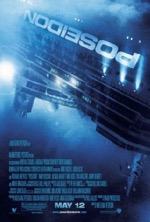
Starring: Josh Lucas
May 2006
“Mayday…Our Screenplay Has Capsized!”
With some movies, you can just tell going in that it’s destined to be a disaster. When you have that premonition during an actual disaster movie, it’s like adding salt (water) to an open wound. And, when that floundering disaster movie is a remake of a mediocre original, you know it’s time to refill your popcorn, because it’s going to be a long two hours.
Poseidon, the follow-up to Irwin Allen’s 1972 thriller dubbed The Poseidon Adventure, is such a movie. The original starred Gene Hackman, Ernest Borgnine, Red Buttons, Roddy McDowall and Shelley Winters. The update stars Josh Lucas, Kurt Russell, Jacinda Barrett and Richard Dreyfuss. Clearly the original cast edges out the new crew, but special effects honors go to the new movie. And if eye-popping FX were the only criterion on which a movie is judged, Poseidon would be up for a Best Picture Oscar this year. Fortunately, spectators are also looking for something called plot, a structure quickly jettisoned with the flotsam after the cruise ship is capsized by a rogue wave (okay!) and a handful of brave passengers embark on a dangerous journey through flooded decks and ventilation shafts (one of the only genuinely terrifying moments in the movie) to reach the top of the ship, which is now the bottom.
The exterior and interior design of the Poseidon cruise ship is radiant and elegant…it’s too bad we never have a chance to stretch our legs a little (as was masterfully accomplished in Titanic), before the disaster occurs. The movie wastes no time on character development…the ship is upturned near the twenty minute mark, long before we learn that Robert Ramsey (Russell) was a firefighter (Backdraft flashback) and, more importantly, former mayor of NYC. Robert is overprotective of his daughter, Jen (Emmy Rossum); she and her beau are joined at the hip on the ship, but they never find the right time to inform dad that they’re engaged before their lives are turned upside down, literally. There’s a potty-mouthed poker player named Lucky Larry (Kevin Dillon), who could have been a decent antagonist. Unfortunately, he’s killed off before we really even have a chance to start loathing him…another snafu with the script’s cursory attention to character and detail.
Dreyfuss, fittingly, plays Richard, an architect who serves as set-dressing and the movie’s token gay person. Lucas’ character is a card hustler named Dylan. Dylan seems to know everything about the ship—he guides the group each step of the way and seems to have the answer for every challenge (he’s even a step ahead of Robert in detecting the effects of a flash fire). Dylan takes a leadership role even though he claims to be a lone wolf…by the end of the movie he learns some teamwork skills, but does anyone care? As the picture’s supposed hero, Dylan fails miserably—the character isn’t noteworthy in any respect and his supreme confidence is off-putting (this is just another in a long string of uninspired performances turned in by Lucas…he’s no leading man).
However, in all fairness to Lucas, his performance isn’t what ails the movie the most; after all, the story is nothing more than one imperilment after the next and the dialogue is as leaden as the ship’s hull. Case in point: Dylan has a Eureka moment and proposes that the survivors exit the ship via the propeller shaft, stating, “The only thing between us and the outside is nothing!” (Did Yoda write the screenplay?)
Spoiler Alert: What’s supposed to pass as a major twist near the movie’s end is merely a rehash of Bruce Willis’ heroic demise in Armageddon…Robert sacrifices himself so that Jen and her new fiancé can have a chance to live. It’s ironic, but Robert’s struggle to find the emergency shutoff button, while his body spasms from the lack of oxygen, is the highlight of the movie—Russell delivers the finest underwater death scene I’ve ever witnessed in a film.
The movie’s paint-by-numbers conclusion is predictable and unsatisfactory in every way (i.e. there’s a handy raft nearby and the rescue helicopters arrive within minutes). A more interesting climax would have shown the survivors being eaten by some famished sharks…at least that would’ve provided us with some drama. Poseidon is a listing, floundering affair that comes complete with deep water and shallow characters. It works as mindless entertainment, but fails to live up to the original and doesn’t even belong in the same category as director Wolfgang Petersen’s previous sea-faring films: Das Boot and The Perfect Storm. There’s little adventure in this Poseidon!
Rating: 2
Just My Luck (PG-13)
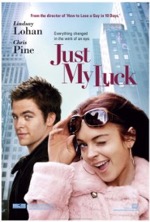
Starring: Lindsay Lohan
May 2006
“Polar Opposites Attract in Lucky Lohan’s Love Story”
Years ago I had a roommate who was unbelievably lucky; if it wasn’t for the fact that he was such a genuine, charismatic, decent, all-around good guy who deserved every gift that was ever lavished upon him, I probably would have gone stark raving nuts. Were it anyone else, I would have been nauseous every time the woman behind the bakery counter gave him an extra cookie for free, or when a generous stranger sold him a car for a dollar after learning he was without transportation (the honest to goodness truth). But, I can’t begrudge my ex-roommate any of this; he’s a quality person, someone who can walk right up to anybody and become their best friend within five minutes. The funny thing is…his ability to seem helpless, and thereby receive countless acts of charity, was completely lost upon him until I pointed it out to him. He eventually came to the realization that his was truly a charmed life. Perhaps you know someone like this.
When it comes to luck, Ashley Albright (Lindsay Lohan), reminds me of my ex-roommate. A spirited and overly-optimistic debutante, Ashley has everything going for her; beauty, talent, wealth and most of all, luck…the second she steps outside into a downpour, the rain, as if sensing her presence, ceases to fall. Ashley’s never known a loosing lottery ticket and when she hails a taxi, every cab in the vicinity converges upon her position. Her polar opposite, Jake Hardin (Chris Pine), is a walking calamity; Jake’s an affable, well-intentioned young man who just has terrible luck…when it’s not raining on him, pigeons are pooping on him. And, just when it looks as if his fortunes might change (Jake finds a five dollar bill in the trash can), he discovers that fate has played a nasty trick on him (he picks up the bill and gets warm, mushy poodle poop all over his hand).
Ashley and Jake eventually meet at a masquerade party. Jake ushers Ashley onto the dance floor, and in a fateful moment of passion, they engage in a lingering kiss that reverses their luck. Ashley becomes a hapless klutz and gets a taste of how folks live on the other side of the luck spectrum…she’s fired from her job and thrown in jail for unwittingly setting up her boss (Missi Pyle) with a male escort. Jake’s fortunes immediately change for the better; he saves the life of a big shot record producer and secures a contract for the band he’s been promoting, McFly (an obvious homage to Back to the Future). McFly is poised for their big break, but when Ashley kisses Jake to get her good luck back, things come crashing down upon Jake and the band. Ashley’s conscience forces her to make a terrible (by chick flick standards) choice: In order to get the man of her dreams, she must give up her life of ease and forever be unlucky.
Lohan has come a long way from her Parent Trap days, but it’s as if she’s got one wing outside the cocoon and is just waiting for the right role to come along to free her from her teeny-bopper chrysalis and establish her as a full-fledged movie star. Lohan is superstitious in real life, which perfectly plays into her part and the story in general; but we’ve seen the whole “role reversal” gimmick before in some of her other movies, most notably, Freaky Friday. It’s high time for Lohan to turn over a new (tea) leaf, and play a part that has some depth and believability.
Pine is a breath of fresh air in the movie, and if the film is successful in any way, it’s due in large part to his skilled portrayal of a young man plagued by Murphy’s Law. We can identify with his character more than Lohan’s because he’s a guy who’s making his way in the world while just trying to make it through the day…Lohan’s debutante is a spoiled brat who deserves her comeuppance when she looses her luck.
Director Donald Petrie (Miss Congeniality) has served us up a reheated version of Danny Glover and Martin Short’s Pure Luck. In that film, unlucky Short is hired to find the missing daughter of a wealthy businessman. In the end, the theory that one unlucky soul will find another is proven true in the highly amusing tale. Whereas, Pure Luck is a comedy; Just My Luck is a chick flick replete with silly scenes like the sudsy explosion in Jake’s laundry room or the sequence where Ashley kisses twenty guys in an attempt to find the man who stole her luck. The movie tells us that “the wheel always spins back.” Maybe the wheel can give me back my two hours…that would be lucky!
Rating: 2
Mission Impossible III (PG-13)
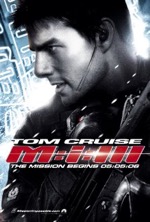
Starring: Tom Cruise
May 2006
“Abrams Sets His Cruise Control on Full Throttle”
Your mission, should you choose to accept it, is to determine if number three measures up to the first two Mission Impossible movies. After a six year sabbatical, Tom Cruise has finally reprised his role as uber-spy, Ethan Hunt, leaving behind him Woo’s woes and finding new direction from small-screen alchemist, J.J. Abrams.
With most movies, it’s expeditious to pick one or two key scenes and build a review around them. That practice is made virtually impossible by M:i:III, which contains so many high-impact action sequences and jaw-dropping twists, a detailed review could easily take up ten pages. Truth is, most movies claiming to be packed with nonstop action scenes couldn’t hope to keep up with M:i:III—it’s that fast-paced.
I could go into detail about the opening rescue attempt involving a frenetic shoot-out and a thrilling helicopter pursuit through a field of hydraulic windmills, or the well-executed, Bond-like break-in of the Vatican, or Cruise’s riff on Jack Bauer when he threatens to jettison antagonist Davian (Philip Seymour Hoffman) from a cruising plane, or the taut action sequence on the bridge when Ethan and Co. are pinned down by rocket-launching jets or any of a half dozen other great action scenes, but I won’t. The one scene worth focusing on is the teaser, which becomes a wraparound near the movie’s climax. The face-off between Hunt and Davian succeeds on a variety of levels: 1.) it sets the tone for the rest of the movie, 2.) it introduces nefarious Davian and the serious threat he poses, and most importantly, 3.) it hooks the female audience by placing Ethan’s fiancé, Julia (Michelle Monaghan), in harm’s way—Davian threatens to kill her unless Ethan provides him with the location of the Rabbit’s Foot, the movie’s MacGuffin.
My wife isn’t a fan of action movies, by any stretch, but she was engaged the entire movie because she had to find out what happens to Julie. Let’s face it, this kind of movie is squarely aimed at the masculine set, but it was an unqualified masterstroke by writers Alex Kurtzman, Roberto Orci and Abrams to involve the female spectators in such a tangible and personal way…this is an action film that even women will enjoy. Of course, many female viewers would visit the multiplex just to see Cruise in a tight, sweat-drenched T-shirt and running for his life—as he does in 90% of his roles.
Despite sofa-jumping shenanigans, Cruise’s acting has steadily improved over the years; his performance here is multi-layered, emotional and believable, thanks in large part to Hoffman, who, by his very presence, forces Cruise to bring his A game. Cruise flexes his acting muscles and musters just enough star power to pull off the part. The sheer physicality of the role glosses over any acting deficiencies, and as such, Ethan Hunt is the perfect role for Cruise…it’s demanding physically, but isn’t overly demanding dramatically.
Hoffman’s Davian is one of the finest, cold-blooded villains to grace an action movie in recent years. Unscrupulous and devoid of compunction, Davian is a driven man who will stop at nothing to get what he wants; he doesn’t even flinch when Ethan threatens to cut the solitary cord that anchors his seat to the plane. Thanks to Hoffman’s unforgettable performance, file Davian under “Delectable Villain.”
Besides the main action, the intrigue at the IMF between Hunt, Musgrave (Billy Crudup) and Brassel (Laurence Fishburne) also sustains interest throughout the movie. The writers do an excellent job of dealing out reverses until they finally reveal the mole during the movie’s harrowing climax.
M:i:III is an exhilarating, pulse-pounding thrill-ride that starts out in high-gear and refuses to slow down for stragglers. The only disappointment I have with the movie is that Cruise’s price tag—an unprecedented 200 million—will undoubtedly sink the project and cast a pall of uncertainty over future MI missions. Speculations aside, M:i:III fulfills its mission with vigor and panache, and as such, this review will self-destruct in five, four, three…
Rating: 3
Akeelah and the Bee (PG)
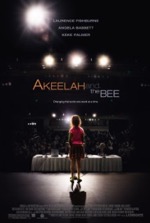
Starring: Keke Palmer
April 2006
“This Bee Might Not Sting, but It Sure Inspires”
In many ways, young Akeelah Anderson (Keke Palmer), eleven year old African American student at south LA’s Crenshaw Middle School, is a living, breathing indictment against our education system. Brilliance so often goes unnoticed in overcrowded classrooms with beleaguered teachers destined to languish in a system that frequently fails to cultivate genuine talent, but rather, funnels students into the same general education model that’s endured for centuries.
Perpetually feeling out of place, Akeelah is bored to tears at school—she only turns in half of her assignments. For extra credit, Akeelah enters the school’s spelling bee and draws the attention of her principal and Dr. Joshua Larabee (Laurence Fishburne). Impressed by her raw talent, both men encourage Akeelah to enter the regional spelling bee. Akeelah initially resists, but after some minor cajoling from her elders she accedes and shows both her inexperience and potential at the competition.
Soon after, Larabee (can writer/director Doug Atchison’s play on words bee any more obvious?) becomes Akeelah’s coach and he immediately establishes some ground rules: jive talk is out; learning the roots and origins of words is in. Among the many challenges the word wizard faces is Akeelah’s toe-in-the-dirt demeanor, which comes complete with poor eye contact and church mouse decibel speech. Larabee instructs the youth, “You can’t be a shrinking violet.”
As Larabee continues broadening Akeelah’s understanding of the power of language, Akeelah’s overprotective mother (played to perfection by Angela Bassett) catches wind of her daughter’s extracurricular activities and forbids Akeelah’s participation. This subplot reminds me of a similar scenario in Sister Act II when Lauryn Hill’s controlling mother prohibits her from singing. Fortunately, the story doesn’t get bogged down over this plot point but focuses more on the stimulating practice sessions and nail-biting competitions. Though much of the narrative is predictable up until the Scripps National Spelling Bee, the finale showcases some excellent acting and an unpredictable, wholly satisfying surprise ending.
In its broad strokes, Akeelah reminds me of the similarly themed family film Searching for Bobby Fischer (1993). Both movies feature a prodigious youth attempting to advance amid fierce competition, a tough yet caring tutor, a heart-stopping finale and a memorable supporting performance by some guy named Fishburne. The young phenoms in both movies also exhibit humility and good sportsmanship…refreshing qualities to see in young people even if they are merely projections on a screen.
Akeelah is the first movie co-produced by Starbuck’s Entertainment…yep, the coffee juggernaut isn’t satisfied with simply serving millions of lattes and getting filthy rich off of people’s hijacked taste buds. Now they must make movies too…so that people have something to do while drinking more of their product. Oh, I know a word for that: I-N-S-I-D-I-O-U-S.
Despite its dubious production company, Akeelah is an inspirational movie for all ages and subtly drives home the importance of community, friendship and perseverance. Akeelah is a feel-good, follow-your-dreams film that manages to keep the schmaltz factor to a minimum while delivering a heartfelt message one carefully chosen word at a time. So, if you have a penchant for hearing preternatural preteens promulgating pulchritudinous profundities, Akeelah is the movie for you. Word!
Rating: 3
The Sentinel (PG-13)

Starring: Michael Douglas
April 2006
“Paranoid Thriller Hits the Mark with Star Power and a Taut Plot”
The Secret Service: one of the most well-trained, well-equipped and well-informed agencies on the planet. Fiercely loyal to America and the president, Secret Service officers represent the finest our country has to offer—unswerving patriots who would gladly die to protect national security. Pete Garrison (Michael Douglas) is such a man—he took a bullet for Reagan in 1981. In today’s terror-filled world replete with blurred lines and shifting loyalties, the haunting question has become: Could such a man be bought, and if so, at what price? Could there be spies in our country or traitors among our government’s elite force, the president’s last line of defense?
As the movie opens, new intelligence suggests that an attempt will be made on the president’s life (a daily occurrence in real life) and that there’s a mole inside the Secret Service. An agency-wide mandate requires all agents to subject themselves to a lie detector test. Pete fails the test, and when a fellow agent turns up dead, suspicions, naturally, are cast in Pete’s direction. Pete’s protégé, Dave Breckenridge (Kiefer Sutherland) and his newly assigned assistant, Jill Marin (Desperate Housewives’ Eva Longoria) are given the task of locating Pete and bringing him in on the charge of treason—a task Dave eagerly accepts since Pete slept with his wife years earlier (ironically, Pete is currently having an affair with the 1st Lady, played by Kim Basinger).
What ensues is a chase somewhat reminiscent of Harrison Ford’s flight from the U.S. Marshals in The Fugitive. The pursuit ends at a shipping yard where Pete makes a convincing argument for his innocence…Dave lets Pete escape. Later, Dave becomes more convinced of Pete’s veracity when he finds Pete running tests at Langley. Dave surmises, “A guilty person wouldn’t break into a crime lab to prove his innocence.”
One of the more pulse-pounding scenes in the movie is where an agent flips a coin and unwittingly determines the president’s fate: heads, the president goes in a motorcade, tails, he takes a helicopter. In a sequence seemingly spliced in from Sutherland’s 24, a rocket sails through the air, collides with the helicopter and transforms it into a plume of smoke, flame and debris. Fortunately, fate and the coin sent the president home in the motorcade instead of the helicopter.
The other standout scene, at least for testosterone-driven viewers (let’s face it, the movie’s target audience), is the final shootout at the political summit in Toronto. An assassin casually sits in a stairwell and picks off anyone who comes around the corner—hoping to score a hit on the president. Again, fortune smiles upon the pinned-down president when one of the mole’s accomplices has a change of heart and dies protecting the commander-in-chief. Pete and Dave arrive, not a moment too soon, and take out the assassin and his cronies. A tenuous friendship forms between ex-partners in the contrived dénouement; the movie’s feeble attempt at forcing a happy ending where one isn’t required.
The Sentinel has an identity crisis of sorts—the focus keeps bouncing back and forth between Pete and Dave like a tennis ball at Wimbledon. The movie isn’t a vehicle for either Douglas or Sutherland, but is, ironically, better off for just that reason…a film spotlighting either character, exclusively, would have flopped. As it is, The Sentinel has just the right mix of action, suspense, romance, political intrigue and character dynamics to please a wide range of potential spectators. It’s a B movie that aspires to be an A tier film, and somehow manages to pull off that feat with A-list performances, deft direction by Clark Johnson and a taut screenplay written by George Nolfi, based on the novel by Gerald Petievich. The Sentinel is a good popcorn flick, no doubt, but it’s also a sober reminder of the changing face of terror.
Rating: 2 1/2
Ice Age: The Meltdown (PG)
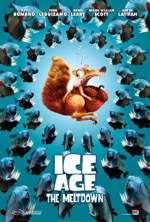
Starring: Ray Romano
March 2006
“Frigid Sequel Lacks the Warmth of the Original”
As if Al Gore’s treatise on global warming, An Inconvenient Truth, wasn’t sufficient enough, the much publicized, highly controversial topic is now the centerpiece of an animated film; namely the sequel to Ice Age, subtitled The Meltdown. The movie, presumably, takes place a short time after the events of the first film and furthers the misadventures of Sid the Sloth (John Leguizamo), Manny the mammoth (Ray Romano) and Diego the saber tooth tiger (Denis Leary). Oh, and of course we can’t forget Skrit or his eternal quest to possess that one elusive acorn in the ever amusing series of silly sidebars.
As the title would suggest, the first movie dealt with prehistoric animals migrating at the onset of the ice age. This time around the ecological calamity is a melting glacier, which floods the ice plain and drives the creatures from their homes. While doomsayers sway susceptible dinos with apocalyptic warnings that the end of the world is at hand, hucksters like Fast Tony (Jay Leno) use such alarmist propaganda as a means of turning a profit; as one of the more interesting new characters, it’s too bad we didn’t see more of Fast Tony in the movie.
In a feeble attempt at expanding our knowledge of the prehistoric trio, the writers have introduced new challenges for each of the main characters to overcome. For Sid, the issue is his need for respect. Sid never receives any respect from his companions but he finally finds some when he encounters a tribe of mini-sloths, who abduct Sid and reverently dub him “Fire King.” Sid basks in their adulation until they attempt to sacrifice him over a pit of molten lava. No respect there! Sid must be the distant ancestor of Rodney Dangerfield.
Diego faces his greatest fear when the glacier starts melting; swallowing up the last patches of dry land, the encroaching water makes Diego’s passage to the other side of the valley a hair-raising one. In jest, Sid gives Diego this tip, “Land safe, water not safe.”
Manny’s plight is the most desperate; all evidence points to Manny being the last living mammoth. Manny is crestfallen over that grim reality until the company encounters Ellie (Queen Latifah), a female mammoth who hangs with two dimwitted, thrill seeking possum sidekicks, Eddie (Josh Peck) and Crash (Seann William Scott). Headstrong Ellie refuses to accept that she’s a mammoth (having been raised by possums, Ellie believes she is one), and challenges Manny’s asserted leadership at every turn. This might explain why mammoths are extinct.
The real trouble here, besides the contrived, gift-wrapped resolution, is that the movie has no antagonist. To be sure, there are several internal struggles which sustain viewer interest for a time, but the convenient climax effectively lifts the pressure cooker lid and releases any steam the movie’s been building. Other than the titular thaw, the only story element that ratchets up the tension is the intermittent danger presented by two deepwater creatures (the alligator-like reptiles may be a little too frightening for younger children).
The CG animation, which shows a vast improvement in quality over the first film, is the only element that’s superior in this appropriately dubbed sequel. The characters aren’t as fun or funny here, and even Skrit’s gags seem recycled. With the series already growing tired, one can only hope that 20th Century Fox will deep freeze the series until the studio can commission a script that will better service the characters and the audience. The last thing we need is for the once charming Ice Age to devolve into The Land Before Time.
Rating: 2
She’s the Man (PG-13)

Starring: Amanda Bynes
March 2006
“Gender-bender with a Twist of Teeny Bop”
Viola (Amanda Bynes) is an incurable teenage tomboy who would rather be playing beach volleyball than helping out in the kitchen, much to her mother’s eternal chagrin and disapproval. Viola is also an excellent soccer player, the best on the team in fact; but Viola’s dream of carrying her team to a championship is abruptly shattered when she learns that the women’s soccer team at her high school has suffered sudden death.
Viola’s mother isn’t very sympathetic when she receives the “bad news;” with soccer cancelled, Viola’s mom strongly encourages the youth become involved with woman’s socials to learn the finer points of being a woman. When Viola stubbornly refuses, her exasperated mom replies, “Sometimes you’re just like your brother.” In that instant, a plan coalesces in Viola’s mind; her twin brother, Sebastian (James Kirk), will soon be taking an extended trip to Europe, leaving an open roster spot on the men’s soccer team at the upper-crust academy he attends.
Yep, you can guess what happens from here. Gender confusion creates most of the problems, and humorous situations, in the movie, i.e.: Viola falls in love with her hunky roommate, Duke (Channing Tatum), while the hottest, most popular girl in school, Olivia (Laura Ramsey), falls for Viola…disguised as Sebastian. There’s an amusing scene at a carnival where Viola, as herself, anticipates a rapturous lip-lock with Duke, who’s manning a kissing booth. As fate would have it, Duke is rotated out one girl before Viola. Dejected, Viola changes back into her Sebastian disguise, but then her mom shows up and she has to quickly change back; the scene recalls Robin Williams’ cross-dressing high jinx in Mrs. Doubtfire. The nerve-wracking complexities of leading a double life are painfully multiplied when Sebastian arrives home a day early and inadvertently ruins all of Viola’s well-laid plans.
Bynes does an amazing job of approximating male speech and mannerisms; the movie’s success is largely due to her role-reversing performance. Her comedic timing is dead-on, especially in the scene where Duke’s friend discovers her stash of tampons and she has to quickly improvise her way out of the jam—funny stuff!
Though She’s the Man is little more than a teenybopper movie, which is loosely based on Shakespeare’s Twelfth Night, the excellent lead performance in tandem with a surprisingly respectable plot renders the movie enjoyable instead of merely tolerable. I commend the film for steering clear of any uncomfortable or controversial issues: there is gender-bending without breaking in a storyline that could’ve crossed lines, but didn’t.
She’s the Man is a bona fide crowd-pleaser, a popcorn movie in the truest sense and a message-free examination of the life of one teenage girl. Uh, boy. Uh, girl.
Rating: 2 1/2
The Shaggy Dog (PG)

Starring: Tim Allen
March 2006
“Sophomoric Silliness Abounds in Canine Resurrection”
If ever there was an ill-advised remake, The Shaggy Dog is it—actually the story has been rehashed so many times now, they need to put the poor old dog to rest once and for all. The original, released in 1959 and starring Fred MacMurray, Tommy Kirk and Annette Funicello, was a light, whimsical tale of a boy who could transform into a sheepdog by chanting an ancient spell. It was campy and had Disney’s family-friendly cheese slathered all over it, but the comedy fit the period and the story worked as an endearing testament to bravery and self-discovery.
Today’s audience, however, is much more sophisticated than that of decades past, and the new film, though star-studded (Tim Allen, Kristin Davis and Robert Downey, Jr.), lacks the insouciant charm of the original. In this version, Deputy D.A. Dave Douglas (Allen), is bitten by a 300 year old dog and transforms into a canine at Pavlovian intervals. As a dog, Dave gains a different perspective on himself (specifically his selfish and neglectful tendencies), his family and the world around him. Dave begins exhibiting strange behaviors, such as lapping up his cereal and growling in the courtroom. As silly as those moments are the parent/teacher scene, where Dave runs outside to tree a cat, and the scene where he steamrolls an old lady while pursuing another cat, are the height (or, more appropriately, depth) of inanity.
Davis (Sex and the City) is mere set-dressing in the movie. She just seems to stand around and scratch her head at her husband’s bizarre transformations; an egregious waste for such a skilled actress. Downey, Jr. plays a mad scientist who seeks to discover and patent the fountain of youth; capturing the ancient dog gives him the means to accomplish this lofty goal, but what could have been a meaty turn as a nefarious antagonist is reduced to a series of courtroom antics tantamount to Allen’s high jinks. Danny Glover and Jane Curtain are also among the cast—the D.A. and judge, respectively—but their considerable talents are wasted by director Brian Robbins and the wafer-thin screenplay which was, ironically, churned out by a team of eight writers.
Allen’s performance here has redefined the word “stereotypical.” This is the same old shtick he’s been getting by with for years, and if anything, it’s more obnoxious and less enjoyable than before. In the movie, Dave has a heightened sense of smell and the ability to converse with animals; too bad the actor playing him wasn’t perceptive enough to recognize an embarrassing role replete with remedial gags and cheap laughs.
The end result of The Shaggy Dog is similar to taking a poodle in for grooming—you don’t leave with very much. If the movie has a saving grace, it’s that it doesn’t overstay its welcome; kids will love it, but most adults will be glad when it’s Rover.
Rating: 1 1/2
Failure to Launch (PG-13)

Starring: Matthew McConaughey
March 2006
“Aptly Named Rom-com Never Gets Off the Ground”
From a marketing standpoint, someone should’ve pointed out the dangers of using such a negative word in the title: failure. Besides the negative connotation the word conjures up, the potential for a self-fulfilled prophesy should have prompted studio executives to demand—in no uncertain terms—a name change. As things stand, the titular condition is the perfect diagnosis for the movie’s halfhearted performances and a story that, despite its best efforts to take flight, never achieves liftoff.
Finding anything redeeming here, much less entertaining, is nearly impossible. For starters, Matthew McConaughey and Sarah Jessica Parker have absolutely no chemistry whatsoever, which makes buying into the romance subplot extremely difficult. Also, Tripp’s (McConaughey) overprotective parents—meddling mom, Kathy Bates and daft dad, Terry Bradshaw—are one breakdown shy of the loony bin. This, of course, begs the question of why an adult would choose to live with such certifiable progenitors. One can only put up with so much in exchange for free room and board. I mean, if my father insisted on walking around the house in the buff as Tripp’s dad does (for several excruciating, eye averting minutes of onscreen time) I’d pack my things and take up residence on a friend’s couch before you could say nudist.
Tripp’s buddies play the usual well-meaning, advice-giving friends, but are one-dimensional stock characters whose sole purpose in the movie is to provide comic relief. The only peripheral cast member who actually offers some depth of character is Paula’s (Parker) sister, Kit (Zooey Deschanel). Kit is a lonely young woman with real emotions and real needs. A movie centered on her character’s plights would have been eminently more satisfying.
The movie has a modicum of clinical psychology and a ton of hyper-real situations that are designed to keep the audience rolling in laughter for two hours so that they don’t realize that they’ve been duped into enjoying a movie that has no plot. Failure to Launch is a prime example of what ails modern comedy films: it delivers the sizzle when audiences paid for a steak.
In all fairness, there are a few scenes that divert attention away from the insipid love story and the dysfunctional arrangement on the home front, but these moments are few and far between. Though the paintball skirmish and rock climbing wall excursion add some much needed energy to the stuck-in-neutral narrative, both sequences rely too heavily on standard comedy gimmicks and only garner cheap laughs which make them instantly forgettable. Sad to say, but either of these “action” scenes could be dropped into any other modern rom-com and they would work just as well. As such, Failure to Launch is just another “template” story (see my review for Eight Below).
In the end, Failure to Launch desperately tries to be clever but fails miserably with its anemic screenplay and characters that annoy more than they interest. Even the movie’s considerable star power couldn’t deliver enough thrust to get the leaden plot payload off the ground. Hollywood, we have a problem…we need a better script!
Here’s a scary thought: with the earth’s increasing population and the diversity of styles and tastes that pervade our culture, Failure to Launch is bound to be someone’s favorite film. Be very afraid!
Rating: 1 1/2
16 Blocks (PG-13)
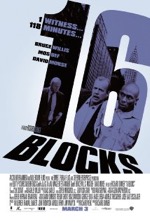
Starring: Bruce Willis
March 2006
“Dark and Gritty, But Not Sin City”
In Richard Donner’s 16 Blocks, Bruce Willis plays Jack Mosley, a haggard, beleaguered NYPD detective who drinks on the job and hobbles around on a bum leg—in other words, the very antithesis of John McClane from Willis’ Die Hard movies. And yet, this is one of Willis’ most refreshing roles in ages; by playing against type, he may have just rejuvenated his career…at least until the release of Die Hard 4.
The movie’s premise is basic enough—Jack must transport a witness, Eddie Bunker (Mos Def), sixteen blocks to the courthouse so that Eddie can testify and bring down six bad cops—but hit men and Jack’s crooked ex-partner, Frank Nugent (David Morse), make the sixteen blocks a serpentine maze of high stakes and narrow escapes. The time constraint (Jack must get Eddie to the courthouse in less than two hours) amps up the drama and a nicely executed twist near the movie’s climax hoists the movie to a level just above the standard action/thriller.
Though the bus sequence reminded me too much of Speed, some of the other action scenes were exceptionally well-crafted; like the hit on Jack’s car while he’s in the liquor store, or the stand-off in the bar or the shoot-out behind the restaurant, which is preceded by an intense verbal sparring match between ex-partners (Frank implores Jack to look the other way and hand over the kid).
Bullets are cheap in the movie, but between pulse-pounding action sequences a fair amount of attention is given to character analysis; such as Eddie’s perpetual death grip on his notebook. We eventually learn that the book is full of recipes—Eddie’s dream is to open a bakery where “every day is a birthday.” Eddie’s nasal delivery gets old after five minutes and his obnoxious blustering gets old even quicker; there’s only one instance in the movie where his effusive small-talk comes in handy…the rest of the time it nearly gets him and Jack killed. At times, you have to resist the urge to yell, “Shut up, already!” at the screen (a fellow spectator remarked, “The trick is to keep him from being killed without killing him.”). Perhaps Jack said it best, “Life’s too long and it’s people like you that make it longer.”
Jack is a fascinating, multi-layered protagonist: he tells Eddie, “I’m not a good guy,” yet when he tape records his last will and testament Jack claims that he’s “trying to do a good thing,” and certainly follows through with that intention at the movie’s climax. One thing I don’t like about the movie (other than Eddie’s excessive chin-wagging) is Jack’s change of heart—it’s a good twist and makes for a pseudo-happy ending, but it lifts the lid on the pressure cooker, effectively letting out any steam the movie had been building. If Jack had come to his senses and decided to change his ways earlier, Eddie would have been imperiled far less and fewer casualties would have been suffered along the way…in essence, Jack’s reformation makes all of the bullet showers and, in fact, Eddie’s very presence in the movie, utterly unnecessary.
Eddie’s parting encouragement to Jack, “People can change,” is a bit maudlin, but the point is well-taken; especially for typecast action stars desperately in search of a hit. 16 Blocks is a gritty urban drama that will satisfy hard-core action fans but will probably loose the rest of its audience somewhere between the precinct and the courthouse.
Rating: 2 1/2
Joyeux Noel (PG-13)

Starring: Diane Kruger
March 2006
“Inspiring True Account of History’s Most Miraculous Truce”
Based on the incredible true story of the night peace and good will visited the trenches of French, Scottish and German soldiers during WWI, Joyeux Noel (aka Merry Christmas) chronicles the events surrounding history’s most astonishing ceasefire. On Christmas Eve, 1914, a German tenor started singing “Silent Night” and, upon recognizing the sacred Christmas carol, French and Scottish soldiers added their voices to the multicultural chorus from across the blood-soaked, corpse-littered battlefield. A miraculous event transpired when white flags ascended and soldiers from both sides descended upon the soiled plain; soon mortal enemies were communicating with each other (with only gestures in some cases), trading valuables and proudly showing off pictures of loved ones.
At the conclusion of a solemn Latin mass officiated by a Scottish priest, the three leaders had a summit and mutually agreed to lay down arms and sort out the fallen soldiers the next day. On Christmas day, one soldier ironically observed, “We’re burying the dead on the morning when Christ was born.” The day after Christmas presented a perplexing challenge as many of the soldiers on both sides struggled with resuming combat—men with whom they had played a friendly game of kickball the day before were now lined up in their crosshairs. Having seen the face of the enemy, many were reticent or flat-out refused to fight.
The irony of the story is how perspective can paint or taint our reality. For many of the soldiers, once the floodgates of friendship and mutual understanding had been flung aside, there could be no going back to the clear-cut, good guys/bad guys patriotism that prevailed in their home countries. The repercussions of treating the enemy with the tiniest shred of humanity were severe—most of the soldiers were sent home in disgrace, branded as traitors and replaced by fresh troops who were all too eager to raise the Sword of the Lord against the unholy hoard that was the German army. Though this makes for a bittersweet ending, Joyeux Noel, as a whole, is uplifting and inspirational, and the movie’s salience, in light of current events, is profound.
Despite the exemplary effort exhibited by the costuming, props and art departments, the movie suffers from slow pacing and static direction from writer/director Christian Carion, especially in the early goings. The only familiar face among the cast is Diane Krugger (National Treasure), who plays Anna Sorensen, an opera singer and wife of the German soldier who initiates “Silent Night.” The rest of the cast is comprised of foreign actors who adequately inhabit their roles with three standout performances: the singing German soldier, the French commander and the Scottish priest, who is the beneficiary of the best lines in the movie.
Joyeux Noel will undoubtedly find its place among the vast catalog of seasonal treasures, but the movie will be remembered more for its political commentary than for its Christmas-related story elements, which, though vitally important, comprise a very small part of the overall plot. They say music is the universal language, and if sworn enemies can find fellowship and common ground in the midst of the hellish realities of war, the adage is supremely accurate.
Rating: 3
Eight Below (PG)
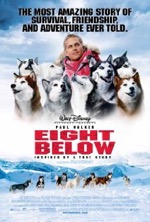
Starring: Paul Walker
February 2006
“Standard Arctic Survival Tale Will Leave You Cold”
Most desktop publishing applications for computers come with templates or wizards—quick helps that allow the user to customize pre-existing models, often in order to save time and effort. When it comes to storytelling, there are a limited number of plots (templates), but what makes each story unique is the location, the execution of the plot, the different types of characters and how those characters interact with each other.
In the case of Disney’s new “based on a true story” family film, Eight Below, the writers and producers—in what they probably thought was a low-risk, high-profit move—have simply given us the template itself. Arctic (or Antarctic) survival stories have been done so many times that anyone attempting such a project should approach it with a great deal of caution and trepidation…and more than just a few original ideas. Unfortunately for Eight Below (which is really a misnomer—eight refers to the number of sled dogs, but the temperature dips well below minus fifty degrees in the movie), it offers nothing new, but banks on cute dogs and maudlin moments to bail out the unoriginal screenplay and uninspired performances.
Jerry Shepard (Paul Walker) and his colorful companions, motor-mouth, Charlie Cooper (American Pie’s Jason Biggs) and Native American hottie, Katie (Moon Bloodgood), work at a base at “the bottom of the world.” Jerry, an experienced survival guide, begrudgingly transports American geologist Davis McClaren (Bruce Greenwood) to nearby Mt. Melbourne, where meteorites from Mercury have reportedly landed. Along with his team of well-groomed, well-trained dogs, Jerry totes McClaren and his equipment across the frozen, Antarctic plain, which is filled with bottomless crevasses, patches of thin ice and frightening leopard seals. The expedition is cut short when a massive snow storm moves in; the race home nearly costs McClaren his life (I wish I had a dollar for every time he falls in the movie) and Jerry’s fingers to frostbite. The base is evacuated and the dogs are left behind with the intention of immediately returning for them, but the severity of the blizzard prohibits any flights from returning to the base until the next spring. What ensues is tantamount to The Incredible Journey as the dogs break free from their chains, work together as a team, and feast on seagulls and a beached killer whale (the best visual in the movie) until they’re rescued by Jerry and his reassembled team…some 180 days after being stranded.
Director Frank Marshall does an adequate job with mediocre material; a script suggested by the real life Japanese expedition to Antarctica in 1957. Unfortunately, Marshall doesn’t receive any assistance from his gelid, no-name cast, and in the end, it’s only the sled dogs that are remotely memorable (Mya in particular). Some would argue that this formula still works, judging from the sniffles heard among the audience at tear-inducing moments, but this brand of sentimental survival tale reached its height somewhere in the late 70’s with the Robert Logan pictures. Suggested improvements for the sequel: have the dogs deliver the lines and let the leopard seal eat McClaren.
Rating: 2
The Pink Panther (PG-13)
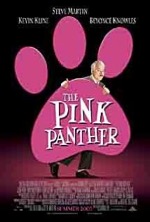
Starring: Steve Martin
February 2006
“Martin is Most Amusing When He Doesn’t Have a Clue”
Inspector Jacques Clouseau has been on quite a sabbatical. Last seen in 1993’s Son of the Pink Panther, it had been nearly twenty years before that when the brilliant Peter Sellers had finally hung up his detective’s hat after successfully playing the clumsy Clouseau in all four of the original Pink Panther movies.
This Pink Panther caper opens at a World Cup finals match between China and France in Paris. When the revered French coach is murdered by a poison dart at the conclusion of the contest and the famous Pink Panther diamond turns up missing, French police immediately launch an investigation. Chief Inspector Dreyfus (Kevin Klein) hatches a plan to catch the killer, an accomplishment that will solidify his claim on the elusive Medal of Honor—Dreyfus has been passed up for the coveted prize seven times. Dreyfus’ plan is to commission an incompetent cop to distract and divert the killer while he and the finest team of investigators in all of France nab the miscreant. The “perfect man” for the job is Jacque Clouseau (Steve Martin), a bumbling idiot and walking calamity, who mistakenly thinks his promotion to the rank of inspector is based on merit. What ensues is a witless investigation brimming with gags, double entendres and abject lunacy. Half the time I rolled my eyes, the rest of the time I was rolling on the floor at Martin’s unrelenting antics—he was the perfect choice to play dunderheaded Clouseau.
The movie’s storyline is essentially one catastrophe after the next. Some of my favorite moments are Clouseau’s alternate good cop/bad cop routine, Clouseau’s conversation with the Asian woman and the scene where Clouseau and his deputy sneak into Dreyfus’ ball in disguise. The movie’s creative highlight is when Clouseau crosses paths with 006—besides being uproariously funny, the scene features a nice bit of surprise casting.
And speaking of casting, the supporting characters add wonderful color and texture to the film, especially Ponton (Jean Reno), Clouseau’s vigilant deputy, Nicole (Emily Mortimer), Clouseau’s love interest, Xania the singer (Beyonce Knowles) and Yuri the trainer who trains (Henry Czerny). Martin and Klein are brilliant together, as are Martin and Reno; the scenes where Clouseau initiates random attacks on the deputy are idiotic and yet I still laughed. Perhaps that’s the film’s secret weapon; even when you don’t want to laugh, you end up doing it anyway…the movie is insidious that way.
Though The Pink Panther is replete with slapstick silliness, it’s also one hundred percent entertaining. Whether or not box office returns warrant a sequel, Martin’s Clouseau tickled me pink!
Rating: 2 1/2
Firewall (PG-13)

Starring: Harrison Ford
February 2006
“High-Tech Thrill Ride with an Old Ford”
Last seen in Hollywood Homicide (or rescuing disoriented hikers with his helicopter); Harrison Ford has staged a significant comeback with Firewall, a taut cyber-thriller from writer Joe Forte and director Richard Loncraine. In my review for Hollywood Homicide, I wrote, “Unlike some naysayers, I believe there’s still gas in the old Ford, but he needs to choose better films to act in…” Firewall is definitely “better” than his last outing, and though it fails to reach the level of intensity found in Air Force One, the movie is familiar territory for Ford and is, therefore, an ideal way for him to ease back into the routines and rigors of the biz.
Jack Stanfield (Ford) is a bright, hard-working bank security system designer who also manages to find time to be a family man. Jack’s wife, Beth (Virginia Madsen), is an architect and stay-at-home mom who keeps a watchful eye on their two quarreling kids, Sarah (Carly Schroeder) and Andy (Jimmy Bennett), and loyal pooch, Rusty.
On a rainy night in Seattle (which one isn’t?), a man jumps in the back seat of Jack’s car (nitpick: most people entering a car by themselves only open their door), points a gun at Jack’s head and tells him to drive home. Meanwhile, Beth answers the door for the pizza man and is accosted by several men toting guns and high-tech equipment. When Jack arrives at his home, he finds his family tied and gagged in the kitchen and a center of operations with fully-functioning computers and monitors set up in his living room. The leader of the outfit is a man named Cox (Paul Bettany in a typecast shattering role); he and his minions have been spying on Jack and his family for months in preparation for this heist. The plan is simple; while Cox and crew make themselves at home in Jack’s sprawling, beachfront mansion, Jack will go to work like normal and devise a way to hack into the system he designed. Jack must steal a hundred million dollars (virtual money) from the bank’s wealthiest investors, or his wife and children will be killed. The balance of the movie sees Jack scrambling to keep his family safe, while devising a way to prevent cold-blooded Cox (he kills his own men when they fail him, a la Vader) from getting even a dime.
The movie may be a tad slow out of the blocks, but once Cox initiates his plan, the movie transforms into a first-rate thriller where the hero has to stay one step ahead of the bad guys…or else. Ford enjoys solid support from Bettany and Madsen (Alan Arkin and Robert Patrick are throw-away characters, unfortunately, but 24’s Mary Lynn Rajskub plays a significant part as Jack’s secretary), but it’s his performance that really carries the movie. The character of Jack Stanfield isn’t as self-confident as Jack Ryan, nor is he as resourceful as Indy or as plucky as Han, but he’s really more interesting because he’s an “Average Joe.” The strength of this Jack is his “every day guy” appeal, which services this storyline far better than if he was one of those other guys—cut from hero’s cloth.
If the movie has a message, it’s that elaborate schemes can be quickly undone by everyday or unsuspected pieces of technology. Here are some examples: Cox puts a pen with a spy camera in Jack’s breast pocket to keep tabs on him, but Jack quickly figures out how to dump it off to a co-worker. Jack stages an escape in his house by using Andy’s remote controlled car to create static on the Cox’s security monitors. Jack uses Sarah’s iPod to download the account numbers of prominent bank lenders (to the machine, they’re just files), but Jack, wisely, takes a picture of the monitor screen with a cell phone and later returns all of the stolen money to the proper accounts from an airport bank. Jack ultimately finds Cox and his kidnapped family in an abandoned country house thanks to Rusty’s dog collar, which contains a G.P.S. sensor that can be tracked from the internet.
Despite gaping plot holes (i.e. Cox’s entire, ill-advised plan, which is made laughable when one considers the abundance of advance intel he had at his disposal), Firewall is an edge-of-your-seat thriller that climaxes with an old-fashioned fist fight and a heart-warming family reunion. Ford’s movements may be a little stiff, especially during action sequences, but he’s still the man. Welcome back, Harrison; don’t be a stranger!
Rating: 3
Curious George (G)

Starring: Will Ferrell
February 2006
“Curiosity Killed the Cat…But Not This Silly Simian”
First introduced in the 1941 illustrated children’s book by authors H.A. and Margaret Rey, Curious George is a simple character in a simple story from a simpler period of American history—a throwback to a more innocent age. What’s refreshing about George is that he doesn’t speak (unlike Disney’s vociferous menagerie); conveying emotions through gestures and facial expressions, he’s a more realistic and captivating alternative to the cutesy animated animals we’ve been subjected to in recent years. The movie remains faithful to the books, though some modifications have been made; the most notable change is that The Man in the Yellow Hat has been given a name...Ted.
Ted (Will Ferrell) works at a museum owned by Mr. Bloomsberry (Dick Van Dyke), a doting curator who favors Ted over his real son, Jr. (David Cross). With the museum in financial trouble and in desperate need of a new exhibition, Ted volunteers to join an expedition to retrieve the mythical idol at the Lost Shrine of Zagawa in Africa. Ted first encounters George when the monkey grabs his yellow hat, mistaking it for a banana. After Ted finds the idol and returns to the ship, George stows away and follows Ted all the way back to his NYC apartment. George immediately complicates Ted’s life by hand painting a neighbor’s flat, which results in man and monkey being evicted from the building. Matters go from bad to worse when Ted arrives at the museum to find a massive platform that’s been custom-built for the reportedly giant-sized idol (the actual idol fits firmly inside the palm of his hand). As restless patrons clamor to see the opening of the exhibit, Ted must enlist the help of an eccentric scientist, Clovis (Eugene Levy), and an attractive teacher, Maggie Dunlop (Drew Barrymore), to fend off Jr.’s efforts to discredit him, discover the “real” idol and somehow prevent George from destroying everything in sight before the museum is forced to close for good.
An element that really stands out in the movie (other than Jack Johnson’s cookie-cutter songs) is the vibrancy of the pastel palette employed by the artists and the ethereal rays that bathe the characters wherever sunlight is present. This warm glow, in tandem with the minimalist animation style, produces a serene mood that works in perfect harmony with the lithe and blithe storyline.
Though clearly geared toward pre-teens, there’s plenty here for adults to enjoy as well: take the jaded cabbie, for instance, who takes a cue from Tom Hanks in A League of Their Own when he yells, “There’s no screaming in cabs!” The shifty clerks who sell Ted a yellow outfit are also amusing; needing to clear out their inventory they claim that “yellow is the new khaki.” Though the blissful balloon rescue is a highlight in the movie, it’s really the trouble-making monkey’s boyish innocence that makes the movie soar.
Rating: 2 1/2
The World’s Fastest Indian (PG-13)

Starring: Anthony Hopkins
February 2006
“High-octane Biopic is Built for Speed”
The true story of intrepid Kiwi motorcycle racer, Burt Munro, is an inspiring journey of courage, determination and unyielding passion in the face of persistent adversity. Pushing his heavily modified, highly-experimental 1920 Indian Scout bike to insane velocities, Burt was built for speed. He tells Thomas, the neighbor boy, “You live more in five minutes on a bike going flat out than most people do in their lifetimes.”
Known about town as an eccentric hermit, Burt uses a power sander to file his toenails and an acetylene torch to heat a kettle of water for tea. He also pees on his lemon tree to help it grow. When Thomas’ father implores Burt to mow his lawn because it’s a disgrace to the community, Burt douses the ankle high grass with gasoline and sets it on fire. Some might mistake Burt’s quirky insouciance and hermit-like lifestyle for xenophobia, but nothing could be further from the truth. Burt’s the type of person who can make friends with anyone, anywhere, at any time. Individuals in pursuit of a dream generally attract a following, and so it is with Burt, who’s aided by a vast array of individuals as he makes his way from Invercargill, New Zealand to the Bonneville Salt Flats in Utah.
The culture shock Burt experiences when he reaches the US is poignant in an amusing way. Rude cabbies and soliciting prostitutes soon pale in comparison to the hotel clerk he encounters in Hollywood, a cross-dresser named Tina. Burt purchases a car from Fernando, who nearly has a coronary on the test drive when Burt drives on the wrong side of the road. When Burt’s jury-rigged bike hitch looses a wheel, a Native American named Jake helps with repairs and also gives Burt something to help with his failing prostate (a powder made from ground up dog testicles). Despite considerable and frequent setbacks Burt never once looses his sense of humor—his strength of will and persistence of vision fuel his drive to fulfill a lifelong dream.
Although it’s been said a dozen times before, this is one of Anthony Hopkins’ finest performances. Hopkins wholly inhabits Burt and endues the dotting daredevil with a dignity and morality that’s quite refreshing. Tour de force doesn’t even come close to describing Hopkins’ masterful turn; not only does he anchor the film, as the only marquee name in the cast, he is the film.
The World’s Fastest Indian is a gem of an indie flick that comes with a heartening reminder that it’s never too late to pursue a dream. The reason why Hollywood has been so heavily criticized for the frequently lacking body of work it produces? It doesn’t make enough movies like The World’s Fastest Indian. The film is a rare cinematic treasure that you’d do well to rush out and see.
Rating: 3 1/2
Last Holiday (PG-13)
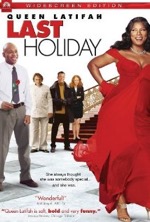
Starring: Queen Latifah
January 2006
“Delightful and Inspirational Carpe Diem Comedy”
“There are always possibilities,” or so the saying goes. Retail worker for Kragen department stores, Georgia Byrd (Queen Latifah), has an album full of dreams, labeled Book of Possibilities. In it are favorite recipes of foods she can’t eat, brochures to vacation spots she can never afford to visit and cut and paste fantasy wedding pictures of her and her hunky co-worker, Sean Matthews (LL Cool J). Georgia takes a picture of the meal she just created while watching her idol, Emeril Lagasse, on TV, pastes it in the album and wistfully dreams of all the things she could experience, if only…
One day at work, while trying to impress Sean, Georgia accidentally bumps her head and is taken to a nearby clinic. A CAT scan reveals that Georgia has multiple brain tumors…she’s given three weeks to live. After leading her congregation in a rousing, impromptu gospel song entitled “Why me, Lord?,” Georgia cashes in her bonds, heads for the Czech Republic and stays at Hotel Pupp (pronounced like the stuff dogs leave on lawns). While checking in, Georgia overhears that a big business meeting will take place at the hotel between corporation owner, Matthew Kragen (Timothy Hutton), his paramour, Ms. Burns (Alicia Witt), a congressman and the senator of Louisiana. At dinner, Georgia breezes into the hotel restaurant wearing a dazzling European dress and commands the attention of every waiter when she orders all four specials, which further elicits the attention of world-renowned Chef Didier (Gerard Depardieu), who immediately takes a liking to Georgia and later allows her to create meals in his kitchen. Assuming Georgia comes from money, the business party befriends Georgia and includes her in such activities as skiing, base jumping and gambling; Kragen tries competing with Georgia and ends up looking like a fool in each instance. While Georgia continues spending money, enjoying life and making new friends, Kragen, pays off a housekeeper to discover the secret to Georgia’s real identity.
A remake of Alec Guinness’ 1950 movie of the same name, Last Holiday features memorable performances from an assemblage of journeyman actors (and cameos by Emeril and Smokey Robinson) and a heart-warming story that analyzes the brevity of life without waxing preachy. In the history of cinema, there have been plenty of three-weeks-to-live plots, but none have been delivered with this much insouciant charm. Queen Latifah’s performance is remarkable as Georgia Byrd, a woman you just can’t help but admire for her spunk and new-found lust for life; emboldened by her terminal illness, Georgia tells another character, “I wasted too much of my life being quiet.” There’s a wonderful scene where Georgia looks into the mirror and tells herself that the next time “we will laugh more, love more, see the world…we just won’t be so afraid.”
From the colorful characters to the inspirational story to the on location footage shot in a cozy European village, there isn’t a single misstep in director Wayne Wang’s (Because of Winn-Dixie) feel-good flick. Last Holiday is an amusing tale wrapped around a subtle reminder to make the most of every moment. And to always get a second opinion!
Rating: 3
Glory Road (PG)

Starring: Josh Lucas
January 2006
“Inspirational Basketball Formula Still Works”
Last year’s model was Coach Carter, a “based on a true story” project spotlighting basketball coach Ken Carter’s extreme measures to build men of character out of his troubled inner-city players; a story that made national headlines in 1999. This year’s model, presented by Buena Vista studios and director James Gartner, chronicles Don Haskins’ (one time woman’s basketball coach and later Hall of Fame basketball legend, played here by an even-keeled Josh Lucas) visceral and controversial decision to start all black players in a championship game—something that, to that point, had never been done before. You don’t need a magnifying glass to see the movie’s social commentary with regard to racism, and its similarity to other sports films, Remember the Titans in particular, is an inherent weakness in the plot. However, it’s the strength of the story alone that salvages this familiar recipe (i.e. an underdog team that wins the championship) and bails out Lucas’ uninspired performance.
What bothered me more than Lucas’ flaccid acting, however, was Haskins’ lackadaisical leadership style (my interpretation of Haskins is strictly based on how the movie portrays him). Haskins, apparently, had none of the fire that Gene Hackman’s Coach Norman Dale had in Hoosiers (the quintessential film on the subject); far too often in the movie Lucas capitulates to his players, and though he preaches the fundamentals of the game (solid defense and no showboating), his overall lack of leadership presence was a constant irritant to me. The line, “They’re not going to give you anything…you’ve got to go out there and take it,” made memorable by the trailer, is one of the only instances in the movie where Lucas shows emotion of any kind. In fact, the only coaching acumen I detected in the movie was when Lucas taunts his players with various negative headlines written about his team as a means of getting them fired up for the big game.
Emily Deschanel (TV’s Bones), who plays Haskins’ wife, is nothing more than set dressing in the movie and Derek Luke (Antwone Fisher), who plays Haskins’ star performer, does a solid job with a two-dimensional character. The only standout performance in the movie is Jon Voight’s portrayal of revered and feared University of Kentucky coach, Adolph Rupp. Only eagle-eyed viewers will recognize Voight at first glance due to a nose appliance; the veteran actor, once again, proves that he can play anything.
Glory Road, the true story of how downtrodden Texas Western University won the NCAA championship game in the mid-sixties, is uplifting if not particularly original. The main problem here: after the goose bumps fade so will any memory of the film.
Rating: 2 1/2
The Producers (PG-13)
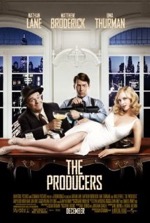
Starring: Nathan Lane
December 2005
“Brooks’ Brilliant Broadway Musical Has Filmic Second Coming”
In any work of art there are always intangibles; sometimes planted purposely, other times reaped inadvertently, these random variables can either garnish or tarnish a piece…and the stakes don’t get any higher than in the motion picture biz. This, the second movie adaptation of Mel Brooks’ wildly successful theater presentation, The Producers, has such a serendipitous quality, an ace-in-the-hole procured by Brooks and the casting department. Here, the magical element is called chemistry, and Nathan Lane and Matthew Broderick have it in spades; their mastery of the lead roles is astounding.
The story takes place in New York City in 1959, and opens with has-been Broadway director Max Bialystock (Lane) interviewing uptight number cruncher, Leo Bloom (Broderick) to be his accountant. The men immediately hit it off and soon hatch a seemingly foolproof plan to make a fortune—they’ll produce the worst show in town. In theory, Leo explains, producers could make more money with a flop than a hit; all you’d have to do is find the worst script, hire the worst actors, raise two million dollars, close the show after it tanks and head to Rio with the extra dough. Max, desperate to make a buck by any means, falls in love with the idea; and thus begins the outrageous, but utterly hilarious, story of The Producers.
There are plenty of catchy numbers in the movie, such as “We Can Do It,” “Unhappy,” and “I Wanna Be a Producer” (all of them excellently choreographed), but, arguably, the funniest song is Franz Liebkind’s (Will Ferrell) “Der Guten Tag Hop Clop,” which is essentially a Neo-Nazi hoedown. Liebkind, author of the musical “Springtime for Hitler,” will only allow Max and Leo to use his play if they take the Siegfried Oath, which declares undying allegiance to the Fuhrer. The oath also requires Max and Leo to give the Nazi salute, which they quickly convert to the bird every time Liebkind’s head is turned.
Their search for a lead actor takes a shocking twist when the producers meet Roger DeBris (Gary Beach), a gay thespian—the song, “Keep it Gay,” is an eye-opener for Max and Leo, and will be for a good portion of the movie’s audience, no doubt. In Roger, the producers have found their man—if ever there was a show killing protagonist, a gay Hitler would certainly be it. And yet the outrageous caricature of the Nazi leader, dancing onstage and singing the title song, strikes the audience’s funny bone, and before they know it, Max and Leo have a runaway hit on their hands.
There can be no question that Lane and Broderick steal the show, but the movie’s supporting players are equally good: the previously mentioned Ferrell (whose distinct brand of buffoonery actually works here) and Beach, along with Roger’s flaming partner, Carmen (Roger Bart), Leo’s demanding boss, Mr. Marks (Jon Lovitz) and the head-spinning blonde bombshell, Ulla (Uma Thurman) are all superb. As would be expected, Ulla, Max and Leo’s assistant, is the object of one innuendo after the next, but they’re all lost upon the Swedish assistant, who unwittingly stumbles into a love triangle with her bosses.
The Producers is an outrageously irreverent romp that’s sure to offend its audience while simultaneously making them roll in the aisles. It’s simply the best movie ever made that’s based on a play that features the worst play ever made.
Rating: 3
Memoirs of a Geisha (PG-13)

Starring: Ziyi Zhang
December 2005
“Finely Mounted Retrospective of Oriental High Art”
Essentially an Asian Cinderella, Memoirs of a Geisha, based on Arthur Golden’s bestselling novel of the same name, is a visual masterpiece; effectively combining authentic sets, vibrantly colored costumes and sweeping cinematography that literally can take one’s breath away, the movie transports spectators into the brutal, yet exhilarating world of a young girl living in a Japanese fishing village on the eve of WWII.
The movie opens with blue-eyed waif, Sayuri (Ziyi Zhang), being sold into slavery and separated from her sister, Pumkin. Just like the downtrodden step-daughter in Cinderella, Sayuri is blamed and punished for every familial mishap and has no purpose in life or hope for the future until she’s sold to Mameha (Michelle Yeoh), a stern matriarch who sees the young girl’s potential and trains her to be a geisha.
Though the movie’s earlier stages are plodding, the training sequences are extremely engaging and serve as a window into mid-twentieth century Japanese mores and customs. In a scene reminiscent of the horserace in My Fair Lady, Sayuri must prove herself as a full-fledged geisha by catching the eye of a prominent chairman (Ken Watanabe) at a sumo match; selling herself to the highest bidder is how a geisha earns her stripes.
The movie takes an abrupt left turn with the onset of WWII; the effects and ramifications of the war, as seen through the eyes of Sayuri and the other geisha girls, affords the audience a unique perspective on the war and the turbulent rebuilding process. This dark time—when geishas, accustomed to the perks of high society, find themselves working in the rice fields in order to survive—is one of the more interesting chapters in the film.
The word geisha means artist, and geisha girls are judged as moving works of art; in addition to extensive training in dance and creative movement, an experienced geisha will also have the ability to stop a man dead in his tracks with just one look. It’s fitting that a story so focused on art should excel at acting, directing, set decoration, costuming, makeup and cinematography. Also, John Williams’ oriental-flavored score perfectly accents the gorgeous, finely crafted film, and is worthy of Oscar consideration.
Though the movie suffers from slow-pacing and is, perhaps, a bit too long, it approaches high art with all the grace and elegance of a highly-skilled geisha thanks to an excellent script by Robin Swicord and superlative direction by Rob Marshall (Chicago). Memoirs of a Geisha is a touching story of integrity amid fierce rivalry and is a visual spectacle unlikely to be surpassed in the near future.
Rating: 3
The Family Stone (PG-13)

Starring: Dermot Mulroney
December 2005
“Diamonds Are Forever…Dysfunctional Dramedies Aren’t”
If Meet the Parents was recast and rewritten as a drama, the result would be The Family Stone, director Thomas Bezucha’s bittersweet Yuletide portrait of the pun intended Stone family. Though the gags here aren’t nearly as plentiful or outlandish as those seen in Meet the Parents, there are some humorous lines and situations sprinkled in among the hard-hitting, issue-driven narrative.
The entire plot hinges on the relationship between Meredith Morton (Sarah Jessica Parker) and Everett Stone (Dermot Mulroney). Meredith is on the stiff and stuffy side, whereas Everett and his entire family, consisting of dad, Kelly (Craig T. Nelson), mom, Sybil (Diane Keaton), sister, Amy (Rachel McAdams) and brother, Ben (Luke Wilson) are on the spontaneous, accepting and fun-loving side of the spectrum. So when the Stone’s find it difficult to accept Meredith, there’s big trouble for Meredith and Everett’s relationship, a problem that continues to intensify with each additional faux pa (like when Meredith shows her true, perfectionist colors during a game of charades), misunderstanding or ideological difference.
The crux of the movie, as one would gather from the title, is the Stone family wedding ring which has been passed down as an heirloom for generations. Cybil is reticent to hand over the ring because she isn’t convinced that Meredith is “the one” for her son. Everett comes to the same conclusion when Meredith insists on sleeping in a separate room from him and when he later develops feelings for Meredith’s sister, Julie (Claire Danes). Cupid throws another relational curveball when Ben gets Meredith drunk at a bar and the couple is discovered in bed together the next morning.
Further spiking the eggnog is an incendiary subplot involving the Stone’s adopted son, Thad (Tyrone Giordano), who, in addition to being deaf, is also gay. At the dinner table, Meredith recklessly walks into a lion’s den when she asks Cybil if she ever wished her son wasn’t gay…to spare him any psychological discomfort or social stigma. Meredith, oblivious to the growing hostility around her, persists in pushing her values on the Stones until red-faced Kelly explodes in anger and storms away from the table. The scene seems utterly unnecessary and is too politically-charged for i7ts own good; but I suppose the writers felt it necessary to add this incident to the ever-growing list of grievances the Stone’s hold against Meredith.
Therein lies the movie’s greatest miscalculation; as a main character, the audience is inclined to like Meredith, but the script requires her to be at constant odds with the Stones. Since the film has no antagonist (its most glaring deficiency) Meredith, with her air of superiority and annoying throat-clearing tick, is made villain by default.
I have no qualms with the acting, directing or other production values in the movie, but the story’s pacing is nearly catatonic at times, even when compared to other dramedies of this kind. To its detriment, The Family Stone focuses too much of its attention on issues and not nearly enough of its time on the peripheral characters. Whether The Family Stone becomes the next Christmas classic remains to be seen, but its status as a run-of-the-mill drama is secure.
Rating: 2 1/2
King Kong (PG-13)
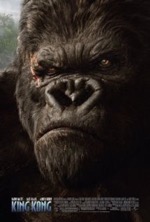
Starring: Naomi Watts
December 2005
“Lots of Art, Not Much Heart”
Peter Jackson’s King Kong in a word? BIG! There’s nothing small about the movie…the scope, scale and vision are unparalleled, save for Jackson’s The Lord of the Rings trilogy. The movie is a dazzling spectacle, a modern masterpiece and a throwback to Hollywood’s Golden Age all wrapped up in one hairy, king-sized package.
I suppose the prevailing question surrounding the high-profile, highly-anticipated film is, “Why another remake of the B tier creature-feature, first released some seventy-two years ago?” The quick answer is that Jackson fell in love with the original as a wee lad; it was his profound admiration for the clunky stop-motion classic that inspired him to become a motion picture director. The real answer is…who’s going to deny Jackson anything? After sweeping all eleven statuettes at the 2004 Academy Awards ceremony for the final LOTR installment, The Return of the King, Jackson could film a blue screen for three hours and we’d still watch it.
While surveying the well-established, highly-eclectic cast, the biggest surprise (and bone of contention among pre-premier fans) was the decision to tap slapstick comedy actor, Jack Black (School of Rock), for the title role. After viewing the film, however, most people probably will agree that Black does a superb job of fleshing out the young, brazen film director, Carl Denham. The ambitious auteur, as drawn by Jackson and Black, is frighteningly similar to a young Orson Welles; and you can be sure that such similarities aren’t lost upon either director or actor. Denham’s narcissism drives him to lie, cheat and cajole in order to get his picture made. The character possesses an eerie brand of fearlessness…even with dinosaurs charging toward him, Denham keeps the camera rolling, and it’s ultimately Denham who throws the bottle of chloroform that KO’s the angry gorilla. Denham is devastated when his camera is destroyed, but shows no remorse, whatsoever, for his fallen comrades. So severe is his megalomania and so entrenched is his need to be loved by the masses (Citizen Kane), that Denham revels in the opportunity to showcase the gigantic gorilla in an exhibition when they arrive back in NYC; taking credit for capturing the ferocious beast whenever he can, of course. Denham’s unbridled ambition and lust to provide his audience with a spectacle is a fascinating character study; in this memorable turn, Black is flawless.
Adrien Brody is adequate as renowned playwright, Jack Driscoll, but it’s Naomi Watts, in the pivotal role as struggling actress, Ann Darrow, who really steals the show. Though she never threatens to dethrone Fay Wray, Watts does an excellent job of emoting only when necessary. There’s a wonderful scene where Ann performs dance movements for Kong to entertain him (and keep him from eating her)—Kong soon grows bored and knocks her down to amuse himself. After repeatedly being shoved to the ground, a furious Ann strikes back at Kong, pricking his finger with a branch. Kong goes berserk and nearly destroys everything around him until a boulder falls on his head and dazes him. In that moment, the beast realizes the beauty isn’t afraid of him…an emotional bond forms between them. This touching moment, like the sad goodbye before Kong tragically plummets to his death, allows a ray of humanity to break through the cloud of CGI. Sadly, these intimate segues are few and far between in the film.
Andy Serkis (who makes a cameo as the ship’s cigar-chomping cook) is masterful as Kong. He brings the full gamut of motions, emotions and facial expressions to the colossal gorilla—in the same way he did for LOTR’s Gollum—by donning the blue sensor suit that’s become a second skin to the actor. Serkis will go down in motion picture history as the CG man…a truly unique and unsung talent.
The excellent performances bring the movie to life and the script (slightly tweaked from the original) is engaging, but it’s clearly the special effects that drive the film. Jackson earned the title “FX Wizard” while working on the LOTR movies, but in the words of Emeril Lagasse, he’s “kicked it up a notch” for King Kong, unleashing the creative masterminds from his Weta Workshop upon his dream project (many of the skilled artisans have worked with Jackson for the past decade now).
The iconic battle between Kong and the fighter planes atop the Empire State Building has received a facelift here, but seems like a no-brainer to storyboard. More impressive are the scenes involving the natives kidnapping Ann, the dinosaur stampede, Kong overturning the giant tree bridge and the scene where colossal slugs and bugs attack the explorers (easily the most disgusting tableau I’ve seen in a non-horror movie for quite some time—a full four minutes of creepy-crawly nastiness). One of the most deftly executed action sequences ever to grace the silver screen occurs near the movie’s midpoint…Ann desperately tries to escape the reckless pursuit of three Vastatosaurus Rex’ (think T-Rex with acne and bad dental work), faux dinosaurs dubbed by the clever minds at Weta. The sequence where Kong takes on all three Rex’ while tossing Ann from hand to foot, etc., is pure kinetic euphoria, and the scene where they all fall though the vines (Ann comes within inches of a Rex’ snapping jaws) is the creative high point of the film. There’s a great moment at the conclusion of the fight when Kong separates the Rex’ jaw from its head and beats his chest in defiance. Take that, you overgrown iguana!
For all of its technical achievement, however, King Kong misses the point by missing the human element of the story. Character development is inexcusably cursory in the film (which weighs in at 3 hours and 7 minutes) and everyone except for Denham and Darrow is overpowered by the movie’s unrelenting, mind-blowing effects. Though the story is a bit plodding before the Venture reaches Skull Island, the action achieves break-neck pace on the island, leaving little room for meaningful conversation unless you consider screams of terror to be finely-crafted dialogue.
Maybe we’ve come to expect too much from the story in the first place. The notion that a gigantic simian can fall in love with a woman (and a knock-out at that) will always remain a silly one, but King Kong, somehow, makes that improbability feasible and accessible with convincing performances and skilled direction. Jackson’s King Kong is finely-mounted, keenly-focused and larger than life in most respects. Whether or not it captures the heart and soul of the original is up to personal opinion. One thing is for certain, however, Jackson’s take on the classic story doesn’t monkey around.
Rating: 3
The Chronicles of Narnia: The Lion, the Witch and the Wardrobe (PG)

Starring: Tilda Swinton
December 2005
“Enchanting and Spellbinding with Nary a Muggle or Hobbit”
C.S. Lewis’ The Chronicles of Narnia series (seven books) is as well-know and well-loved as J.R.R. Tolkien’s The Lord of the Rings trilogy (Lewis and Tolkien were contemporaries: both belonged to a writing think-tank in England called the Inklings), but Lewis’ books are much more kid-friendly than Tolkien’s darker, edgier and more violent epic masterpiece. The most popular Narnia novel, The Lion, the Witch and the Wardrobe, was the first book I read multiple times as a child. Beyond the magical features and mythical creatures, I was captivated by the story’s universal themes, colorful characters, heart-stopping action and streamlined pacing—Lewis gradually introduces the reader to the alternate world of Narnia by ushering one, two and finally, all four of the Pevensie children into his enchanted realm. Every element in the story, which is essentially a classic fairy tale in fantasy trappings, is designed to transport the reader into Lewis’ fully-realized world, which is exceedingly easy to get lost in…especially for a ten year old boy.
Writing a review for the movie adaptation of the cherished book is like summing up all of one’s favorite childhood Christmas moments in a thousand words or less…the abbreviated piece of prose would never do the memories justice. And just as my perceptions of Christmas have changed as I’ve grown older, so have my recollections of the book—some elements I thought were in the book were only products of my youthful imagination. This phenomenon isn’t lost upon director, Andrew Adamson, who commissioned the screenwriters to forge a script based not on Lewis’ masterwork, but on his own childhood memories of the book. The resultant script presents several creative deviations but remains faithful to the source material—Lewis’ novel is a wildly imaginative and magical work of art and, thankfully, so is Adamson’s movie.
The timeless tale begins in blitzkrieg-devastated London during WWII, where the four Pevensie children—Lucy (Georgie Henley), Edmund (Skandar Keynes), Susan (Anna Popplewell) and Peter (William Moseley)—are sent by train to a provincial estate owned by the mysterious professor (Jim Broadbent in a predestined role). The children set out to explore the sprawling mansion, and on one rainy afternoon, decide to play hide-and-seek. In a last-ditch effort to avoid being discovered by Peter, Lucy enters a spare room containing only one piece of furniture…an ornate, freestanding wardrobe. Seeking refuge inside the wardrobe, Lucy walks deeper in—toward the back of the wardrobe—where she soon discovers that the arms of fur coats have transformed into the branches of fir trees. Lucy turns in wide-eyed amazement to see a snow-covered forest and a pristine path leading to a lonely lamppost.
Such begins the amazing journey into the spellbound land of Narnia, where the children encounter a faun, a beaver family, a pack of vicious wolves, centaurs, a magnificent lion, and a blood-chilling witch. At its reality-meets-fantasy core, The Lion, the Witch and the Wardrobe is a classic confrontation between good and evil, where good is represented by Aslan the lion (voiced by Liam Neeson) and evil is personified in Jadis, the White Witch (Tilda Swinton at her malevolent best), with Edmund the traitor trapped between these terrifyingly preponderant forces.
As was mentioned earlier, the story closely adheres to Lewis’ original written page, but there are a few notable exceptions. The war is only mentioned on page one of the book, but Adamson has created a slick opening sequence with German bombers making Swiss cheese out of London streets and forcing many families, like the Pevensie’s, into bomb shelters. In the book, the beavers are much more austere than their movie counterparts, who, with all of their bickering, have become the animal kingdom’s version of Edith and Archie and the movie’s only comic relief. Susan and Lucy’s involvement in the battle (Lewis’ version held that “…battles are ugly when women fight.”) is an effort to curtail sexist or derogatory language while keeping in step with the times. Two insightful omissions from the movie are talking giant Rumblebuffin and Aslan’s flying leap into the witch’s castle…they worked well in the book but would have tanked in the movie.
Every creative and visual aspect of the movie is first-rate: from the costumes, sets and make-up to the breathtaking cinematography (all locations were filmed in New Zealand) and the jaw-dropping, eye-popping special effects (Aslan is a CG marvel), the movie should be well-stocked with technical nominations come Oscar season. Harry Gregson-Williams’ sweeping, transporting and magical score—blending orchestral movements with Celtic-flavored cues (much like Howard Shore’s L.O.T.R. scores)—is one of the finest I’ve heard this year and is certainly worthy of Oscar consideration.
The creative and financial wizards behind Narnia took several considerable risks in making a movie that, for decades, had been tossed from studio to studio like a hot potato, the first of which was using small-time studio, Walden Media (Holes), to produce the film. The second was securing New Zealand native, Andrew Adamson (who co-directed both Shrek installments), to helm the film…his first attempt at live-action. The third and potentially most dangerous risk was tapping four unknown British kids to play the Pevensie children unaltered from the book, meaning no modern wardrobe or dialogue; a move that could alienate younger viewers rather than attract them (an unnecessary fear…the children are brilliant, especially the sweetly innocent Henley).
In addition to the movie’s many risks is the well-documented “controversy” over Lewis’ story: some see it as classic fantasy, while others see it as religious allegory. Adamson has his own philosophy about the story, “I read the books before I even knew what allegory meant, and I enjoyed them purely as an adventure. That’s how the film should be able to be enjoyed, too.”
Though Lewis was openly disparaging of motion pictures, claiming that he was “rather allergic to films,” I’m sure he would be proud of Adamson’s efforts and agree that this adaptation of his beloved children’s tale is nothing to sneeze at.
Rating: 3
Aeon Flux (PG-13)
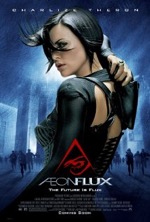
Starring: Charlize Theron
December 2005
“Won’t Even Be Entertaining in An Aeon”
Based on the MTV animated short films of the same name, Aeon Flux takes place in the distant future (the 25th century to be precise), where a domed city protects the remnant of humanity from a rapidly-evolving jungle which is reclaiming the earth. This surviving colony of humans erected the city-state to stave off the encroaching threat and provide an egalitarian existence for its denizens—the survivors of a bio-engineered virus that ravaged earth’s entire population in 2011.
Enter Aeon Flux (Charlize Theron), model citizen of Bregna by day, butt-kicking Monican (rebel) by night. Aeon’s sister, Una Flux (who came up with these names?) is executed for her suspected ties to the Monicans and Aeon accepts a mission to murder council leader, Trevor Goodchild (Marton Csokas), and thereby exact revenge for her sister’s death.
After a series of martial arts fights, Aeon finally confronts Trevor: Trevor proves his veracity to Aeon and they immediately jump into bed together. Viewing the tryst on a spy camera, Trevor’s brother, Oren (Jonny Lee Miller), stages a coup and instructs all security forces to shoot Trevor on sight. When Aeon reveals her recent, recurring nightmares, Trevor explains that the two of them were married in another life and were cloned, along with the rest of humanity, centuries ago (infertility was an unfortunate side-effect of the virus’ cure). Trevor had sanctioned cloning as a means of self-preservation, but now, new cloning methods threaten to pollute the remainder of the human race. Partnered by fate, Aeon and Trevor must retrieve his research and destroy the movie’s version of Sky Lab, called Relis Station (it’s what you get when you crossbreed a blimp and a giant jellyfish), before humanity is plunged into extinction.
As you’ve guessed by now, Aeon Flux isn’t Oscar fodder; in fact its dark, dreary and dreadful attempt at re-envisioning Aldous Huxley’s, Brave New World isn’t stylish on either end the camera unless you consider director Karyn Kusama’s penchant for fast-cuts and blurry action sequences to be the paragon of movie magic. The plot is abysmal and the dialogue is remedial—and with its high body count and gratuitous violence, there’s nothing remotely redeeming about this apocalyptic tale. The movie’s performances are as anemic as the plot: that Oscar-winning Theron would stoop to this level is utterly stupefying. Did her desire to be the next big-screen action queen prevail over her common sense? Did she sign the contract script unseen? It’s the only possible explanation. Csokas performance, as the “supposed” bad guy, is flat and passionless; he delivers his lines with as much conviction as a wet rag—which might explain why he had so few lines in The Lord of the Rings.
The special effects are solid enough in the film, but somehow the ball-bearing explosives and razor-sharp grass scenes really don’t seem all that original anymore. Where’s the innovation? It’s almost a perquisite now that action/adventure and sci-fi films must have ground-breaking effects, or compensate with a great script, A-list actors or an esteemed director. Aeon Flux has none of the above, much to its demise, and therefore, will be quickly forgotten.
God forbid there should be a sequel, but if there is, I issue this ultimatum: Either it employs a much better script or we’ll nickname it Aeon Sucks.
Rating: 1 1/2
Yours, Mine and Ours (PG-13)
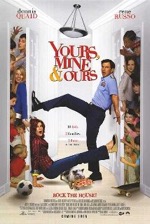
Starring: Dennis Quaid
November 2005
“Underachieving Retread of ‘Opposites Attract’ Classic”
As a rule, remakes never live up to the original: that axiom certainly holds true with the new Yours, Mine & Ours. The original movie, based on the real-life experiences of Helen Eileen Beardsley, was released in 1968 and starred Lucille Ball and Henry Fonda. Touted as one of the best family films of the 60s, the original far surpasses this flaccid update—we can thank a snake-bitten Hollywood (still reeling from the ’05 box-office bust) for playing it safe and green-lighting such a mediocre affair.
The percussive opening is one of the only highlights in the movie, but, unfortunately, the rest of the score is standard fare. As the story unfolds, we are introduced to starched and pressed Admiral Frank Beardsley (Dennis Quaid) and his eight kids and free-spirit purse designer, Helen North (Rene Russo) and her ten kids (six were adopted, but who’s counting?). Frank and Helen run into each other at a restaurant and the old flame is rekindled (they were high school sweethearts). While catching up on old times, Frank and Helen learn that they’ve both been widowed, and anyone who hasn’t fallen asleep at this point can figure out where the plot is headed. Frank and Helen are married a short time later and then the real fun begins…integrating the two households. Frank’s rank and file kids immediately clash with Helen’s spontaneous children, who are used to free expression. The blended family moves into an old lighthouse and must work together to refurbish it, while adhering to a rigid bathroom schedule and the admiral’s “house rules.” The Beardsley’s and the North’s bicker, fight and prank each other until they wise up and unite against a greater enemy—their parents.
What could have been witty and charming is witless and alarming in the hands of director Raja Gosnell (Mrs. Doubtfire). A tried and true story was in place and two A-list leads were on tap, but Gosnell clumsily mismanaged everything at his disposal…the end result is a movie that desperately tries, yet utterly fails, to entertain.
Quaid has become the consummate bipolar thespian…we’ve seen him in far meatier roles (Far From Heaven), but here he’s simply hitting his marks and collecting a paycheck—his entire performance is delivered on cruise control. Besides sibling rivalry, the one thing that does work in the movie is the chemistry between the leads—Quaid and Russo have some great scenes together where they grapple with their extreme personalities: Helen calls Frank a military robot, and Frank refers to Helen as a “free to be you and me flake.” What Helen calls decorations, Frank calls vandalism. Helen tells Frank, “A house if for free expression not for good impressions,” a philosophy that flies in the face of everything he believes in. These scenes had the potential for some meaningful character interplay, but the script dumbs down the drama and settles for the quick laugh/fix instead of anything that remotely resembles genuine human emotion.
What ails the film is familiarity...we’ve seen all of this before in such TV series as The Brady Bunch and Eight is Enough. There’s very little originality here and the tenuous plot is predictable at every turn. Yours, Mine & Ours, familial anarchy presented in a series of pedestrian gags, is far from shipshape and is one movie you must not watch. That’s an order!
Rating: 2
Rent (PG-13)

Starring: Taye Diggs
November 2005
“525,600 Reasons to Love This Multifaceted Musical”
Based on Puccini’s opera “La Boheme” and Jonathan Larson’s Pulitzer and Tony award-winning musical, Rent, which follows the lives of a group of friends in N.Y.C. over the course of one year, has finally made its way to the big screen. Many members of the original Broadway cast appear here, including show-stoppers Anthony Rapp (A Beautiful Mind) and Idina Menzel (“Wicked”).
The movie is a rock opera that focuses on the various aspects of struggle—the struggle to find love and acceptance, the struggle to overcome prejudice and loss and the struggle to make rent while trying to stay warm in a drafty East Villiage flat during the frigid winter months. Interspersed among the exceptional musical numbers are dramatic vignettes involving some very human, and therefore, very messed up characters. Take roommates Mark (Rapp) and Roger (Adam Pascal), for example. Mark is an aspiring movie director, whose ex-girlfriend, Maureen (Menzel), left him for another woman. Roger is numb from a recent loss and has a hard time opening up and letting anyone into his wounded heart. African American computer whiz, Tom Collins (Jesse L. Martin), faces the bitter reality that his cross-dressing lover, Angel (Wilson Jermaine Heredia), will soon die of A.I.D.S.
Though some of the subject matter is unabashedly adult in tone and content, Rent is an excellent window into the turbulent realities of inner-city life. Director, Chris Columbus, who’s known more for his family-friendly fare (Home Alone, Mrs. Doubtfire), stays true to the overall feel of the play, while skillfully translating it to the silver screen. Borrowing talent from the Broadway musical was a stroke of genius by the casting department—chemistry is hard to manufacture and the Rent ensemble is simply astounding. Besides the exceptional vocal performances, the movie also boasts brilliantly choreographed sequences, which really amp up the movie’s frequently somber storyline.
When all is said and done, the opening number “Seasons of Love,” by itself, is worth the price of admission. So, if you didn’t get a chance to see the movie in the theater, you owe it to yourself to go out and Rent it.
Rating: 3
Pride & Prejudice (PG)

Starring: Keira Knightley
November 2005
“Carried By Source Material if Not by Leads”
When I saw the trailer to this newest big screen foray based on Jane Austen’s timeless novel Pride and Prejudice, my reaction was, “Why do we need another one of those?” Having seen the 1940 B&W masterpiece with Sir Laurence Olivier and the 1995 sprawling, yet engrossing, five hour mini-series starring Colin Firth, I saw little reason, much less room, for yet another film on the subject. For the most part, my initial reaction was allayed by a movie that entertains while upholding the artistic integrity intrinsic in the source material.
There’s no doubt that the acting and creative elements in the movie are superb (a finely-crafted update of Austen’s classic romance, to be sure), but the apparent chink in the proverbial armor here is the story’s abridged content and rapid pacing—anyone familiar with the novel or previous movies will feel like this version is permanently stuck on fast forward. But, perhaps leaner is better…the main thrust of the story remains intact without the usual afternoon teas that drag on ten minutes or the extensive character development of peripheral players. What, at first, appears to be a drawback might actually be the finest attribute of the film—a streamlined plot.
Keira Knightley is certainly the most comely Elizabeth Bennett ever to grace the silver screen and her acting, arguably, is tantamount in distinction. On the flip side, Matthew Macfadyen is the most lacking Mr. Darcy yet…but in all fairness, he had some colossal shoes to fill. Macfadyen’s Darcy is more dour, distant and miserable than the previous interpretations of the character and if his performance succeeds at any point it’s the movie’s excellent (adapted) dialogue that allows him to accomplish this more than any other single factor. The character’s thinly-veiled sarcasm isn’t rocket science—when Elizabeth asks Darcy if he dances, any decent actor could have pulled off the sardonic retort, “Not if I can help it.” Donald Sutherland’s Mr. Bennett is more aloof and less quarrelsome with his wife here and, unfortunately, is a virtual non-factor in the movie.
As mentioned before, the movie’s costumes and sets are Oscar-caliber and the choreography for the dance sequences is absolutely brilliant. Like two ships of the same era firing cannonballs at each other, Elizabeth and Darcy speak in short phrases—incisive jabs shrouded in civility—as they pass each other in the dance line…one of the movie’s most amusing sequences.
This Pride and Prejudice may not measure up to previous efforts with the same title, but it’s still a literate and artistic film that appropriately updates Austen’s supreme romance and certainly will stand the test of time…at least until the next movie arrives.
Rating: 3
Walk the Line (PG-13)
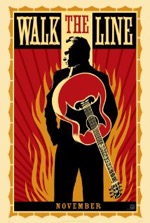
Starring: Joaquin Phoenix
November 2005
“Honest, Accurate Portrait of the Man in Black”
Following up last year’s smash-hit biopic, Ray, would be a daunting task for any movie, but Walk the Line, the tumultuous story of Johnny Cash’s passions and pitfalls, holds its own with remarkable performances and a screenplay that exudes authenticity thanks to its source material—Cash’s autobiography—and input from son and co-producer, John Carter Cash. Ray is referenced here because there are striking similarities between both movies, similarities that beg a closer examination.
Both Ray Charles and Johnny Cash were artists who not only rose to the highest pinnacle of the music industry, but also redefined their respective genres with charisma, innovation and sheer honesty born of tragedy. Both men battled infidelity on the road and both struggled with their addiction to drugs. Most strikingly, however, is that both men shared the same traumatic childhood event—through inaction, both Charles and Cash lost their brother to a senseless accident. It could be argued that the guilt and self-recrimination they experienced drove both men to drugs as a way of sublimating their emotional pain.
The events of Johnny Cash’s life certainly are powerful and dramatic, but the script is constrained by the need for veracity: what the story gains in authenticity, it looses in spontaneity, especially for those already familiar with the ups and downs of Cash’s career. In that regard, the movie would be easy to forget if not for the stellar performances delivered by the cast in general and the leads in specific. Reece Witherspoon is amazing as June Carter and Joaquin Phoenix is astounding as Cash—both portrayals are made all the more extraordinary by the fact that both actors did their own singing for the movie (like in Ray, musical interludes form the timeline and structure of the story and are enjoyable and memorable excursions from the film’s dramatic episodes). Witherspoon’s experience with playing upbeat debutantes really serves her well here, and Phoenix’s dramatic training on Gladiator and the Shyamalan films has clearly paid dividends in what is arguably the stand-out performance of the year.
Though his acting is fine, I just can’t bring myself to accept Robert Patrick as Johnny’s father, Ray Cash. About a year ago, I saw Patrick and Phoenix together in Ladder 49, and though Patrick is clearly the older of the two, he seems more like an older brother or uncle to Phoenix than a father figure. Further, I don’t feel the make-up department did a very good job of aging Patrick, especially in the final scene.
Stand-out scenes are plentiful in the movie and are certainly not limited to these: Cash auditioning with a local record producer who challenges Johnny to write songs that can change people’s lives, Cash’s ongoing struggle with substances climaxing with his meltdown and collapse on stage, Carter being verbally pummeled in a general store by a local woman who disapproves of her recent divorce, Cash’s manic attempt to free a brand new tractor from a mud pit only to land it and him in a nearby lake, Cash’s legendary concert at Folsom Prison where he makes a crack about the yellow water, and any scene that has the phrase “Where were you?” in it.
Director James Mangold (Identity) does an adequate, if not excellent, job with the paint-by-numbers script—Cash walking down the same dusty road as a boy and later as a man is a nice touch—but one wonders what the movie could have been with a more established/renowned auteur at the helm. The film runs a bit too long—the coda is unnecessary other than to show a mending relationship between Cash and his father. Mangold would have done better to freeze-frame the embrace between Cash and Carter—after Cash finally wears Carter down and she agrees to marry him in front of a live audience—and include a line about Cash’s reconciliation with his father in the concluding footnotes.
Walk the Line should receive numerous Oscar nods: besides excellent performances, the movie is inspirational in its offering of hope to anyone who, like Cash, has made some poor choices in life (who among us is immune to this condition?). Johnny Cash may have hurt himself and others in his lifetime, but he also found redemption in his later years and will be remembered for his humanness and musical brilliance for decades, and hopefully centuries, to come. Who said good guys never wear black?
Rating: 3
Harry Potter and the Goblet of Fire (PG-13)
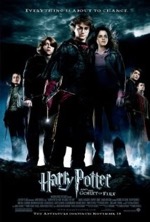
Starring: Daniel Radcliffe
November 2005
“Darker, Edgier and Hotter than the Other Potter’s”
The fourth Harry Potter movie has been adapted from the fourth novel in J.K. Rowling’s blockbuster book series and, fittingly, shares the same name as its literary progenitor. It’s clear from the outset—when evil spirits swoop in to disrupt the finals of the Quidditch World Cup—that Goblet will be a darker film than the oft-frivolous and pedestrian adventures embarked upon in the earlier trilogy. It’s time for Harry to put on his big boy pants.
Spoiler alert: A highlight of the film for many viewers (or perhaps just for this fantasy prone reviewer) is sure to be the Tri-Wizard Tournament with its various events specifically designed to test the contestant’s fortitude of body, character, mind and will. Harry’s run-in with the dragon is a mesmerizing series of narrow escapes and hair-raising, hair singing scrapes. The CG detailing on the fire-breathing behemoth is absolutely astounding, so kudos to the movie’s FX wizards (the muggle variety). The underwater test of ingenuity and integrity features a highly imaginative setting and boasts an incredibly intense action sequence…you can almost visualize the storyboards in your mind as the scenes play out one pulse-pounding shot after the next. Harry’s clever breathing apparatus and daring rescue mission are highlights of the hair-raising spectacle and serve to further affirm Harry’s heroic status. The final challenge—the race through a hedge maze (on loan from Labyrinth) to the Goblet of Fire—tests Harry’s mettle around every turn, where various pitfalls have been carefully arranged to waylay Harry’s advance toward the coveted cup.
Before the action has completely abated, Harry is visited by a shadowy form—yep, that’s a damp chill languidly writhing its way up your spine. Even though I haven’t read the novels, I’d be willing to bet that Harry’s encounter with the evil presence at movie’s end will figure prominently into future events. I know, the most conservative bet in history, but there can be no doubt that from here on out Harry will need to watch his back and rely more heavily on his circle of loyal friends.
Though carrying itself more seriously than the previous films, Goblet is still an intensely fun romp through Rowling’s magical world. Director Mike Newell manages the actors and action well, but if ever there was an argument against the auteur theory, the Potter series would provide a strong case. After all, does it really matter who the director is on these Potter films? It seems like the machine is so well-oiled at this point (owing largely to the strength of the source material, the spot-on performances and exceedingly high production values) that no matter who’s at the helm the results will be…magical. One thing’s for sure; Goblet is the creative zenith for the movie series thus far.
Since the Rowling’s plots seem to be getting bleaker by the book, it’s safe to assume that the next film, The Order of the Phoenix, will also be a few shades darker than Goblet. For better or worse, that young, innocent boy who first stepped foot in Hogwarts a few years ago is growing up…along with the legions of fans who devour his books and turn out in droves to enjoy his exploits on the big screen. You might say that his fans have an inextinguishable fire.
Rating: 3 1/2
Zathura (PG)
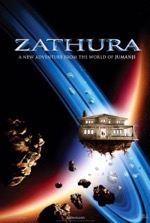
Starring: Josh Hutcherson
November 2005
“A Galaxy of Fun Awaits Those Who Can Pronounce It”
The name is Zathura…not Zanthura (as was incorrectly pronounced by blonde bombshell Jennifer M. on Apprentice 4). Based on the children’s book of the same name by author Chris Van Allsburg (Jumanji), Zathura is a lot better than it looks at first glance (the trailer doesn’t do the movie justice by a light year). Once you throw the laws of physics out the airlock—like director Jon Favreau does with great dispatch early on in the film—Zathura is a fun-filled romp through outer space and a meaningful tale of reconciliation between two quarreling brothers.
Zathura’s plot is virtually identical to Jumanji’s…kids are left home alone and they stumble upon an old board game; curiosity gets the best of them and they start playing, learning very quickly that their hasty decision might lead to their demise. Both books/movies focus on a series of turns—which become more disastrous with each successive round—where the players desperately attempt to set things back to normal while evading destructive forces or aggressive enemies that seem to materialize out of thin air. Where Jumanji featured jungle animals (including a heard of rhinos, which wreaked havoc while charging down the middle of town), Zathura offers up a universe of hazards, most notably a rogue robot that needs to be reprogrammed and the croc-like Zorgons (not to be confused with the Vorlons from Babylon 5 or the Vogons from The Hitchhiker’s Guide to the Galaxy). Each turn raises the stakes and when things look like they couldn’t possibly get any worse, the game ends and the pieces reset, but not before lives are changed and lessons are learned.
Though Tim Robbins’ presence—as a beleaguered father and sport car designer, recently separated from his wife—is barely felt in the movie, he turns in his normal, polished performance (it would have been nice to see him again at the end, however). Of Robbins’ three screen kids, teen daughter, Lisa (Kristen Stewart), is the most oblivious and superfluous character in the movie…she’s really only here for comic relief (Lisa is cryogenically frozen in her bathroom) and as an object for teenage boys to ogle at.
The two boy leads, Danny (Jonah Bobo) and Walter (Josh Hutcherson), anchor the movie, especially Danny, whose wide-eyed amazement at the wonders of the universe is the movie’s most-endearing feature. The visual of the house drifting in space is memorable, and the twist involving the astronaut is finely executed.
Zathura is much more than a glorified sci-fi role-playing game; it’s a charming and clever story that dispenses a good moral about sibling rivalry and is a fun way to get lost in space for two hours.
Rating: 2 1/2
Good Night, and Good Luck. (PG)
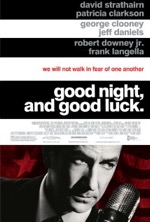
Starring: David Strathairn
November 2005
“Literate and Intensely Focused Reflection on the McCarthy Era”
This is one of those rare films (and not just because it was shot entirely in B&W) where historical accuracy and artistic license beautifully meld into an engaging narrative so taut, so terse and so poetic that it transcends the medium to become something far grander than just a movie.
Two insights struck me as I took in the experience that is Good Night and Good Luck, director, co-writer and co-star George Clooney’s incisive treatise on the U.S. during the McCarthy Era: 1. The more people change, the more they stay the same. That is to say, it’s easy to play armchair historian and pass judgment on our American forebears, circa early 1950’s, for their rampant hysteria over rumored Communist spies in high governmental positions (Jr. Senator from Wisconsin, Joseph McCarthy, and his minions believed that our country was contaminated by Communists and took it upon themselves to ferret out and/or blacklist said individuals from every strata of society). The names, faces and headlines have changed over the decades, but have we truly evolved past our petty prejudices, bigotry and racial profiling (in the wake of 9-11, for instance)?
2. What happened to our education system? The mode of speech employed by all of the characters, and CBS news reporter Edward R. Murrow (David Strathairn) in particular, is at a far superior level to anything you’d hear in the media today, much less in casual, everyday conversation. Much more than just a list of SAT words, the movie’s dialogue is permeated with abstract concepts, euphemistic jabs, figurative descriptions, satirical quips and quizzical notions. Continually catering to the lowest common denominator has clearly taken a toll on our education system and the citizens of our nation by extension.
Lending the movie a sense of time and place is the preponderance of cigarette smokers; roiling wisps of smoke can be seen throughout the movie and at times the cloud of carcinogens was so dense on-screen that I had to hold my breath for fear of inhaling second-hand smoke. Another historical tidbit presented in the movie (which may be a curiosity to younger viewers) is the much stricter policies regarding fraternization in the 50’s workplace, as is poignantly demonstrated by married couple Joe and Shirley Wershba (Robert Downey, Jr. and Patricia Clarkson).
Social commentary aside (if that’s possible with a movie of this ilk), Good Night and Good Luck is a masterwork that seamlessly blends actual footage of McCarthy with Strathairn’s ardent recitation of Murrow’s actual monologues. Recitation is a heinous disparagement of Strathairn’s scintillating performance—the actor so perfectly captures Murrow’s mien and nuances that he could teach Shirley MacLaine a thing or two about channeling. Anchored by Strathairn and Clooney (who plays intransigent producer, Fred Friendly), the cast is a virtual directory of A-list actors: Jeff Daniels as the reticent office manager, Sig Mickelson, Frank Langella as the beleaguered studio executive, William Paley, Ray Wise as the troubled newsman, Don Hollenbeck, along with the aforementioned Clarkson and Downey Jr., are all pitch perfect under Clooney’s prescient direction.
Although I don’t believe there’s such a thing as a flawless film, Good Night and Good Luck comes exceptionally close to that lofty mark. Moments of stark intensity, like the heated debate over editorializing or the moral dilemma over always posing two sides to every story, are properly balanced with guffaw-inducing sidebars like the exchange between Murrow and Liberace…the only time Murrow is left speechless in the entire movie. Another brilliant touch is Clooney’s use of mock recording sessions from neighboring Columbia Records as musical segues between dramatic sequences; adding some much needed variety, they prevent the movie from collapsing under its own weight.
Serving as bookends for the movie is Murrow’s speech at a banquet thrown in his honor in 1958: in it he warned against complacency—which was already brewing in our country—and that television, as a terribly powerful medium, must not be used for frivolous entertainments. I wonder what Murrow would think about Reality TV?
Whether or not the movie is so honored, Good Night and Good Luck is the best picture of 2005…and good luck to anyone who gets in its way.
Rating: 4
The Legend of Zorro (PG)

Starring: Antonio Banderas
October 2005
“The Legend Continues…But Will the Franchise?”
Absence makes the heart grow fonder. Wine improves with age. Seven years is a freakin’ long time to wait for a sequel. Well, maybe that last one isn’t a common expression, but it’s no less true. The Mask of Zorro (1998), a rousing, swashbuckling adventure starring Antonio Banderas, Anthony Hopkins and Catherine Zeta-Jones, was met with wide acceptance from critics and audiences alike. Now, director Martin Campbell brings us the long-awaited return of the masked vigilante (cape and sombrero, not cape and cowl). However, instead of capitalizing on the success of the first film, Campbell and writers Roberto Orci and Alex Kurtzman have served up a virtual rehash of the original, which suffers from a severe case of sequelitis and has validated another adage: fondness for what’s absent is far better than disappointment over what’s present.
It’s hard to know what direction the sequel should have gone, but this definitely isn’t it. Perhaps the powers that be should have fought harder to get Anthony Hopkins back…his involvement certainly couldn’t have hurt matters any. Or perhaps the Academy Award winning thespian took one look at the script and said, “Pass on the script and pass me the fava beans.”
If The Legend of Zorro has a fatal flaw it’s the strained and estranged relationship between Zorro (Banderas) and Elena (Zeta-Jones). The petty jealousy scenes are overly-pedestrian and are simply painful to watch. To make matters worse, the movie has an identity crisis over Zorro and Elena’s marital troubles and the mischievous misadventures of their son, Alejandro (Adrian Alonso). Alejandro’s penchant for getting into trouble provides some comic relief, but the youth’s hijinks fail to play the expected wild card role in the story’s climax. In the end, the boy is a minor character that’s a major nuisance.
One of the sequel’s subplots involves the fight for the future of California, but, if memory serves, the first film dealt with the same issue. Where’s the originality? Midway through the movie, there’s a “plot twist” involving glycerin soap that spectators will see coming from miles away.
Another gimmick that falls flat is the resolution to the protracted lover’s quarrel between Zorro and Elena. When Elena’s true motivations are revealed in the climactic action scene the intended “Ah ha!” moment is actually a groan-inducing non-twist that makes the already emaciated plot pass out from exhaustion under the hot desert sun. Other than a few amusing one-liners and a handful of action scenes (which aren’t nearly as spirited as those in the first film) the rest of the plot is largely forgettable.
I know it’s never wise to count Zorro out, but at this stage the masked vigilante’s screen future is as dubious as this film’s plot. It’s conceivable that, with a better script, Zorro could return for another adventure, just like he did after decades of dormancy with the previous film. With the franchise already in possession of a marketable brand and stellar A-list actors, the continuation and success of the series largely depends upon exciting and original stories. That said, will Zorro ride again or has this pathetic sequel put a nail in the coffin for good? It’d be a shame, and a profound irony, if this film has unintentionally inflicted itself with Zorro’s patented death mark.
Rating: 2
Dreamer: Inspired By a True Story (PG)
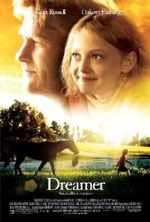
Starring: Kurt Russell
October 2005
“Emotional and Inspirational Horse Tale”
If watching a movie could be like slipping on a pair of worn-in boots, Dreamer would definitely be that movie. You already know the ending when you see the trailer (movie, not horse), but there’s still something reassuring, comforting and inspiring about a story where someone dreams big and wins, especially if it’s based on a true story. Especially if it features Hollywood’s youngest starlet, Dakota Fanning (who, according to a recent EW article, has outperformed every other adult female actor—including Julia Roberts—at the box-office this year).
Ben Crane (Kurt Russell) is a weather-worn horse trainer who struggles to connect with his distant daughter, Cale (Fanning), beleaguered wife, Lilly (Elizabeth Shue) and estranged father (Kris Kristofferson), while contending with his racist boss (David Morse), who fires Ben and gives him a Philly with a broken leg as severance pay. Ben nurses Sonador (Spanish for Dreamer) back to health—with the additional aid of Cale, who sneaks out of the house late at night and feeds the horse popsicles—and the horse is soon racing along the countryside. Ben sees the horse’s breeding potential, but Cale steadfastly holds to the silly notion that Sonador will race again and begs dad to let her keep the horse.
Cale is given ownership of the horse and after winning a few small-time races, she sets her sights on the Breeder’s Cup. Everyone thinks Cale is overly idealistic, but when Sonador clinches the final spot on the Breeder’s Cup roster, the family is faced with the next colossal challenge—coming up with the formidable entry fee. Beyond that seemingly insurmountable obstacle is the unsettling knowledge that Sonador has never been in a race this big and is predicted to finish last (lingering concerns as to stability of Sonador’s leg also throws a pal over the horse’s chances of finishing favorably). In this seething cauldron of doubt and dream-shattering circumstances, Cale’s courage primes the pump of the impossible; not just reconciliation between Ben and his family, but also a goose-bump raising finale that rivals Seabiscuit’s harrowing climactic race.
The lines on Russell’s face are showing through the make-up more these days, but like fine wine, his performances are improving with age (Miracle). There’s a bit of dream casting in the movie; Russell and Kristofferson look like real-life father and son, and the interplay between these big-screen veterans is a real treat. Superlatives always seem to fail when describing cherubic Fanning, and frantically flipping through a thesaurus to find that choice adjective seldom works either. Suffice it to say, Fanning has turned in another precocious performance here and is rapidly becoming the queen of the silver screen…at age ten.
From the opening sequence to Bethany Dillon’s uplifting, tear-jerking song accompanying the end credits, Dreamer is one hundred percent inspiration—a family-friendly, fun-filled tale that reminds us to pay heed to the dreamer inside.
Rating: 3
Elizabethtown (PG-13)

Starring: Orlando Bloom
October 2005
“Interminable Dramedy Is Nothing to Crowe About”
Every once in a while, a movie comes along that you really want to like, but you just can’t. The acting, directing, etc. is fine, but the sum of the movie’s parts leaves you dubious, disappointed or downright confused.
Speaking of confusion, the “Huh?” factor is ubiquitous in the latest five-course banquet served up by writer/director Cameron Crowe (Jerry Maguire). Dubbed Elizabethtown—a sprawling, writhing piece of dramatic/romantic yarn that tells an involved tale with little lasting value—the movie features some amusing vignettes, but ultimately neglects to provide an overarching theme.
Sneaker designer, Drew Baylor (Orlando Bloom), has created a new, cutting-edge tennis shoe that’s been rejected, en masse, by the shoe-buying public, causing the company he works for to eat a million dollars. Drew is in the process of attempting suicide when his frantic sister calls—Drew’s father has died. Volunteered by his immediate family to make the funeral arrangements, Drew catches a red eye flight to Lexington. An ebullient stewardess, Claire (Kirsten Dunst), befriends (virtually stalks) Drew, tries out some pop psychology on him and gives him a map of Kentucky and her phone number as he debarks the plane.
Drew experiences severe culture shock when he arrives in Elizabethtown: his entire extended family envelops him, each relative brimming with colorful stories about his deceased father whom he hardly knew. Drew is soon drawn into the middle of a heated debate regarding his father’s upcoming funeral: should his father be buried or cremated? Amid the craziness, Claire pops up again, but only to string Drew along some more until she finally deals with her commitment issues and allows the bud of her romantic feelings for Drew come into full bloom.
After two hours (which feels like two days), the movie, at last, brings us to the long-awaited and unconventional funeral, which features a swooping, flaming boar and a head-scratching tap dance by Drew’s mother, played by Susan Sarandon (I nearly checked out here). Most of the funeral belongs in a slap-stick comedy and feels incongruous with the rest of the movie.
When the funeral finally, mercifully concludes (my friend turned to me in the theater and whispered, “As far as I’m concerned, it’s not over.” He was right. The movie drags on for another half hour), Drew undertakes a journey of self-discovery and emotional healing—which is what the movie should have been about from the very beginning. As Drew drives across the central U.S., following clues that Claire has placed for him in advance, he works things out with his dad; talking, laughing and yelling at the ash-filled urn sitting in the passenger seat. This sojourn is the most enjoyable part of the movie, but, unfortunately, it can’t bail out the previous two hours, which are filled with exhausting character development of shallow lives and events both random (Chuck and Cindy’s wedding) and commonplace, all of which brings the viewer to a mental state similar to Drew’s before his sister calls.
Elizabethtown is an insipid comedy, a dense drama, a frequently aimless character study and a plodding quagmire of subplots all rolled into one—there’s no clear sense of place or purpose until the very end. Crowe’s direction is ponderous and the overall effect of the film is like a shot of Novocain in the brain—the numbness eventually wears off, and in a few hours, the spectator has no recollection of the movie whatsoever.
Bloom is fairly convincing and Dunst does her giggles and dimples best, but their solid performances fail to elevate the superfluous storyline and leaden dialogue, which is an amalgamation of the worst B-movie lines ever written. The most distracting element in the movie (besides Dunst’s atrocious Southern accent) is the voluminous soundtrack; a veritable Time Life collection of pop tunes that can be heard at regular intervals (generally every two to five minutes) throughout the film, the music feels less like a score and more like a juke box with a broken record.
In short, Elizabethtown is an utterly meaningless film that’s entirely too long (like this review). But, hey, it could be worse…the first cut of the film was eighteen minutes longer.
Rating: 2
Wallace and Gromit: The Cruse of the Were-Rabbit (G)

Starring: Peter Sallis
October 2005
“An Overripe, yet Nutrient-Rich, Veggie Tale”
From Nick Park and Steve Box, the visionary directors who brought us Chicken Run, comes the first feature-length film based on their signature characters—Wallace and Gromit. Based on a series of Claymation shorts of the same name, Wallace and Gromit: The Curse of the Were-Rabbit is a raucous romp that wholly entertains and presents a few unexpected turns along the way.
Inventor Wallace (who certainly must be the distant cousin of Inspector Gadget) and his mute dog, Gromit, own a critter control company called Antipesto and are esteemed as local heroes by all who have required their services. The annual vegetable growing contest brings with it a heightened need for pest protection and Antipesto is up to the challenge, or so they think. One fateful night, Wallace, who moonlights as a mad scientist, experiments on a rabbit, mutating the poor little fur ball into an abominable creature. Soon, there are too many calls for Antipesto to keep up with, and so many gardens ravaged that the contest is in danger of being cancelled. As the raids increase, Wallace begins exhibiting strange behaviors, leading Gromit to wonder if the real threat is somewhere closer to home.
If The Curse of the Were-Rabbit could be summed up in one word it would be “witty” (what else would you expect from the unrelenting barrage of British humor?). The jokes and gags are both obvious and hidden (the radio buttons in Wallace’s vehicle spell M-U-T-T), but it’s really the twist near the mid-point that gives the movie some much-needed dramatic focus, which nicely counterbalances the film’s wanton whimsy.
Peter Sallis is spot-on as Wallace, as is Ralph Fiennes as the braggadocios hunter, Vincent Quartermaine—both characters become involved in a ménage trios with affluent horticulturist, Lady Campanula (Helena Bonham Carter), which is quite an amusing sidebar, especially when Quartermaine is sucked up into Wallace’s bunny extractor.
Though a bit on the pedestrian side, the movie is nothing if not clever; the were-rabbit’s fall from lofty heights is clearly a tip of the hat to King Kong (who will be brought back to the big screen by Peter Jackson in December). The transformation scene is a bit of a reach, but it’s all in good fun (like the rest of the movie) and decisively proves that Wallace and Gromit live in some very bizarre alternate reality.
In the final analysis, The Curse of the Were-Rabbit is every bit as good as Chicken Run and perhaps a hare better…it’s a hopping good time that will delight kids and engage adults. The only downer here is that the warehouse containing much of the work for this and earlier W&G projects burnt down a short time after the movie’s release.
Rating: 2 1/2
Serenity (PG-13)

Starring: Nathan Fillion
September 2005
“There’s Nothing Serene About This Bizarre Space Western”
In 2002, Joss Whedon, of Buffy the Vampire Slayer fame, created an old west meets sci-fi TV series dubbed Firefly, which lasted less than a year (fifteen episodes, three of which never aired) on Fox. Gaining a small cult following and earning widespread praise from critics, Firefly never really found an audience and soon went the way of Birds of Prey, another truncated genre show that failed to take flight on The WB the same year. The progenitor of cancelled sci-fi shows, Star Trek, was pitched to NBC as a “Wagon Train to the stars” in the mid-Sixties. Though Star Trek and its multiple spin-offs scarcely resemble the original selling point, Firefly was the literal embodiment of that concept.
So here we have Serenity, a movie furthering the adventures of Captain Malcom Reynolds (Nathan Fillion) and his ragtag crew as they steer their equine cargo vessel (easily the ugliest spaceship I’ve ever laid eyes on) through Alliance territory with their mysterious passenger, River (Summer Glau). River has superhuman reflexes and strength (think Sydney Bristow on speed); her fight scenes are really the most enjoyable part of the film, besides Fillion’s oft-witty, off-kilter sense of humor.
As the crew ferries River to a secret destination, they have a series of misadventures while learning more about her “special” abilities—she’s a genetically engineered killing machine with telepathic abilities (wouldn’t have guessed that one). To add spice to the otherwise bland plot is the unrelenting pursuit of the cannibalistic Reavers (I knew the writers were smoking something), war-like aliens with ugly mugs and a disposition to match. The origin of the Reavers is revealed near the movie’s mid-point—they were once humanoid beings mutated by the radiation fallout of a nuclear holocaust—a sequence that harkens back to the Morlock back-story in The Time Machine (1960). However, what the scene gains in dramatic punch, it looses in originality.
As one who never saw an entire Firefly episode, I found Serenity’s learning curve a bit too steep for enjoyment, especially its customs and speech. The Southern-fried lingo is so anachronistic within the sci-fi milieu, it almost mutates the film into a comedy; not because the dialogue is particularly clever, but because the spurs and six-shooter speech is so abundant and so awkward it’s downright laughable, and that’s for sure and for certain. Also, the film’s politics are muddy and the moral relativism, “I don’t care what you believe in as long as you believe in something,” posited by the priest is as uninspired as the movie itself.
Serenity is a grim and violent piece of sci-fi that feels like a glorified TV show and will undoubtedly head straight to video as it heads off into the sunset.
Rating: 1 1/2
Flightplan (PG-13)
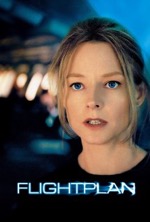
Starring: Jodie Foster
September 2005
“High-Flying Thriller Fulfills All of Its Plans”
Ever noticed how movies on a similar theme always end up being released in pairs? Hollywood catches wind of a hot-button topic or finds a bandwagon to jump on and at least two studios go head-to-head to be the first to capitalize on the subject. Invariably, one will gain supremacy (whether in quality, critical recognition or box-office success) over the other.
Clint Eastwood’s award-winning, paradigm-shifting western, Unforgiven (1992), prompted Buena Vista’s Tombstone (1993) and Warner Bros.’ Wyatt Earp (1994). Scientists predicting a catastrophic event from an asteroid collision informed Paramount’s Deep Impact (1998) and Buena Vista’s Armageddon (1998), while predictions of a manned-mission to Mars within the next thirty years gave us Buena Vista’s Mission to Mars (2000) and Warner Bros.’ Red Planet (2000).
So now Hollywood’s on an aviation kick, perhaps spurred on by last years’ The Aviator, with Dreamworks’ Red Eye and Touchstone’s Flightplan, two high altitude thrillers released a month apart. With Jodie Foster onboard, an airtight script by Peter A. Dowling and Billy Ray in the cargo hold and taut visioneering by director, Robert Schwentke, in the cockpit, this jumbo-jet really soars and is certainly the better of the two recent plane thrillers.
The movie opens with jet designer, Kyle Pratt (Foster), coaxing her six-year old daughter into boarding a new 474 double-decker jet headed from Berlin to N.Y.C. Also onboard, stored in the lower cargo section of the craft, is a casket containing Kyle’s recently-departed husband—he fell out of a window (uh, huh!).
Exhausted from recent events, Kyle dozes off… Three hours later, turbulence jolts Kyle from her respite and she discovers Julia is missing. At first, Kyle is merely worried when no one in her section remembers Julia boarding the plane—even the obnoxious kids sitting directly in front of them. After searching the entire plane, Kyle goes into panic mode and asks to see the captain. Captain Rich (Sean Bean) is at first sympathetic, ordering a full search of the plane, but when the stewardesses fail to turn up anything, the captain becomes cynical, even adversarial. Matters go from bad to worse when he learns that, according to the passenger manifest, there never was a Julia Pratt aboard. While the crew believes she’s hallucinating or suffering a mental breakdown from the loss of her husband, Kyle starts to wonder if she’s loosing her mind until she finds a piece of undeniable evidence that proves Julia is on the flight.
What begins as a run-of-the-mill “missing person” tale upgrades to a first-rate, edge-of-your-seat thriller, complete with terrorist activity, racial commentary and feral maternity. Foster is magnificent in her portrayal of a mother pushed to the edge—this is a brilliant, multi-layered character study, flawlessly conveyed and wholly believable. Like the gradual intensity of a sunrise or the steady temperature increase of a pot of water set to boil, Foster seamlessly morphs from concerned to alarmed, to panicked, to frenzied, to hysterical. These emotional gradients are masterfully executed by this veteran A-list actress, who is undoubtedly in her power-house prime.
The only noteworthy supporting players are Bean and Peter Sarsgaard, both of whom, ironically, have a fear of flying in real life. Bean’s Captain Rich stays just on the fringes of becoming a central character—his part is serviceable but certainly not noteworthy. Sarsgaard’s duplicitous air marshal is a more fleshed-out auxiliary player, but he falls just shy of being a memorable villain—Cillian Murphy’s antagonist in Red Eye was much more effective.
Besides some minor plot holes (i.e., why would hijackers kidnap the daughter of a woman who designed the plane?), Flightplan is a riveting thriller, made memorable by a solid script and Foster’s mesmerizing performance. Now, when can we book a flight on that new jet?
Rating: 3
Just Like Heaven (PG-13)

Starring: Reese Witherspoon
September 2005
“Metaphysical Love Story is Comely if Not Heavenly”
Elizabeth Masterson (Reese Witherspoon) has it all. She’s a young, beautiful, successful doctor, who is widely admired and resides in a quaint bay view apartment in San Francisco. The only thing she doesn’t have is the one thing she wants the most—a great guy she can settle down and start a life with; everything would be heavenly then. On one rainy night, Elizabeth, in a hurry to get home and change for a blind date, crashes into the side of a semi-truck.
Enter David Abbott (Mark Ruffalo), an architect who is searching for a new dive when a flyer advertising Elizabeth’s place blows right into his face. Taking that as a sign, David moves in and makes himself at home (spilling chips and soda on the sofa), much to Elizabeth’s dismay and disapproval. Inevitably, the two tenants meet and the sparks immediately start flying. After a vehement argument, David eventually proves to Elizabeth that she’s dead—he can see her, but nobody else can.
David begrudgingly assists Elizabeth in tracking down clues about her life—it’s a journey of discovery for the pair as they strike up an uneasy friendship that deepens as they continue picking up loose threads together. There are plenty of “crazy man talking to someone who’s not there” scenes (the bit where David gives a choking man first aid with instructions from Elizabeth is extremely funny), but ultimately they end up at the hospital where Elizabeth had previously worked. While David grills a nurse who worked with Elizabeth, the spectral Elizabeth passes through a wall and discovers the movie’s first major twist—she sees herself on a hospital bed lying motionless in a coma.
David later learns from his best friend that Elizabeth was the one he was supposed to meet on the blind date that fateful night—somehow, even though they never met, there’s a spiritual connection between David and Elizabeth, which you would never guess from the way they constantly toss acidic barbs at each other.
The last major twist, which gives the trolling plot a much-needed jolt of urgency, comes when Elizabeth’s sister, Abby (Dina Waters), reluctantly decides to sign the papers authorizing the hospital staff to pull the plug. Now it’s a race against time as David, translating Elizabeth’s words from beyond (a la John Edward), tries to convince Abby that Elizabeth is still alive.
Based on the book If Only It Were True by Marc Levy, Just Like Heaven has undeniable shades of Ghost and Heaven Can Wait, and though often derivative, the movie is carried by strong performances and an accessible story that packs an unexpected, emotional punch. The movie’s director, Mark Waters (Mean Girls), has crafted the quintessential dromedy, which should appeal to a wide audience with its wit, pathos and uplifting fifth act.
If you can deal with the metaphysical quagmires in the story, Just Like Heaven is a heart-warming tale that exemplifies the unquenchable human spirit and is easily one of the finest examples of its genre ever crafted. Just Like Heaven? Not quite. But for earthly entertainment it’s a sweet and charming repast.
Rating: 3
The Brothers Grimm (PG-13)

Starring: Matt Damon
August 2005
“Aptly Named Creature Feature Tells Grim Tale”
In a world where a great movie is solely determined by great special effects, The Brothers Grimm would be considered one of the finest films of the year. Unfortunately for director Terry Gilliam and scribe Ehren Kruger, we don’t live in such a world.
The Brothers Grimm is a strange conglomeration of classic fairy tales, and while this arrangement worked like a charm for Shrek, it’s a confusing and contrived wreck here—the movie isn’t entertaining nor is it funny despite it’s valiant attempts. In many ways, The Brothers Grimm is this year’s Van Helsing (as if we really needed another one of those) and comes complete with macabre trappings and the requisite werewolf.
Set in Germany against the backdrop of the French occupation of 1796, Jake (Heath Ledger) and Will (Matt Damon) Grimm are renowned witch hunters and demon slayers who are coerced—by their French captors—into entering a haunted forest and tracking down the person or creature who has kidnapped a number young girls (Gretel and Red Riding Hood among them). Their quest leads them to a gigantic tree located in the heart of the forest, which houses a glass fortress at the top. A cursed man who can transform into a werewolf has placed the kidnapped girls inside caskets encircling the base of the tree. The skeletal remains of Queen Mirror (Monica Bellucci) will be reanimated and the wolf-man’s curse will be broken if he can find one final girl. The Grimm brothers thwart the queen’s plans, of course, but not before a rousing and frenetic climax.
I have to admit that The Brothers Grimm didn’t hold my interest much past the opening credits. The plot is frequently aimless and ultimately pointless, the dialogue is as stale as one of Gretle’s breadcrumbs and I didn’t give a flip about any of the characters. Ledger and Damon have turned in mediocre performances that perfectly match the uninspired production.
There’s been a recent regression in motion picture special effects—not in quality but in believability—and the movie’s werewolf is a perfect example: there’s no arguing that the wolf is flawless in its CG rendering, but the problem is…it’s too perfect. The fur is perfectly placed, the eyes are too clear, without the slightest degree of glazing or reddening, and the creature’s movements are too fast and jerky so as to mask the its artifice. The one effect that does work well is when Queen Mirror—as an ambulatory, two-dimensional, fractured mirror—attacks the Grimm brothers…her death scene, where the shard of her talking mouth is crushed, is absolutely brilliant.
The Brothers Grimm has an abundance of on-screen magic, but has little movie magic; it’s a visual smorgasbord of empty calories that leaves you craving a meatier plot.
Rating: 2
Red Eye (PG-13)
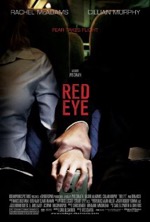
Starring: Rachel McAdams
August 2005
“Craven Puts the Fright in Flight”
The crown prince of horror, Wes Craven, brings us a claustrophobic airplane thriller dubbed Red Eye, a movie that cruises at high altitude and velocity when the jet is in the air, but gets bogged down with contrivances and conventional thriller shtick when it’s grounded. As would be expected, there are several terrifying moments (the head-butt scene on the plane is quite a jolt), but the performances are executed on auto-pilot and Craven’s stiff and straight-forward direction leaves little room for artistic interpretation.
Lisa Reisert (Rachel McAdams), people-pleasing manager of a ritzy hotel, is returning home to Miami from a business trip on a red eye flight. While the flight is delayed, Lisa meets a nice, young man named Jackson (Cillian Murphy from Batman Begins), who buys her a drink and engages her in small talk. As fate, and Craven, would have it, Lisa and Jackson end up seated next to each other and everything is pleasant until the plane reaches cruising altitude. Jackson reveals himself as a contract killer and Lisa is the lynchpin to his plan—all she has to do is call her hotel and arrange for a visiting politician and his family to be switched to a different room, where a rocket (launched from a nearby fishing boat) will take them out. Jackson’s leverage is a hit-man stationed outside Lisa’s father’s (Brian Cox) house. Lisa is forced to make the call, despite several failed attempts at evasion and deception, and she spends the rest of the movie running away from Jackson, while trying to save the politician, his family and her father.
Red Eye maintains its intensity throughout (except for the sluggish first act when passengers wait to board the delayed plane), but some colossal plot holes mar what otherwise could have been a first-rate, Hitchcockian thriller. For starters, why is it so important for Lisa to make the call herself…can’t they find someone who can mimic her voice or use a device that can fashion her previously-recorded words into intelligible sentences? Why is a hotel manager so crucial to terrorist plans? Further, why must they move the politician to a different room? Can’t a rocket be fired just as easily and accurately from a parked car as from an anchored boat? But here’s the kicker; wouldn’t it have been a lot easier for Jackson just to abduct Lisa on the ground and force her to call from her cell phone than to go through the expense, trouble and considerable risk of accosting her on a plane? And what about the corny, generic airline name…Fresh Air? It’s bad enough to see it emblazoned on the tail of the plane, but when the captain comes over the intercom and announces, “Thank you for flying with Fresh Air,” any intensity that had been building up to that point just evaporates in the sweltering Miami heat.
The climactic pursuit at movie’s end has been done so many times before in motion picture history, and a lot more skillfully in most cases, that the last half hour is a chore to sit through. The only unique element to the cookie-cutter, “man stalking woman” ending was when Lisa plowed the hit-man through the front door of her father’s house with a stolen S.U.V. Lisa’s father is dead weight (literally) in the climactic sequence, and, of course, the cops don’t show up until the bad guy is already dead.
Red Eye squanders Murphy’s excellent performance by defaulting to standard thriller fare that’s a lot less graphic than Craven’s typical Rated-R gore—this is horror lite. Advice to Lisa: next time take Dramamine before you board…you can’t be forced to make a life-or-death phone call if you’re out cold!
Rating; 2 1/2
March of the Penguins (G)
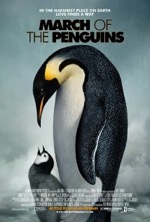
Starring: Morgan Freeman
July 2005
“Chillingly Superb Survival Documentary”
Five minutes into March of the Penguins, I asked myself, “How can they make a full-length feature out of this?” I know I probably wasn’t alone in my sentiment—on the face of it, a documentary about Emperor penguins schlepping and sliding across the gelid Antarctic plains is neither high art, nor highly entertaining. And yet, at the hour and a half mark, when images of the foreign production unit interacting with friendly penguins serve as a backdrop for the rolling credits, I almost felt shortchanged because I had thoroughly enjoyed the film and wanted to see more.
Besides French director, Luc Jacquet, and his team of skilled cameramen, the single greatest contributor to this Warner Independent/National Geographic film is Morgan Freeman’s superlative narration. Freeman’s soothing baritone lends the movie an undeniably comforting degree of warmth that takes the edge off the visually chilling vistas and arctic landscapes (the first time the theater’s AC kicked in, I quickly threw on my jacket).
The movie wastes no time in depicting the plight of the penguins as they waddle seventy miles inland to an icy plain set aside as their mating grounds. The penguins pair off and mate; and after several months the females produce one egg each, which the fathers must keep warm under their downy coats until the mothers return from their feeding…seventy miles to the ocean and seventy miles back. Huddled together to stay warm, the male penguins keep their eggs warm until they hatch…the fathers must feed the chicks with the last meal they’ve stored up for just such an occasion. The males, now on the brink of starvation, anxiously await the return of the females. The females return just in the nick of time and then the fathers are off to feed. When the penguin families are finally reunited, they only have a short amount of time together before they must return to the coast and start the cycle all over again.
The intricacies and delicate balances in the survival of the penguins are astounding…if any part of the cycle is interrupted, the penguins become extinct. In some ways the “stars” of this film are more human than most movies featuring homo sapiens: the opening shots of penguins ambling along the frozen plain are strangely human in appearance and when one mother (whose chick died in the frigid air) tries to steal the chick of another mother, the group intervenes, displaying a degree of swift justice that our courts could only dream of.
March of the Penguins is the sleeper hit of the year and is definitely one documentary that won’t leave you out in the cold.
Rating; 3
Charlie and the Chocolate Factory (PG-13)

Starring: Johnny Depp
July 2005
“Depp’s Wonka Will Give You the Willies”
As everyone on the planet knows by now, this movie is a remake of the 70’s classic, Willy Wonka and the Chocolate Factory. Narratively, the story strays little from the original, but creatively, a whole new world bursts forth thanks to updated special effects (a catchphrase used too often for remakes) and Tim Burton’s skewed sensibilities.
The film’s opening is an instant masterpiece—Charlie Bucket’s (Freddie Highmore) colorful family, including dirt-poor parents and feisty grandparents (both sets sleep on either end of the same bed), really strikes the right chord of likeability and pathos with witty banter, amusing anecdotes and familial harmony amid abject poverty. Charlie’s Grandpa Joe (David Kelly) is a hoot—besides Charlie, he’s the most enjoyable character to watch, especially when he does his little jig after Charlie brings home the magical Golden Ticket from the ultra-rare Wonka Bar.
When the five children and their adult escorts enter the factory, two changes occur simultaneously: 1. creativity and color increase, and 2. intimacy and warmth decrease. Most of the gags inside the factory are virtually identical to the ones in the original, i.e. fatso getting sucked up into a tube and bratty bubble gum champ turning into a giant blueberry (the TV room scene is also here, with updated special effects, of course). Though amusing and well choreographed, I could have done with one less Oompa Loompa (Deep Roy) number (we get the point, already!). However, Roy’s cut and paste performance is truly remarkable.
The dénouement is a departure from the original, but isn’t necessarily unwelcome—Wonka makes amends with his estranged, molar-retentive father (Christopher Lee), and Charlie’s relatives become a surrogate family for the eccentric inventor of all things sweet—Wonka has selected Charlie to be his protégé and eventual heir apparent.
The movie owes its success to Burton’s singular vision and Highmore’s accessible, sometimes-good-guys-do-finish-first performance. However, it’s the cinematic irony of the new millennium that this Johnny Depp vehicle picture was almost sabotaged by Depp himself. To be sure, Depp always turns in quirky, multi-layered performances, and his version of Wonka is no different. Here, however, the character he’s been given to portray is downright creepy—the way Wonka is drawn, wearing silk gloves and face covered in ashen make-up, might be considered poor taste in the wake of the Michael Jackson trial. Besides the obvious Jackson caricature, the character has none of the charm Gene Wilder imbued his Wonka with, and the way Depp condescends the children (especially the “mumbler”) is utterly distasteful. The film succeeds despite Depp’s effeminate Wonka, but how much more enjoyable would the movie have been if Wonka was actually likeable?
Charlie and the Chocolate Factory is a visual delight—during the early stages of the movie, Burton films buildings and people at wildly slanted angles and the Bucket home—complete with a depressed chimney that sags like a greasy French fry—looks like something right out of Dr. Seuss. There’s no doubt that movie magic resides here, perhaps to an even greater degree than the original, and yet, this take on Roald Dahl’s timeless children’s book is tainted by Depp’s quirky protagonist. In the movie’s climax, the glass elevator crashes through the factory roof and seems poised to sail clear up into space…what brings it, and the movie, back down to earth is a Wonka that we merely tolerate for Charlie’s sake.
Rating: 3
Fantastic Four (PG-13)

Starring: Ioan Gruffudd
July 2005
“Calling it Fantastic Would Be a Stretch”
At the end of my review for The Incredibles, I posited the question, “With a similar array of superpowers, has this movie stolen any thunder from next summer’s Fantastic Four?” The answer would appear to be no, at least for adults. Discovering and applying superpowers is a commonality of both films, but some kids may only be familiar with the ubiquitous The Incredibles, unless they’re well versed in comic lore and, naturally, would know that Fantastic Four predates Pixar’s animated juggernaut by a good forty-three years. Unfortunately for this film, many young people will mistakenly think Fantastic Four is ripping off The Incredibles when it’s really the other way around.
There’s no doubt that Fantastic Four is superhero lite—ranking far below the X-Men, Spider-Man and newly invigorated Batman franchises—and yet, despite its clothesline plot, cursory character development and ad hoc science, the movie is a ton of fun. If there’s a saving grace for the movie, it’s friendly banter and humorous side effects to the quartet’s powers: self-absorbed Johnny Storm, a.k.a. the Human Torch (Chris Evans), bursts into flame while snowboarding and creates a hot tub when he takes a spill, and Ben Grimm, a.k.a. the Thing (Michael Chiklis) talks a businessman out of jumping off a bridge, “You think you’ve got problems? Look at me!” A seagull promptly poops on his rocky shoulder. Reed Richards, a.k.a. Mr. Fantastic (Ioan Gruffudd), and Sue Storm, a.k.a. the Invisible Woman (Jessica Alba) discover their mutant powers during a tension-filled dinner: Sue angrily orders Reed to look at her, but she’s faded from view, and later, Reed instinctively elongates his arm to catch a falling glass.
And let’s not forget the villain (as the writers almost did) billionaire capitalist, Victor Von Doom, a.k.a. Dr. Doom (Julian McMahon), owner of the orbiting space station that gets blasted by a solar flare, making everyone onboard fantastic. Dr. Doom plots to destroy the foursome when Sue, the woman of his dreams, returns to Reed. His only full-on act of evil, though, is when he blows a hole through a security guard’s chest.
The climactic battle royale is unsatisfactory in its brevity—the whole movie was building to this epic confrontation, but the infighting between Johnny and Ben (however unsavory) was far more dramatic than Dr. Doom’s last stand. Besides the shoehorn science, the one plot contrivance I couldn’t swallow was Ben’s choice to revert back to his despised, metamorphic alter ego in order to save Reed (Dr. Doom had previously restored Ben’s humanity). Now that’s friendship…or Hollywood!
It’s obvious that Fantastic Four is just a springboard for a sequel/franchise; the movie is just entertaining enough to keep those hopes alive—and that’s no stretch!
Rating: 2 1/2
War of the Worlds (PG-13)

Starring: Tom Cruise
June 2005
“A Soulless Remake Filmed on Cruise Control”
Tom Cruise and Dakota Fanning under the stellar direction of Steven Spielberg in a remake of H.G. Wells’ classic story, The War of the Worlds, is a sure-fire winner, right? As we’ve seen in Hollywood this year (at the time of this writing, the box office is in its twentieth week of a demoralizing slump), all bets are off, especially in a summer replete with remakes.
Remaining fairly faithful to the source material while giving it a modern face-lift, this version of the timeless alien invasion tale takes place in New Jersey and focuses on a divorced dockworker and his two children. The plot is basically the same as all previous renditions: aliens invade earth with terrible, laser-spewing machines that wreak havoc on our cities and citizens until our environment gets the best of them. What’s new here, besides updated special effects, is a shift in perspective: Byron Haskin’s 1953 opus featured a global struggle with leading scientists and top military officers as the main characters. In Spielberg’s take, it’s all about the Ferrier family…Cruise’s deadbeat dad, Ray, Justin Chatwin’s loner-rebel son, Robbie, and Fanning’s doe-eyed daughter, Rachel. The earth-shattering, world-ending events are seen through their eyes, exclusively, and what this approach gains in intimacy it looses in soul and scope.
Even with it’s antiquated special effects, the original movie was far more riveting and fear inducing because it dealt with widespread panic and large-scale destruction. When the atomic bomb fails to leave so much as a scratch on the alien vessels, the viewers are filled with a dreadful realization—our best weapons can’t stop the alien advance. This new War of the Worlds never reaches that level of frantic intensity.
Cruise hits all of his marks but does little to advance the story in any practical or emotional sense, and Fanning has more screams than actual lines in the movie—it’s an oversight of mammoth proportions that a young actress of her caliber was relegated to looks of horror and squeals of terror. The only memorable performance in the movie is Tim Robbins’ Ogilvy, the frantic man who waves Ray and Rachel into an abandoned farmhouse—a frenzied throng is fleeing the onslaught of the tripods and only these three people think to seek refuge in the weather-worn house (more discrepancies to come). Ogilvy is one creepy cuz, but he stands out as the only three-dimensional character amid the coursing sea of cardboard humans in the picture.
As promised, here are just a few of the movie’s many inconsistencies, quandaries or just plain stupid ideas: The alien machines were underground for millions of years and only now decide to attack us? What were they waiting for? In the beginning of the movie, the machines shoot people and turn them into ashes; later on, the machines harvest people, using blood for fuel. Why the change in extermination tactics? The peanut butter sandwich scene is utterly doltish—there has to be an abundance of food in the well-appointed house. Why was so much screen time dedicated to the ferryboat panic when the tripod immediately capsized it? The alien evasion in the farmhouse is reminiscent of the kitchen scene in Jurassic Park and the aliens themselves look like cousins of the invaders in Independence Day.
One of my favorite adapted screenplay writers, David Koepp (Jurassic Park), turned in a soulless, witless script here with some genuine clunkers like the reunion scene where Robbie exclaims, “It’s me dad. It’s me dad.” It’s a shamelessly sappy moment in a supposed action blockbuster. Instead of tugging at the audience’s heartstrings, as was clearly intended, the line sends them reaching for their keys.
Maybe it’s just that the 50’s version was one of my favorite movies when I was a kid, but this new War of the Worlds fails to satisfy in nearly ever way, save for the terror-instilling, blood-curdling tripods (the finest element in the movie). Retaining the opening, mood-setting narration was a nice touch, and tapping Morgan Freeman to perform the voice-over was a masterstroke. Also, John William’s Jaws-inspired soundtrack stands out as one of the movie’s only highlights.
War of the Worlds is as mechanized and methodical as its tripods. It attempts to generate sympathy by focusing on the Ferrier’s, but fails to make the desired connection due to underexposed characters. Suggestion: Save your money and rent the original movie. Or better yet, just read the novel.
Rating: 2 1/2
Bewitched (PG-13)

Starring: Nicole Kidman
June 2005
“Adds Modern Ingredients to the Old Witch’s Brew”
Instead of simply upgrading the 60’s sitcom to the big screen, this new, improved Bewitched takes the viewer inside the casting process and tedious production of a new TV series and the drama that swirls around the re-telling of a classic show. Sound confusing? It’s not; in fact, the entire movie is dull and overly simplistic—it doesn’t take a crystal ball or tea leaves to figure out the paint-by-numbers plot, and the one area of the movie where magic should have fulminated like a fireworks finale—the relationship between Jack Wyatt (Will Ferrell) and Isabel Bigelow (Nicole Kidman)—is pedantic and predictable.
To be sure, Ferrell and Kidman are fine actors, but their chemistry here is scanty—like the amount of onscreen time actually dedicated to the romantic subplot—and their relationship is asserted not shown. Very little character development is conjured up in the movie, save for Isabel’s struggle against her insatiable desire to get whatever she wants by using magic...she’s a reformed witch. Her antagonizing father (Michael Caine) pops up from time to time (as the Gorton’s Fisherman or Jolly Green Giant in the freezer aisle—the most creative visuals in the film), and heckles her over the futility of eschewing her magical powers. Though hard-fought and heart-felt, Isabel’s internal battle with her own nature is a loosing effort; she abandons the kenosis and is soon back to her old lobe-wiggling tricks.
The scene where Jack meets Isabel in a café—Jack observes Isabel’s natural ability to do the “nose twitch” and convinces her to audition for the new Bewitched show, Isabel agrees because she mistakenly thinks Jack is the perfect man—is utterly doltish...in fact, most of the scenes on the TV set are downright silly. Shirley MacLaine’s character, an undercover witch, is really more of a nuisance than a supporting player. Uncle Arthur’s (Steve Carell) random appearance serves as a voice of reason for Jack, who clearly needs to catch a clue about Isabel’s attraction to him, but the scenes are so teeth-grindingly annoying that after Carell’s character exits the screen, you have to scratch your head and wonder what the heck it was you just saw. There are only two standout scenes in the movie: 1. On the set, red-faced Isabel tells Jack he’s a jerk, and 2. Jack fails to realize Isabel is a “real” witch until she pulls out her broom and takes flight.
Though Bewitched casts a weak spell, it somehow works as mindless entertainment. As bad as the movie is, it would have been even worse if the producers had taken the easy route and simply made Bewitched a retread of the original series. Either way, Bewitched suffers from remake-itis…there’s little magic here.
Rating: 2 1/2
The Perfect Man (PG)
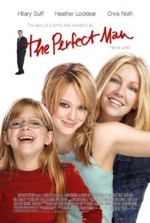
Starring: Hilary Duff
June 2005
“Average Love Tale is Anything But Perfect”
The normal response to a breakup is a desperate rebound or a period of profound depression. An extreme or dysfunctional reaction to a severed relationship is when you pack up your troubles and move to a new town. Such is the repeated and unhealthy pattern of Jean Hamilton’s (Heather Locklear) tumultuous love life. After the latest in a long line of failed relationships, Jean uproots her family, again, and moves them to Brooklyn. Jean’s teenage daughter, Holly (Hillary Duff), has a personal website that lampoons her family—on it she grouses about her transitory life and her mom’s predilection for botching relationships and, indeed, choosing losers in the first place.
It’s not long before Jean attracts a well-leavened doughboy at the bakery where she works—a needy, heart-on-the-sleeve type named Lenny (Mike O’Malley), who employs such lines as, “Where did you buy those pants…Hottie.com?” Eventually, Lenny wears Jean down and takes her to a Styx concert—he cries nostalgic tears through the entire performance and uses her sleeve as a handkerchief. Jean is so desperate for the perfect man—or any man, for that matter—that she looks past Lenny’s neurotic behaviors and seriously considers saying yes when he serenades her from the fire escape and proffers her an engagement ring.
Holly detests Lenny and goes into emergency split up mode, especially when she meets her new girlfriend’s uncle Ben (no pun intended, I’m sure). In Holly’s mind, Ben (Chris Noth) is the perfect man, but if her mom ever meets him, she’ll find a way to sabotage the relationship—as she always does—and Holly and her younger sister will be forced to move again. Holly begins sending letters and emails to her mom as Ben and begs Adam (Ben Feldman), her high school crush, to call her mom posing as Ben. Jean admits that Ben sounds like the perfect man, but Holly’s plan backfires when Jean wants to meet him. “Ben is a beautiful idea, but you can grow old with an idea,” Jean reasons.
Though Holly consistently displays more common sense than her mother in the movie, the writers involve her in some silly matchmaking scenes like the orchid delivery or the mishap at the restaurant where she sets off the fire suppression system to prevent her mom from encountering Ben—these sequences attempt to generate peril and move the slogging plot along, but to no avail. As the script would demand, Jean and Ben finally meet at the movie’s gloaming, but the casual manner in which they speak to each other tells us what we’ve known all along…there’s no guess work here, no mystique, no panache, only a foregone conclusion.
The movie’s entire premise is a sick one—an abnormal scenario that should repulse most viewers. The Perfect Man is contrived, formulaic and predictable at every turn, with a hurried and unsatisfactory ending and performances that match the mediocre script. It’s never explained why Jean keeps relocating her family every time a relationship ends; did her father abandon her when she was young? Did Jean’s mother also run away every time her heart was broken? A much better story would have been: Jean and Ben hook-up earlier in the movie but Jean panics the first time their relationship hits a speed bump and falls back into the old pattern of wanting to run away. Ben confronts Jean and opens her eyes to her insecurities; they work through her issues and then they live happily ever after. Though such a dramatic tangent would dull some of the chick-flick edge, at least it would lend the movie some semblance of a plot.
Romance movies are among the hardest to pull off on the big screen and The Perfect Man is the perfect example; the movie plummets even with the two cuties (Locklear and Duff) and debonair Noth. Just as it was kismet that Jean and Ben would meet at the end, it was also destiny that the film would fail to meet our expectations.
Rating: 2
Batman Begins (PG-13)

Starring: Christian Bale
June 2005
“The Dark Knight’s Sordid Origins Are Finally Revealed”
I was never a fan of the campy 60’s TV series, but I’ve read my fair share of Batman comic books. I saw the Dark Knight’s theatrical hat trick in the 90’s, and though I enjoyed moments of those Gothic tales (except for Schumacher’s debacle), I’ve always been a proponent of Batman: The Animated Series and have contended since its inception that any of those brilliant, half-hour episodes are better than the movies…until now.
Director, Christopher Nolan, has returned Batman to his essential and elemental roots in the globetrotting origins tale appropriately dubbed, Batman Begins. From the opening sequence, where young Bruce Wayne falls into a pit teeming with squealing bats, to the final scene where Batman (Christian Bale) and Lieutenant Gordon (Gary Oldman) discuss a clue that will lead them to next movie’s villain, this is the movie I, along with countless millions, have been chomping at the cowl to see…the birth of Batman.
Avoiding the pitfalls of the past (i.e. psychedelic neon lights or nippled Bat-suits), screenwriter, David S. Goyer, has drawn fully realized characters in real life situations…no oversized props or larger-than-life villains here. Goyer clearly did his homework for this project, researching the Dark Knight’s haunted past and neurotic present—he masterfully cuts back and forth between Bruce Wayne’s boyhood tragedies and adult struggles with fear and injustice. There’s a fair amount of social commentary in the movie that, thankfully, never comes across as stilted: themes of government corruption, societal degradation and terrorist infiltration of our infrastructure run rampant throughout the film. Besides a powerfully gripping and salient story with finely chiseled characters, Goyer’s dialogue is witty, incisive and delightfully variegated (though Gordon’s reaction to the new Batmobile, “I’ve gotta’ get me one of those,” was a bit much).
Nolan has assembled a dream cast headlined by Bale, whose previous movie, The Machinist, called for a severely emaciated insomniac—the Welsh thespian gained 100 pounds in six months to adequately fill out the Bat-suit. Bale just might be the best big-screen Batman ever—he perfectly captures Keaton’s brooding melancholy and exhibits more humanity and vulnerability than either Kilmer or Clooney. Bale’s gravelly baritone is more menacing than any previous, live-action actor (no one will ever eclipse The Animated Series’ Kevin Conroy) to don the cape and cowl.
Aside from Crash, Batman Begins boasts this year’s finest supporting cast of A-list actors, including: Michael Caine, Liam Neeson, Katie Holmes, Oldman, Cillian Murphy, Tom Wilkinson, Rutger Hauer, Ken Watanabe and Morgan Freeman. In an ironic turn, Neeson plays Ducard, Bruce’s Jedi-esque instructor, whose seemingly limitless knowledge veils a dangerously misguided soul. Murphy is pitch-perfect as the chillingly calculated Dr. Crane/Scarecrow, and Caine is the anchor and conscience (not to mention comic relief) of the film as the staid butler, Alfred—the scene where he struggles to get unconscious Rachel (Holmes) into the backseat of a car is uproariously funny.
Nolan’s bold vision has reinvented and reinvigorated a comatose, left-for-dead movie series. For legions of hopeful fans, or snake-bitten skeptics, who desperately want to believe that Batman is still a popular and profitable property, this movie should assuage any lingering doubts as to the Dark Knight’s appeal and potential—the franchise has faced its darkest fears and overcome them in grand, heroic fashion (much like our redoubtable protagonist). With Bale already onboard for a sequel and Nolan hinting at a trilogy, Batman’s screen future seems as secure as a lodged Batarang.
I’m extremely stingy when it comes to handing out perfect scores, but my only snafu with Batman Begins is that Gotham City is Chicago, not New York as I prefer—and that’s pretty picayune. The only trouble the series now faces is a name for the sequel…Batman Continues?
Rating: 4
Mr. & Mrs. Smith (PG-13)
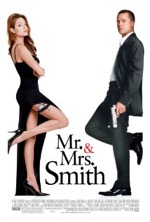
Starring: Brad Pitt
June 2005
“Smith Happens in This Paranoid Bullet-Fest”
Brad Pitt and Angelina Jolie are big-screen eye-candy—a built-in box-office draw for ogling members of both genders—but it’s too bad the script they had to work with here wasn’t as sweet. Mr. & Mrs. Smith is one paranoid affair: for five or six years, John (Pitt) and Jane (Jolie) Smith have maintained the semblance of a perfect marriage while leading double lives as assassins for two different covert agencies. Jane always has dinner ready when John gets home at seven pm, and they dispassionately discuss their days’ like two news anchors covering a human interest story—their table talk is peppered with so many generalities and pleasantries, you’d swear the pair just met for the first time. The escalation of knives sequence is amusing as is Jane’s oven armory, but these scenes soon grow tiresome because the audience is in on the joke, but the Smith’s aren’t.
At the thirty-minute mark, the first hint of a plot surfaces when John and Jane are assigned the same mission by their respective agencies. The operation is bungled and the match is a draw, but the evidence left behind leads the Smith’s to a startling discovery (one that we’ve known about since we saw the trailer)…their spouse is an enemy agent. There’s a scene—which becomes tedious after the first volley of bullets—where the Smith’s make Swiss cheese out of their house while trying to kill each other with an arsenal of guns, knives and any other weapon they can get their hands on. When attrition finally sets in and a stalemate becomes evident, the Smith’s realize all the blood, sweat and passion is a turn on and they begin making out amid the rubble; but the reunion of lovers is short-lived as another group of assassins arrive and put more holes in the walls.
Having sat through the first half of the movie in chronic boredom and utter disappointment, I found the last half to be a vast improvement: the Smith’s team up against a common enemy and finally open up and share the truth about their sordid pasts. I found their banter to be especially amusing during the car chase scene—Jane admits to having hired stand-in family members at their wedding—and the final, destructive showdown in the warehouse is an elegant death dance with Matrix-style action shots.
Vince Vaughn plays his standard wide-eyed weirdo as John’s best-friend-turned-enemy and Kerry Washington briefly pops up as one of Jane’s aides. I have no qualms about the acting, but the trouble with Mr. & Mrs. Smith, besides its skewed reality of extreme deception and destruction, is that it becomes a parody of itself. Perhaps this story would have worked better as a sci-fi film, as our disbelief would already be suspended to lofty heights. In the real world, this kind of paranoid farce only flies if you’re watching Alias at a fondue party—and you don’t have to pay ten dollars for that!
Rating: 2 1/2
Madagascar (PG)
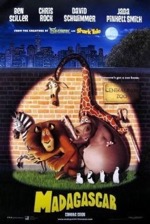
Starring: Chris Rock
May 2005
“Animated Zoo Animals on the Lame”
Star Wars has its clone wars, but Madagascar is a clone. Virtually identical to every other CG animated film that’s come along in recent years, Madagascar is just a poor excuse to thrust a handful of cute, cuddly animals into situations already experienced by toys, monsters, fish, robots, etc. in the hopes of achieving box office success. This time it’s a zebra, not a donkey, who longs for adventure and companion-ship, but the striped quadruped’s repetitive shtick, delivered by Chris Rock futilely attempting to channel Eddie Murphy, will quickly annoy any audience member older than ten.
Alex the lion (Ben Stiller), the prima donna of the Central Park Zoo, gives pal, Marty the zebra, a birthday present—a new “Alex” snow globe from the zoo’s gift shop. When Marty blows out the candles on his cake, he wishes he could take a trip into The Wild. Worrywart giraffe, Melman (David Schwimmer), coaxes Marty into revealing his wish, which proves to be bad luck when Marty disappears the next morning.
An ill-fated attempt at rescuing Marty results in the animals being captured and shipped off to a foreign zoo, but fortunately, four stowaway penguins shanghai the cargo vessel and steer it toward warmer environs. While arguing inside their cargo boxes, Alex and company fall overboard and wash up on the paradise island of Madagascar—they think they’re in San Diego. Marty is high on his new-found freedom, but Alex, accustomed to being pampered by zoo workers, instantly loathes his new home.
The most amusing scene in the movie is when Melman and hip hippo, Gloria (Jada Pinkett-Smith), defect to the “fun side” of the island, where Marty has constructed a swinging cabaña complete with saltwater drinks, leaving sourpuss, Alex, to stew in his own misery. Ultimately, Alex comes around, but not before his predatory instincts kick in and he finds his jaws around Marty’s hindquarters. Fate smiles upon the Central Park quartet—and a grateful audience—when the four penguins show up with the ship at the hour and a half mark to rescue their friends from savages, and us from acute boredom.
Madagascar hinges on the friendship between Alex and Marty, but their interactions are so similar to the ones between Shrek and Donkey, that the story never really has a chance to stretch its legs. The through line is straighter than an arrow shot by Legolas and the movie’s only twist, Alex’s primal regression, is resolved far too quickly and with little panache (save for his kaleidoscopic hallucinations of juicy steaks). The only character that’s halfway interesting is hypochondriac Melman—the scene where Alex tries freeing the giraffe from his cargo container is humorous.
Though rife with messages of friendship, freedom and the need for flexibility, Madagascar is overly simplistic and overtly formulaic—certainly not an effort worth taking pride in.
Rating: 2
Star Wars: Episode III—Revenge of the Sith (PG-13)
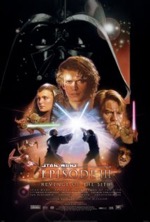
Starring: Ewan McGregor
May 2005
“Lucas Signs Off With a Vengeance”
“The circle is now complete. When you left I was but a learner. Now, I am the master.” Darth Vader’s formerly cryptic words in Star Wars: Episode IV—A New Hope now find clarity and resonance in light of the dark, tragic and force-shifting events that occur in George Lucas’ latest and last Star Wars film: Episode III—Revenge of the Sith.
For about the first fifteen minutes of the film, I thought I was in for the same pedestrian plot overshadowed by whiz-bang effects like in the last two episodes—a massive battle rages over city-planet, Coruscant, and Obi-Wan Kenobi (Ewan McGregor) and Anakin Skywalker (Hayden Christensen) dodge exploding vessels and fend off an onslaught of vulture and buzz droids—but when the Jedi warriors tag-team nefarious Count Dooku (Christopher Lee) under the watchful and gleeful gaze of Chancellor Palpatine (Ian McDiarmid), I saw the potential for the kind grand storytelling last seen in the original trilogy. The lightsaber battle is eerily similar to the one featured at the climax of Return of the Jedi, only this time, Palpatine/Sidious knows he has his man in the tortured, hate-infused dynamo, Anakin Skywalker, who beheads Dooku at Sidious’ request…unwittingly opening a position on the Sith roster which he will rapidly fill.
Rapid is a word that aptly describes Episode III, both in Anakin’s accelerated descent into the Dark Side of the force and in the film’s hyper-speed pacing. Much of the movie is typical Star Wars camp—especially the ever-leaden dialogue and passionless love scenes—but Episode III boasts several show-stopping action sequences and dramatic crescendos, including: Mace Windu (Samuel L. Jackson) and company arriving to arrest Palpatine, Anakin’s fateful choice to follow Sidious, Anakin’s cleansing of the Jedi temple, Yoda and Sidious engaging in a wizard’s duel and, of course, the final, epic showdown between teacher and pupil—a haunting scene that’s been common knowledge in fan circles since the late seventies. Add to that the gut-wrenching montage of clone troops turning on their Jedi leaders and you have a visually stunning, powerfully moving film.
What’s refreshing about Episode III is that it’s the first prequel to properly balance story and special effects. It’s been rumored that Lucas had more focus and passion this time around and you can see that renewed enthusiasm for his oft-neglected brainchild translated onto the screen. The visionary auteur has also waved his Jedi fingers to evoke a wider range of emotions from his actors this outing, except for Natalie Portman, whose lack of story involvement seems to have cued her uninspired performance. Hayden Christensen’s acting has vastly improved from his “Obi-Wan is holding me back” days; he delivers a believable, multi-layered performance that lends credibility to Anakin’s seemingly sudden transformation into Darth Vader.
Episode III’s spotlight is squarely fixed upon Christensen’s character, but the movie would have found itself charbroiled in a lava pit without stellar support from the two Mc’s. McGregor’s turn as the older, wiser Obi-Wan anchors the movie in much the same manner that Liam Neeson’s Qui-Gon Jinn did in Episode I—there’s a new level of maturity and weight to Obi-Wan and his scrappy fighting style lends personality to the movie’s static and prolific lightsaber confrontations. McGregor’s impassioned, “you were supposed to be the chosen one” monologue contains finer dialogue and more unbridled, visceral emotion than the rest of the prequel trilogy combined—it’s THE moment of the entire Star Wars myth. McDiarmid is absolutely delicious as the insidious Darth Sidious (Lucas and his names!); he’s so good at presenting the virtues of the Dark Side that he makes Anakin’s swift conversion plausible. The Scottish thespian’s sinister basso profundo is one of the best effects in the film—Sidious’ hypnotic timbre in tandem with convincing stories, like the chilling tale of Darth Pleagus, draws Anakin into his web of deception and is the solitary reason why the audience buys into Anakin’s accelerated transfiguration.
Lucas enlisted the help of his good friend, Steven Spielberg, on some of the movie’s most heart-pounding action sequences, and you can tell—no more silly pod races or droid factory chases created with an eye on the arcade. The special effects are crisper than ever (except for the constipated clone troopers), and in some cases are too refined…R2-D2 seems to undergo a series of upgrades for each new film, begging the question, “Why couldn’t he do that before?”
Pundits have said that if you’re consciously aware of the score when watching a movie, the composer has failed in his/her role of servicing, not dominating, the narrative. I never thought I’d ever write these words, but John Williams’ derivative sound track for Episode III severely disappointed me—besides recycling material from nearly every other Star Wars film, he also regurgitated the main title from The Lost World (1997) for the attack on the Wookie homeworld. The greatest living motion picture composer should have delivered a more “original” score for his final trip to a galaxy far, far away.
Episode III approaches epic status and has effectively returned the films to their space opera roots. This is arguably the best episode since the original Star Wars and is a gratifying and satisfying conclusion to Lucas’ sprawling space saga—he’s tidied up all the loose ends and signed off in grand fashion. When Obi-Wan delivers infant Luke to Aunt Beru on Tatooine in the final scene—the desert planet’s twin suns poised to dip behind the painted horizon in a familiar tableau—it doesn’t take a Sith sense to know that Star Wars has come full circle.
Rating: 3 1/2
Kicking & Screaming (PG)
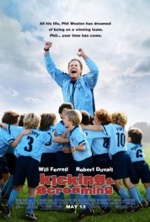
Starring: Will Farrell
May 2005
“It’s What You’ll Be Doing To Get Out of the Theater”
Call it the Bad News Bears of soccer, Kicking and Screaming is unsatisfactory as a sports movie and unsavory as a family movie. Just a few months ago, I saw a Woody Allen film entitled, Melinda and Melinda, which starred, among others, Will Ferrell. Ferrell was mesmerizing as a man estranged from his wife and falling in love with another woman. He showed promise as a dramatic actor and demonstrated a range previously unseen, and frankly, unimagined. Unfortunately, with Kicking and Screaming, Ferrell is back to his normal, comedic shtick and only displays an occasional flicker of his former brilliance.
Phil Weston (Ferrell) has spent his entire life in the shadow of his choleric, tough guy father, Buck (Robert Duvall), and has never lived up to Buck’s standard as a husband, father, businessman or human being. Phil was all elbows and knees when playing sports as a kid and held a permanent spot on his father’s bench. Now, when Phil learns that Buck traded his son, Sam, to a lower ranked team to give the boy more playing time, he spitefully accepts the vacant coaching position on Sam’s new team. Phil is out of his league as a coach, especially when taking on Buck, so he enlists the help of his father’s chief rival and next-door neighbor to be his assistant coach—Mike Ditka.
Ditka introduces Phil to coffee (the fuel of champions) and Phil is soon addicted, downing cup after cup at coffee shops and setting up an espresso machine on the bench during games. The team starts winning, thanks to Ditka’s expert guidance and the assistance of two Italian soccer prodigies—the boys can only play when all of their father’s meat orders are delivered (meat comes first). Phil’s newfound lust for winning, coupled with his strict coffee diet, sends him over the edge; he benches his son and the rest of the players are uneasy around the person he’s become. After his wife brings him back to reality, Phil destroys the coffee machine, apologizes to the team and reverts to his former, friendlier self. Throwing out the playbook and admonishing his kids to just have fun, Phil beats his father in the championship game and breaks the curse of his childhood.
If there’s a moral here, it’s murky, and Phil’s coaching tactics while under the influence of coffee (i.e. breaking opponent’s ribs) are reprehensible—the scene isn’t even remotely funny and certainly doesn’t belong in a family film. The movie tries to be a comedy, but isn’t—the coffee subplot is utterly ridiculous and Phil’s awkwardness around the lesbian couple might have been amusing ten years ago, but bombs here. The movie tries to be this year’s feel-good sports movie, but fails miserably. Kicking and Screaming tries to be entertaining, but sails far wide of its goal.
Rating: 2
The Hitchhiker’s Guide to the Galaxy (PG)
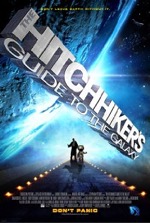
Starring: Martin Freeman
April 2005
“High Concept Fare With a Large Dose of the Bizarre”
What would you do if a fleet of bulldozers showed up on your front lawn and you were handed a legal document stating your house was to be demolished to make way for a new highway? Better yet, what would you do if you knew for certain that you only had two more minutes to live before the earth was wiped out by greedy aliens bent on destroying our planet to make way for a new intergalactic express route? If you choked on a popcorn kernel reading that last one, take this as your cue to run, not walk, out of any theater showing The Hitchhiker’s Guide to the Galaxy, the new sci-fi romp based on the best-selling book by Douglas Adams.
However, if you’re stout of heart and can stomach the vile behavior and hideous appearance of the sumo-sized bureaucrats named Vogons (or endure several minutes of their torturous poetry), you might just be in for an amusingly whimsical, albeit bizarre, journey through the warped and unpredictable reaches of outer space. In any event: “Don’t Panic!” And whatever you do, don’t forget to bring your towel.
Arthur Dent (Martin Freeman) is the hapless, witless soul who must sacrifice his house on the altar of progress, but fortunately, his good friend, Ford Perfect (Mos Def), is not from our world and beams himself and Arthur onto the Vogon mothership just before it makes meteorites out of the earth. Escaping the rusty, grimy Vogon ship is a death-defying task, but Arthur employs the wisdom of the wickedly satirical Hitchhiker’s Guide and he and Ford are soon floating free in space. Did you know that it’s possible to survive in space for a few seconds by holding your breath? Either did I.
Fortune, again, smiles upon Arthur and Ford as they’re beamed aboard a friendly vessel that just happens to be in the vicinity. The stolen, spherical ship belongs to the President of the Universe, Zaphod Beeblebrox (Sam Rockwell of Galaxy Quest fame), who has two heads/personas, a manic depressant robot named Marvin (voiced by another Galaxy Quest alum, Alan Rickman), and a girlfriend named Trillion (Zooey Deschanel), who had a brief fling with Arthur in the not too distant past. Beeblebrox is on a mission to visit mythical world, Magrathea, but along the way he runs into his campaign opponent, John Malkovich, who makes a brief appearance as the priest of a sneezing cult. Ultimately, Malkovich’s character is just a grace note in the zany script and his presence is utterly superfluous, as he never appears again in the film.
When the party finally reaches Magrathea, they discover the super-computing oracle, Deep Thought. In the distant past, Deep Thought cogitated that the answer to life, the universe and everything is 42. Now, after pondering for eons, Deep Thought will reveal the “ultimate question.”
If all of this is a bit difficult to follow (or swallow), it’s because Adams’ story is dense and shallow at the same time. The story’s aliens, customs, planets, etc. are all well thought-out and fully realized, but the character development is spare and many plot elements are bizarre, ludicrous or obnoxiously random. Here are just a few examples: Dolphins, the third most intelligent species on our planet, have been trying to warn us of our impending doom for years, but we’ve misinterpreted their attempts at communication as playful flips and tricks. On the Vogon homeworld, giant flyswatters pop up out of the desert sands and smack unsuspecting travelers in the face (the scene is actually pretty humorous). An omniscient being—who just happens to have a spare earth sitting around—tells Arthur that it’s mice, not men, who really rule our world. My favorite oddity, however, is the “Improbability Drive,” an obvious poke at Trek’s warp drive, which spews the ship out into alternate realities—the “yarn universe” sequence is nothing short of genius.
For all its inherent strangeness, The Hitchhiker’s Guide to the Galaxy has several saving graces—it’s witty, clever and wildly imaginative. This makes the movie viewable, if not instantly accessible. It will be interesting to see if Hitchhiker’s ticket sales will permit us to visit The Restaurant at the End of the Universe.
Rating: 2 1/2
The Interpreter (PG-13)
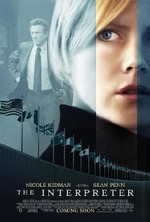
Starring: Nicole Kidman
April 2005
“A Highly Involved Thriller That’s Hard to Interpret”
The Interpreter should have been great. With two powerhouse actors in Sean Penn and Nicole Kidman, an A-list director in Sydney Pollack and a solid yarn spun from storywriters Martin Stellman and Brian Ward, and screenplay writers Charles Randolph, Scott Frank and Steven Zaillian, The Interpreter should have been the thriller of the year. Instead, it’s simply a good movie that features fine performances and a plot that is fairly relevant in our terror-wracked world.
Silvia Broome (Kidman), a skilled U.N. interpreter, returns to work late one night to retrieve a bag and overhears a whispered conversation detailing plans to assassinate a despised foreign leader, Zuwanie, in two days hence. Enter Tobin Keller (Penn), a member of the secret service, who is commissioned to investigate Silvia’s claim and verify her veracity or verisimilitude. At first, Silvia and Tobin’s conversations play out like a series of chess moves, but they gradually develop a tenuous friendship after opening up about their painful pasts. Some of the movie’s standout events are: a bus bombing, a man in a mask standing outside Silvia’s window on the fire-escape, and, of course, the climactic assassination attempt on the foreign terrorist’s life.
The Interpreter is engaging, if not a bit plodding at times, and spins elaborate webs of political intrigue, dark motives and sordid pasts. However, there’s so much going on in the movie, that the multitude of players and situations actually becomes a deterrent to the movie’s accessibility and enjoyment. What’s more, the end is patently predictable and there’s no real emotional payoff in the film.
Penn is solid, but he certainly isn’t stellar, and we’ve seen Kidman in meatier roles (The Hours), as well. The scene where Tobin tells Silvia that his wife died only twenty-three days earlier is the emotional core of the movie, but the meaningful interplay, like a New York minute, is over far too quickly and we’re back to muddy narrative and impotent action sequences. It’s a shame these two award-winning actors weren’t given the kind of material that would properly showcase their exceptional talents.
One gratifying aspect of the movie, however, is the extensive filming inside the U.N. building—this is the first movie to be accorded such a privilege (Hitchcock’s 1959 opus, North By Northwest, received no such dispensation, but the genius auteur grabbed a shot of Carey Grant climbing the steps of the U.N. building from across the street).
In the end, The Interpreter translates into an underachieving thriller that will soon blend in with all the other mediocre suspense films at Blockbuster.
Rating: 2 1/2
Sahara (PG-13)

Starring: Matthew McConaughey
April 2005
“Savvy Adventure Film is a Trove of Wit and Whimsy”
Sahara opens with a pulse-pounding sequence: bombs exploding like fireworks in the night sky, Union and Confederate soldiers exchanging fire and the last ironclad ship running silent while evading cannon fire. The “Ship of Death” was rumored to carry a cargo of rare coins, but the vessel disappeared shortly after the conflict and has, for over a century, confounded historians and treasure hunters, such as...
Dirk Pitt (Matthew McConaughey) and Al Giordino (Steve Zahn), who have been searching for clues to the whereabouts of the mystery ship, receive a dubious tip that leads them to the Niger River where they encounter Eva Rojas (Penelope Cruz) and her World Health Organization entourage. Eva is in the region responding to a deadly outbreak that causes the eyes of its victims to mutate into something you’d see in a horror movie. As fate, and Clive Cussler (who wrote the novel Sahara’s screenplay is based on), would have it, Eva joins up with Dirk’s team under tumultuous circumstances—in an effort to avoid capture, Dirk and Al blow up a boat owned by their pragmatic boss, Admiral Sandecker (William H. Macy), and bloodletting rebels slaughter Eva’s team.
Any romantic potential between Dirk and Eva takes a backseat to the story’s unquenchable thirst for adventure and, in the end, it’s simply a foregone conclusion that the pair will hook up…and they do. As a character, Dirk Pitt is an enjoyable blend of Indiana Jones and James Bond—though failing to capture the appeal of either action icon—and McConaughey plays the character with the proper degree of boyish insouciance. Dirk’s sidekick, Al, fulfills his role as comic relief, but by the movie’s midpoint, his one-liners become as stale as outdated field rations…it’s a shame his character (or any other in the movie, for that matter) is never given the opportunity to become anything more than a cardboard stand-up.
As if a Civil War-era ship buried in the ubiquitous sands of West Africa isn’t far-fetched enough, Dirk and Al, in a scene that tries to be clever but isn’t, instantly throw together a ramshackle land yacht with spare parts from a crashed plane (Macgyver is green with envy). Or, how about the exhilarating, one-in-a-trillion cannon shot that takes out an enemy helicopter (granted, the movie pokes fun at itself here when Dirk and Al exclaim, “There’s no way that should’ve worked!”). And what about the ensuing flirtation with deus ex machina when natives lining the cliff scare off the bad guys—a tableau reminiscent of the one seen in Quigley Down Under? Perhaps the worst rip-off, however, is the action sequence at the recycling plant, which plays like an insipid James Bond riff…French “heavy,” Yves Massarde (Lambert Wilson), is a flaccid foil for Pitt.
Despite its many contrivances, Sahara is wildly entertaining and features a rousing climax (the cannon shot, not the beach scene). With several other Cussler novels to excavate, it’s very likely we’ll be seeing Mr. Pitt exploring the past again in the near future.
Rating: 2 1/2
Millions (PG-13)
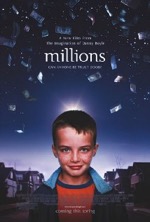
Starring: Alex Etel
April 2005
“Smart and Stylish: The Next Generation of Family Film”
Damian (cherubic Alex Etel) and Anthony (Lewis McGibbon) are seven and nine year old British boys, respectively, who have recently lost their mother—and to add insult to injury, their father moves them to a new neighborhood and school. Damian is a dreamer with a truly beautiful and innocent mind; a young man who can rattle off statistics about Catholic saints faster than any priest this side of the papacy, and who is oft visited by such venerated figures in his fertile and impressionable imagination. Damian builds an elaborate cardboard fort near some train tracks and fancies himself an astronaut when the train rumbles past—the raucous rumble of boxcars, the strident sound of wheels on steel and jostling vibrations that threaten to topple the makeshift shelter all simulate a lift-off sequence, and in his mind, Damian is launching into space.
On one fateful day, a duffel bag flies free from the train and flattens a section of Damian’s ramshackle fortress: curious, Damian opens the overstuffed bag to discover bundles of cash. Damian confides in Anthony and the two are soon building towers out of money stacks in their room. Replacing the cash and hiding the bag under their bed, they vow not to tell their father.
Damian consults his imaginary companions for guidance on how best to use the money: the saints suggest giving a portion to the poor, which he does without a moment’s hesitation. Whereas Damian’s motives are honorable, Anthony uses the money for personal gain—he hires bodyguards to protect him at school and buys friends by handing out bills.
Inevitably, word gets out that the boys are wealthy and they attract unwanted attention; a problem not aided by Damian’s impulsive acts of altruism, i.e.: dropping cash down the mail slot of a poor man’s door and tossing a bundle into the collection bucket for a school charity. The boys’ delirium over finding the cash is quickly replaced by guilt, fear and paranoia, especially when the money’s rightful owner shows up—a creepy drifter whose attempts at manipulating Damian amps up the thriller section of the movie. Another effective story device that adds tension to the more intimate and pedestrian moments in the movie is the conversion of currency to the Euro. With the deadline drawing closer and the shady man scheming for the money, Damian and Anthony turn to the only person they can trust…their father.
Millions is worth every penny of its namesake and has affectively ushered in a new era of family-friendly films—sophisticated and stylish, the movie embraces the Nickelodeon bunch without alienating the adult set. It’s ironic that this vanguard in family pictures comes from such and unlikely director, Danny Boyle (Trainspotting), but the auteur has crafted an exquisite film both in character and creativity. The time-lapse sequence at the beginning of the movie—an entire sub-division springs to life before our very eyes—is absolutely brilliant. The cell phone scene is also wildly imaginative: the brothers, sitting side-by-side on top of a hill, carry on a conversation with each other and two red, vertical lines reaching toward the sky represent the satellite link between them.
As young Damian, Etel is a revelation in pure, unadulterated innocence—his childlike wonder is truly the highlight of the film. Damian asks every imaginary saint he meets if they’ve heard of a new arrival named Saint Maureen, but none of them have. The movie’s emotional payoff comes near the end, when Damian is reunited with his departed mother (the saint he’s been inquiring about) in a tender vision—the moment of poignant closure allows the young boy to finally move past his mother’s untimely death.
The only scene I could have done without is the controversial depiction of St. Peter. Here, the disciple is a swearing, smoking, heresy-espousing figure with a tilted halo and a humanistic account of Jesus’ miracle of feeding the 5,000. Unfortunately, this brief exchange stands out as an unseemly tear in an otherwise beautiful tapestry woven by skilled screenwriter, Frank Cottrell Boyle.
Destined to become an annual favorite at Christmas time (the movie’s climax takes place during the Holiday season), as well as a chart-topper on family film lists for years to come, Millions is a rare breed—entertaining on many levels and salient for every generation, the movie is truly one in a million.
Rating: 3 1/2
Guess Who (PG-13)
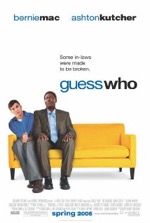
Starring: Ashton Kutcher
March 2005
“A Mediocre Meet the Parents Rehash”
The movie’s title asks a question anyone who’s seen the trailer knows the answer to. Unfortunately, like most movies these days, the best scenes from Guess Who were spoiled in the trailer, which promised a light-hearted romantic comedy dedicated to watching a young white man squirm as he meets the parents of his black girlfriend.
Guess Who is the latest in a long line of feeble attempts at “modernizing” classic movies—in this case, Spencer Tracey’s 1967 melodrama, Guess Who’s Coming to Dinner. Here, races are reversed and Simon Green (Ashton Kutcher) must stare down his girlfriend’s watchdog father, self-styled bank loan officer, Percy Jones (Bernie Mac). At first, Percy can’t stand Simon and does everything in his power to make Simon’s life miserable, including sleeping with him on a hide-a-bed in the basement and padlocking the basement door. Over time, Percy begins warming up to the idea of Simon and his daughter, Theresa (Zoe Saldana), being together, but not before the stubborn pair become embroiled in spats, accidents and a lonely night apart from their sweethearts.
A movie of this kind, clearly, had more social relevance in the turbulent 60’s than it does in present-day America—the racial tension the script seeks to employ has marginal effectiveness in our world of increasing tolerance. As a result, the movie is an insipid comedy that tries to be funny, receiving meager support from its middlebrow premise and anemic screenplay. Granted, there are a few chuckles to be had, but other than Mac and Kutcher’s on-screen chemistry (which is better than Kutcher’s chemistry with Saldana), the film is a ponderous dirge of maudlin moments and slapstick situations—I found myself forcing an occasional laugh just to help the movie along.
Besides borrowing thematically from the aforementioned Guess Who’s Coming to Dinner, Guess Who also bears a striking resemblance to two other modern films from the same genre: Father of the Bride and Meet the Parents (even the poor sequels to those movies are better than Guess Who). Sad to say, if it wasn’t for Bernie Mac’s pitch-perfect portrayal of the disgruntled, overprotective father, Guess Who wouldn’t even be worth the stock it was filmed on.
With its countless contrivances, predictable plotline and knee-slapping one-liners, Guess Who is a middling comedy that fools audiences into thinking they’ve had a good time, while failing to service them in any significant way. If the producers think they’ve created a feel-good, crowd-pleasing romantic comedy, they should guess again.
Rating: 2
Melinda and Melinda (PG-13)
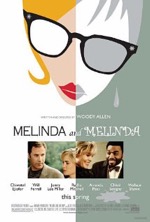
Starring: Will Ferrell
March 2005
“A Tale of Two Fillies”
The seminal master of cinematic high art, Woody Allen, is back, and his unequalled prowess at helming both drama and comedy has come to bear upon the ingenious dramedy, Melinda and Melinda.
The movie opens in a New York café, where two playwright friends are discussing the various virtues of their work…one is adept at crafting comedic scripts, the other excels at plumbing the depths of the human condition in dramatic vignettes. The drama playwright begins telling a story about a young couple hosting a dinner party in their New York flat; as the husband schmoozes a potential employer, a high school friend of the wife’s shows up unannounced. The storyteller’s scene-setting words soon transform into a voice-over as we’re drawn into the actual events of the drama. After that scene plays out, we’re back in the café and the comedic writer spins his own yarn involving similar situations with different people. The one commonality between both narratives is nubile debutante Melinda (Radha Mitchell), a thirty-something free spirit who disrupts the marriages in both stories.
Once both sets of characters are introduced and both plots are established, the remainder of the movie plays out like a vigorous match at Wimbledon—bouncing back and forth between the two stories with no discernable segues and no apologies to those who can’t keep up, the movie could have degenerated into a jumbled mass of faces and places in the hands of a mere mortal, but Allen’s deft direction, along with an engaging storyline and actualized characters, prevents the film from faulting. With Melinda and Melinda, Allen has pioneered a new movie format; it will be interesting to see if this innovative split story technique will inaugurate a new movement in Hollywood or if the complexity of such a plot construct will scare off all but the most daring producers.
There’s no question that Melinda and Melinda boasts superlative directing, but the A-list ensemble of actors is equally impressive. Performances by Chloe Sevigny, Amanda Peet, Jonny Lee Miller and Chiwetel Ejiofor bolster the twin tales, but it’s really Mitchell and Will Ferrell who steal the show. Ferrell demonstrates considerable dramatic range here and has Allen’s vocal cadence and comedic timing down to a science—some scenes are downright frightening when it comes to Ferrell’s ability to emulate the director’s vocal and physical characteristics.
Melinda and Melinda is a fresh approach to filmmaking and is thoroughly entertaining despite its various ménage a trios and sordid trysts. Sustaining interest with focused narrative, crisp dialogue and believable characters, Melinda and Melinda is a refreshing piece of filmic art.
Rating: 3
Robots (PG)
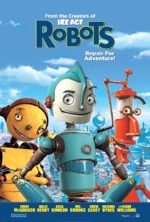
Starring: Ewan McGregor
March 2005
“Serviceable Story That Makes A Lot Out of Junk”
Robots is an astonishing clinic in computer-generated animation, the sleek vision of a fully realized synthetic world. This newest—and seemingly inevitable—iteration in CGI is crisper in its clarity and more vibrant in its palette than anything previously seen in the genre and has, effectively, risen the bar that much higher for Shrek 3 and other future movies of the same ilk. It’s evident that director, Chris Wedge (Ice Age), and crew were on a creative high assembling the nuts and bolts of the story, and though the flick is chock-full of dizzying action sequences, narrow escapes and drops and turns that make you feel like you’re on a roller coaster, the plot consistently lags behind the movie’s runaway pacing.
Rodney Copperbottom (voice of Ewan McGregor) heeds the call of the big city, leaving his parents and rural Rivet City behind to pursue his dreams of becoming an inventor in Robot City. Rodney immediately encounters Fender (Robin Williams, whose repertoire is getting repetitious), a vociferous misfit who falls to pieces any time the story calls for a laugh. Rodney’s first attempt at showing his invention to his boyhood hero, altruistic uber-inventor, Big Weld (Mel Brooks), is nearly disastrous as he narrowly escapes the clutches of greedy egotist, Ratchet (Greg Kinnear). Rodney learns, almost too late, that Ratchet supplanted Big Weld in a recent coup and has launched a campaign to beautify all of robotkind (and make millions in the process). Rodney’s ability to fix broken down robots transforms the small town droid into an urban legend, however, Rodney’s newfound fame poses a serious threat to Ratchet, who plans to destroy every spare part in the city, thereby forcing older models to get an upgrade. The climax pits Rodney and his army of rickety robots against Ratchet and his newer, larger, more powerful battle ‘bots. The ending ceremony is an emotional flourish—warm fuzzies soar like ticker tape—but the ensuing celebration is reminiscent of the one seen in Star Wars: Episode I—The Phantom Menace.
I mention Star Wars, because there are countless tips of the hat to (or blatant rip offs of) Lucas’ space saga, which surface at various times throughout the movie—the downtrodden underdogs marching against the evil overlords brings to mind Episode I and VI’s Gungans and Ewoks, respectively, and even Ratchet’s new robot sweepers look virtually identical to Episode I’s Trade Federation MTTs (battle droid carriers). Aside from Star Wars, Robots owes its metallurgical existence to The Wizard of Oz; motifs and archetypes from the perennial classic run rampant though the picture.
If there’s a rusty side to the seemingly chrome-plated screenplay, it’s the gimmicky manner in which the tale is told—much of the story is programmed with standard gags and slapstick silliness, especially Fender’s shtick. Robots, however, does have a salient moral: the conflict between the outmodes and the upgrades is a new spin on the old topic of intolerance—the devaluing of anyone or anything that doesn’t measure up to an imposed standard. In our nip-tuck, Botox-injected society, Robots reveals an insightful—even insidious—look at our own vanity and a sneak peek at where that brand of narcissism can take us. What a bold statement from an animated movie made in Hollywood!
Robots isn’t as funny as billed, but it’s a diverting romp with memorable characters and a positive message. Now we’ll have to see if there are enough spare parts to make a sequel.
Rating: 2 1/2
Because of Winn Dixie (PG)
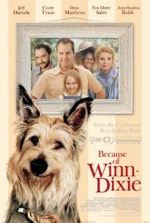
Starring: AnnaSophia Robb
February 2005
“Simple, but Touching Family Film”
A star is born! If you were to look up the word “adorable” in the dictionary, next to the definition would be a picture of AnnaSophia Robb in all of her angelic innocence. As indicated in the title, the movie (based on a Newbery award-winning kid’s book by Kate DiCamillo) is about Winn Dixie, the smiling mutt that exhibits more personality than the average canine, but it’s really Robb’s winsome purity that steals the show.
Robb’s character, India “Opal” Buloni (name change, please!) is introduced to the stray in—of all places—a Winn Dixie market, where the shaggy dog is demolishing end caps while evading capture. Amused by the comical pursuit, Opal, in a snap decision, claims ownership of the dog when it’s finally cornered. Opal’s father, Pastor Buloni (whose sermons are full of it), is less than thrilled when Opal brings the mangy mutt into their trailer. “The Preacher” (Jeff Daniels) ultimately gives in to Opal’s pouting—besides making a face no one could refuse, she plays the, “But I have no friends!” card and wins.
The Buloni’s are new to fictitious Naomi, FL, a sleepy Southern burg complete with a rustic library, a closed-down candy factory and nary a stop light—the preacher’s congregation meets in an old convenience store. Father and daughter tote around sacks filled with sorrow—Opal’s mother left them when she was only three—but Winn Dixie is the catalyst for open communication between the two (the “ten things about mom” scene is endearing and deeply moving).
As Opal explores the new town, she makes friends with the spinster librarian, Miss Franny (played by the ever-charming Eva Marie Saint), who regales glorious stories of the past, and Gloria Dump (Cicily Tyson), a near-blind, recovering alcoholic who teaches Opal how to see others with her heart. She also encounters the stubble-faced drifter, Otis (Dave Matthews, in his big screen debut), the interim manager of a pet shop, who offers Opal a part-time job and plays his guitar to soothe the animals.
There are plenty of funny scenes in the film, like when Winn Dixie recklessly pursues a church mouse, providing the parishioners with more entertainment and joy than any sermon in recent history. However, it’s the subtler moments that have more lasting impact; like the Litmus Lozenge tale or Mrs. Dump’s explanation of the “failure tree” and her admonition to “hold on to love while you have it.” Embedded in the movie’s overarching silliness are themes of forgiveness, hope and the need for community.
What easily could have degenerated into another Beethoven cheese-fest, is actually a funny, feel-good, family film…and it’s all because of Winn Dixie! By the way, isn’t it poor form to start a title with “because”? Woof!
Rating: 2 1/2
Hitch (PG-13)
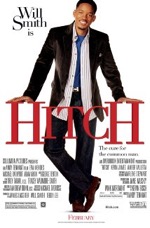
Starring: Will Smith
February 2005
“Educational Love Tale Wastes It’s Time on Silliness”
Alex “Hitch” Hitchens (Will Smith) is a smooth operator—perhaps too smooth for his own good. He has all the insights into the female psyche that elude the common man and knows just what buttons to push to gain a desired response from the fairer gender. Fittingly, his occupation is romance counselor and the movie opens with Hitch accepting a tough assignment—a very stiff suit named Albert Brennaman (Kevin James), who is head-over-heels for affluent and radiant socialite, Allegra Cole (Amber Valletta). To say that Allegra is way out of Albert’s league would be the understatement of the year, but Hitch is equal to the task and immediately begins training the stocky, soft-spoken klutz, who seems to have a perpetual dollop of mustard on his shirt.
All goes according to script until Hitch encounters steamy Sara Melas (Eva Mendes), a gossip columnist who plays hard to get, but ultimately gives in to Hitch’s charms. Sara is a bit of a challenge, though; Hitch’s normal repertoire of flattering phrases and clever lines has little effect when he tries to crack her icy exterior. Their first date is a disaster—Hitch accidentally kicks Sara in the head, unwittingly dredges up an unwanted reminder of her family’s shady past and looses his top shirt when it gets caught in a cab door.
All of a sudden, Allegra is warming up to Albert (despite some minor missteps) and the Date Doctor is struggling just to keep his foot in Sara’s door. This is when the fun begins…the novice is rounding first base, while the master is royally botching what should be an easy conquest. Hitch is faced with the fact that he has no long game and realizes he’s the expert on something he really doesn’t understand. The resolution is a bit standard for a romance film, but humorous situations and solid acting sustain the light-hearted story.
Some of the humor works well (the vehement vegetable toss in Hitch’s apartment and when Albert tosses his inhaler and plants one on Allegra), but some of it is so unrealistic that it belongs in a slapstick comedy (the food allergy sequence is sophomoric and brings to mind a swollen-faced Martin Short in Pure Luck). Smith and James have great screen chemistry and play the “dancing” and “kissing” role-playing vignettes extremely well. Mendes’ character comes close to being fully realized, but her screen boss (Adam Arkin) is little more than set dressing.
In the end, Albert does everything wrong and still wins over Allegra and Hitch learns that there are no clear-cut rules when it comes to relationships. One wonders if there will be a sequel, and if so, will Sara and Alex get Hitched?
Rating: 2 1/2
Hotel Rwanda (PG-13)
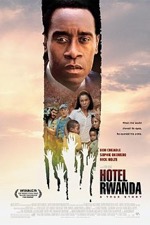
Starring: Don Cheadle
February 2005
“Emotionally Fraught Survey of Modern Tragedy”
Hotel Rwanda easily could have fallen into the mold of other pseudo-documentaries, but two factors alleviate this creative threat. First, the story is accessible because it focuses on a man, his family and many others his life touches. Second, the story revolves around one place—the hotel is the focal point of the story, and even though characters come and go, the genocide is seen through the lens of the hotel and the activity that swirls around and through it. We catch glimpses of the atrocities that were committed by the rebel army (the scene with bodies strewn on the road is particularly haunting), but these tableaus are neither sensationalized nor sanitized and hermetically sealed in a documentary vault.
Don Cheadle, in his inspired portrayal of everyman-turned-hero, Paul Rusesabagina, expertly draws the audience into the story—we’re transported right into the middle of the turbulent events—via his truly captivating performance. It was just a month ago that I saw the actor portraying a British-speaking thief in Ocean’s 12, and I can’t help thinking to myself, “What an amazing range!” Other actors could have filled the role, but Cheadle imbues the reluctant hotel manager with the perfect blend of courage, compassion, conviction and command as he evades, bribes and deceives the rebel guards in order to save 1,200 refugees.
Sophie Okonedo is marvelous in her supporting role as Paul’s wife, Tatiana, and Nick Nolte turns in one of his finest performances in recent years as beleaguered U.N. Colonel Oliver, a man who sympathizes with Paul’s plight but has his hands tied behind his back by the bureaucracy. Though his presence is barely felt in the movie, the American cameraman, played by Joaquin Phoenix, has the most memorable line in the film: when asked by an enthusiastic Paul if images of the heinous murders will goad America and other countries into sending additional aid, the cameraman bitterly replies that most Americans would say, “‘Oh my God, that’s horrible,’ and go on eating their dinners.”
Some, undoubtedly, will see this somber indictment as a stilted sermon, but the facts speak for themselves: the 1994 genocide in Rwanda resulted in the slaughter of a staggering one million people. The conflict between the ruling Hutu’s and rebel Tutsi’s went largely unnoticed by the rest of the world and aid from U.N. peacekeeping forces was woefully inadequate. Whether viewed as a political platform or not, Hotel Rwanda has finally brought the events of this modern tragedy into the mainstream media, and the fact that it also entertains is so much the better.
Rating: 3 1/2
Million Dollar Baby (PG-13)
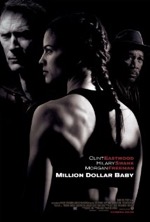
Starring: Hilary Swank
January 2005
“Exceptional Cinema with Powerful, Emotional Punch”
Million Dollar Baby is triumphant in its delivery, masterful in its subtlety, exceptional in its artistry and potent in its poignancy. At the sake of sounding cliché, Million Dollar Baby lands all of its punches, and just like in a real-life fight, it’s the ones you don’t see coming that impact you the most. I have to admit, I didn’t see the movie’s major twist coming, nor did I expect the gut-wrenching ramifications of that event to affect me so deeply. The buzz on the street is that Million Dollar Baby has a controversial climax, and while that may be very true, it’s impossible to walk away from the theater without being emotionally impacted, one way or the other. Like a ghost image of the soul, the movie’s haunting dénouement leaves you with brutally introspective questions such as, “what would I have done in the same situation?”
Clint Eastwood, clearly a grand master of his craft, is pitch perfect as both actor and director—there’s no doubt that he’s still in his prime or that he’ll be contending for several Oscars this spring. Eastwood’s curmudgeonly boxing trainer, Frankie Dunn, is a marvelous character; Frankie’s rough exterior is like a suit of armor, but the chink is his tender spot for Maggie Fitzgerald (Hilary Swank), a struggling young waitress who insists on calling him “boss” and hangs around the run-down gym until Frankie gives in and finally agrees to manage her. Frankie’s assistant is former boxing legend, Eddie “Scrap-Iron” Dupris (Morgan Freeman at the top of his form), the man who looks after the gym with his one good eye and helps out hard luck cases, like Maggie, with quiet dignity.
There’s a wonderful scene where Frankie gives Eddie a hard time about his “holey” socks. The scene, by itself, is superfluous, but it’s this attention to creating three-dimensional characters that elevates Million Dollar Baby above the myriads of shallow scripts that have deluged Hollywood in recent years. Since the movie actually takes the time to invest in character development, the payoff is much greater than if they had settled for the standard, cursory attempt to give the audience a passing familiarity with the characters or to simply gloss over the whole works with snazzy special effects.
Million Dollar Baby is the story of a determined young woman with an unwavering desire to fulfill a dream, and the grim reality that life can drastically and tragically change in an instant. It’s the touching tale of a young woman who never really had a father and a man who comes to love that woman as his own daughter. There’s a million reasons why the movie is a brilliant example of high art, and at least a billion reasons why Million Dollar Baby should be the screen champion this year.
Rating: 3 1/2
In Good Company (PG-13)

Starring: Dennis Quaid
January 2005
“Lighthearted Dramedy is Good, But Not Great”
The changing face of corporate America! That pretty much sums up the plot to In Good Company. Oh, and never date the daughter of a man you just demoted.
Neither an all-out comedy, nor a full-on drama, In Good Company won’t be mistaken as a barnburner, but it certainly isn’t a bad way to spend two hours. Dennis Quaid plays Dan Foreman, veteran ad man at Sports America magazine; husband to Ann (Marg Helgenberger) and father to Alex (Scarlett Johansson). The company that owns the periodical is sold to a rival corporation and callow upstart, Carter Duryea (Topher Grace) is sent to head up the advertising department where he promptly supplants Dan and fires half the staff.
Carter relies heavily upon Dan, his “wing man,” for marketing advice, because he’s way out of his depth: the only thing Carter knows how to do is talk—his improvised motivational speeches and ad hoc solutions get him out of one jam after the next. Being a quick thinker and fast talker has always gotten him by in the past, but Carter quickly realizes he’s a sham; his recent divorce from his wife (Selma Blair) makes that painfully obvious (now he sleeps on a couch at work). After his promotion, Carter buys Porsche, but gets in an accident the moment he drives it off the lot (he doesn’t even know how to use a stick shift), presenting the image of a man so driven by the need to succeed that he’s never taken the time to learn anything on the way up.
A word that pops up a lot in the movie is “synergy,” and while the film’s pacing often lacks it, the incisive commentary on the capricious nature of the business world is amusing and didactic. Revered financial maven, Teddy K. (Malcolm McDowell), delivers a sermon on synergy at a staff meeting and uses an array of high-sounding words to mesmerize a pack of “yes men” at the office, but Dan isn’t bamboozled and stands up to the blathering businessman. This risky move results in Dan getting his old job back and Carter and his cronies getting fired. Though his failed relationship with Alex provides him with some clarity, it’s Dan’s firm hand (and right cross) of guidance that brings Carter to a place of self-discovery. In the end, poetic justice is served—the young man so bent on getting ahead in life, ends up with nothing.
Morality lesson aside, the movie has some great character moments—like when Dan and Carter first meet and compare ages, or when Carter invites himself over for dinner. However, for some inexplicable reason, In Good Company never fully realizes its potential, despite excellent performances and a decent storyline. Like it claims in the title, the movie isn’t great, nor is it poor—it’s simply “good.”
Rating: 2 1/2
Coach Carter (PG-13)

Starring: Samuel L. Jackson
January 2005
“Inspiring, but Derivative Hoop Tale”
Call it “Hoosiers in the Hood,” Coach Carter is based on the true story of an extraordinary Southern California basketball coach who inspired his players to greatness on the court and in the classroom. Ken Carter’s (Samuel L. Jackson) hard-nosed style of coaching landed him in hot water with parents and the school board at Richmond High: his players had previously signed an agreement that they would maintain a 2.3 GPA, but when they failed to uphold their end of the bargain, Carter locked the gym, effectively forfeiting several games. Due to Carter’s radical measures, the story gained national attention in 1999 and is now presented by director, Thomas Carter, and MTV Films.
The facts are staggering: only 50% of the student body at Richmond graduate, and of those students, only 6% go on to college. Coach Carter is quick to quote these statistics to his players—a bitter reality pill that jolts them into hitting the books. But academic reformation proves a challenge for many of the players, especially those with sordid pasts or turbulent family situations.
Take laconic Kenyon (Rob Brown) for instance; his life takes an unexpected turn when his girlfriend reveals she’s pregnant with his child. With his dreams of playing college ball hanging in the balance, his girlfriend makes a drastic, and life-altering, decision. This subplot is poignant and controversial, but also severely underdeveloped.
The movie’s tragic figure is Timo Cruz (Rick Gonzalez), a talented player whose involvement with drugs and gangs haunts him with every step—even after he determines to clean up his act. A tragic street shooting sends the frightened youth back to Coach Carter and the team, but there is a price for rejoining the squad…1,000 push-ups, which Cruz must complete by Friday night in order to play in the game. In the movie’s most touching scene, Cruz’ teammates pitch in and help the wayward player meet his quota, a teambuilding exercise secretly engineered by Carter.
Though the drills and strategies used by Carter mirror those employed by other coaches from a dozen other sports movies, Carter’s unswerving devotion to developing student athletes is still a refreshingly admirable aspect of the story. His formations, named after his seemingly endless supply of sisters, add levity to the movie’s dark moments, which unflinchingly display the grim reality of life on the streets.
Carter’s rousing speech before the big game is a definite high point, but it’s the movie’s unconventional ending that really stands out as “something different.” The rap/hip-hop soundtrack adds another level of gritty realism to the movie’s urban aesthetic. Coach Carter scores big with memorable performances and an edifying true story: it’s a winner despite missing a few free throws.
Rating: 2 1/2